RESOURCES
Dive deeper into the world of RF with our selection of white papers, webinars, videos, product brochures, and data sheets.
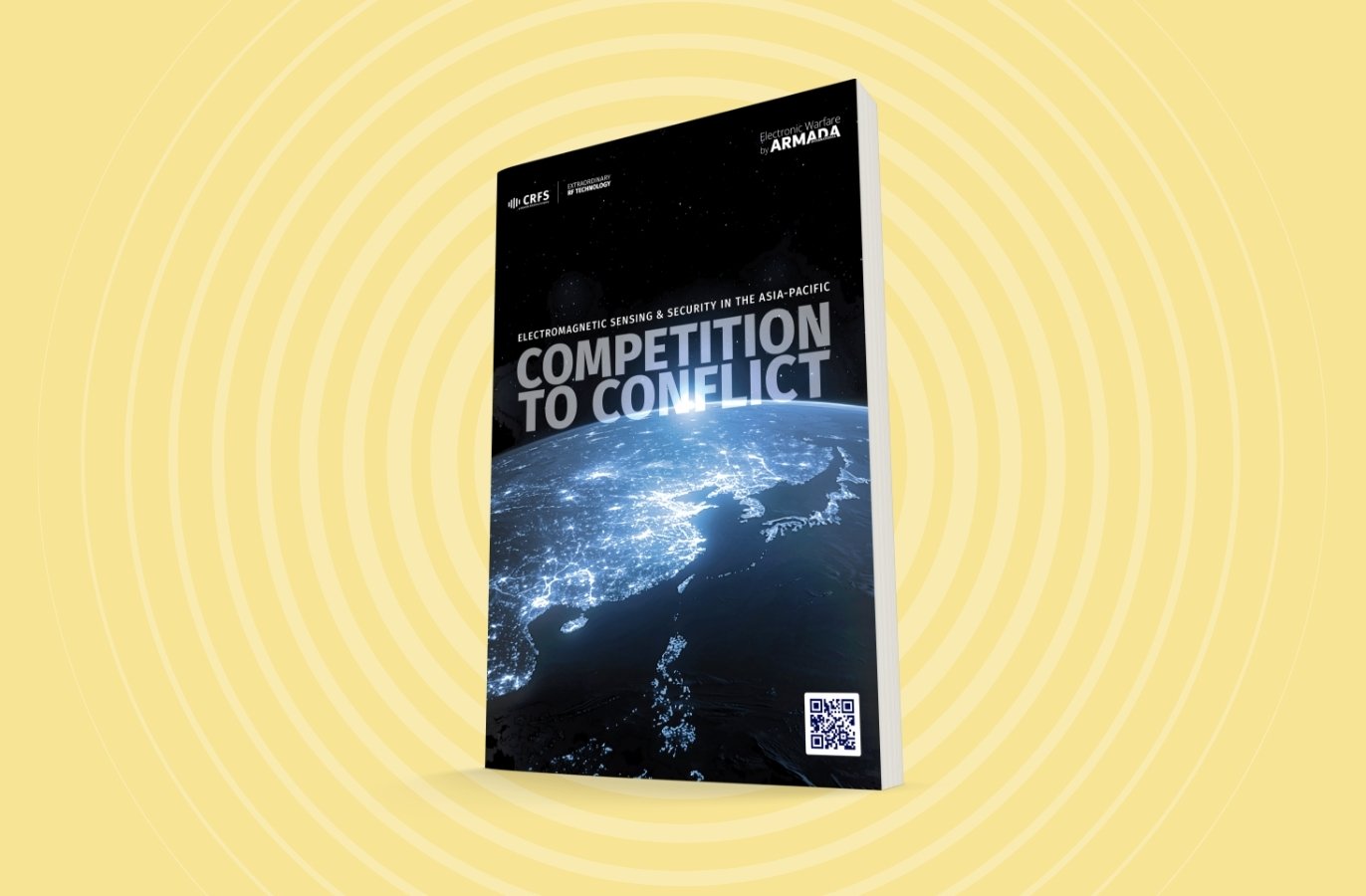 White papers & reports
White papers & reports
Competition to conflict
The Asia-Pacific is the frontline between competition & conflict. Grey-zone tactics, increased militarization, and border
disputes are reshaping the region’s security landscape. Dr Thomas Withington’s special report examines how electromagnetic sensing can strengthen deterrence, enhance situational awareness, and prevent escalation.
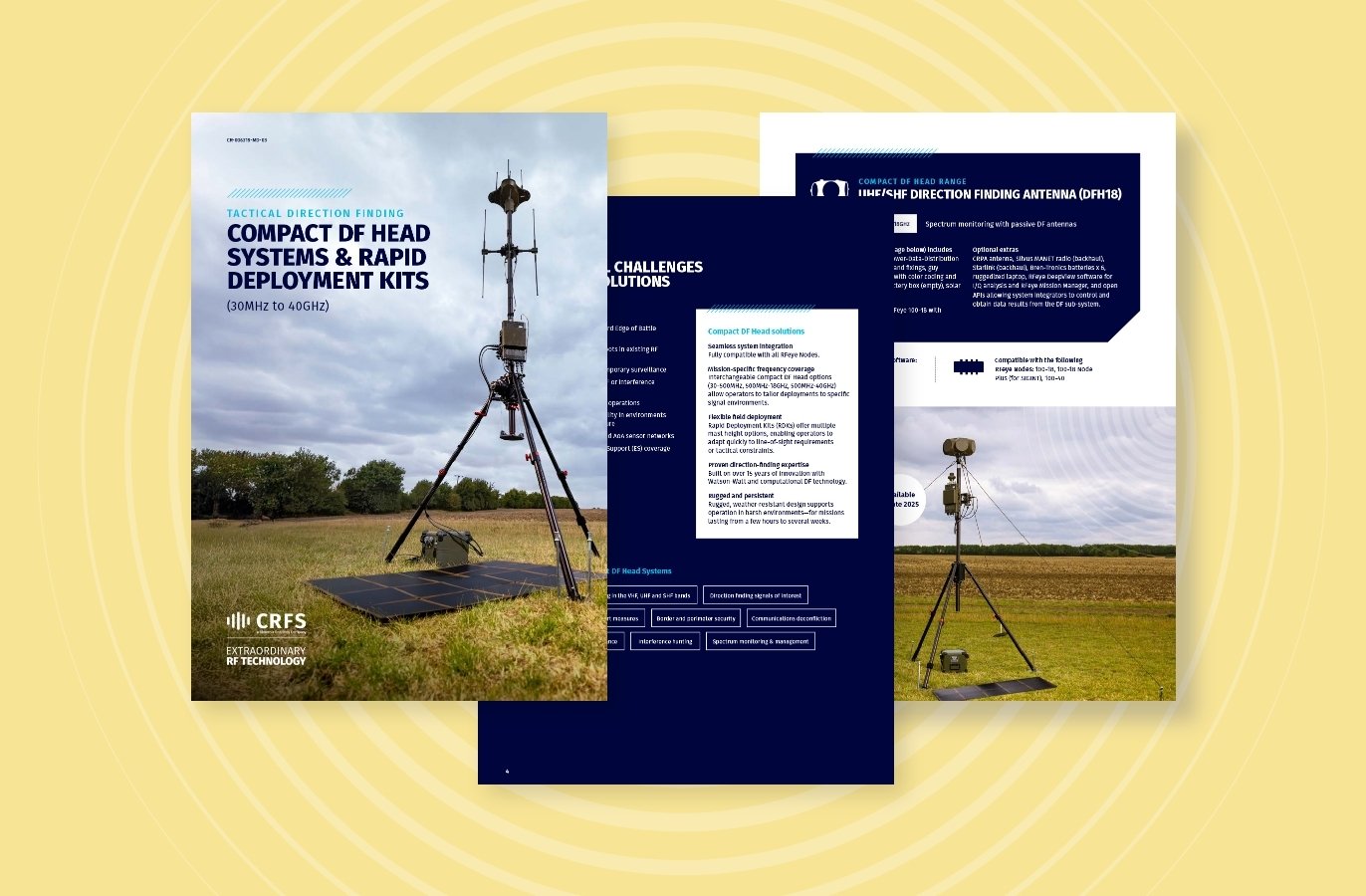 Brochures, Guides & Survey's
Brochures, Guides & Survey's
Compact DF Head Systems & Rapid Deployment Kits
CRFS’ Compact Direction Finding (DF) Heads are lightweight, modular systems designed for spectrum monitoring, SIGINT, COMINT, and ESM operations. They are fully interoperable with CRFS’ V-Track vehicle solution, can be deployed as part of heterogeneous distributed sensor networks, and support missions ranging from signal detection and interception to precise geolocation and intelligence gathering.
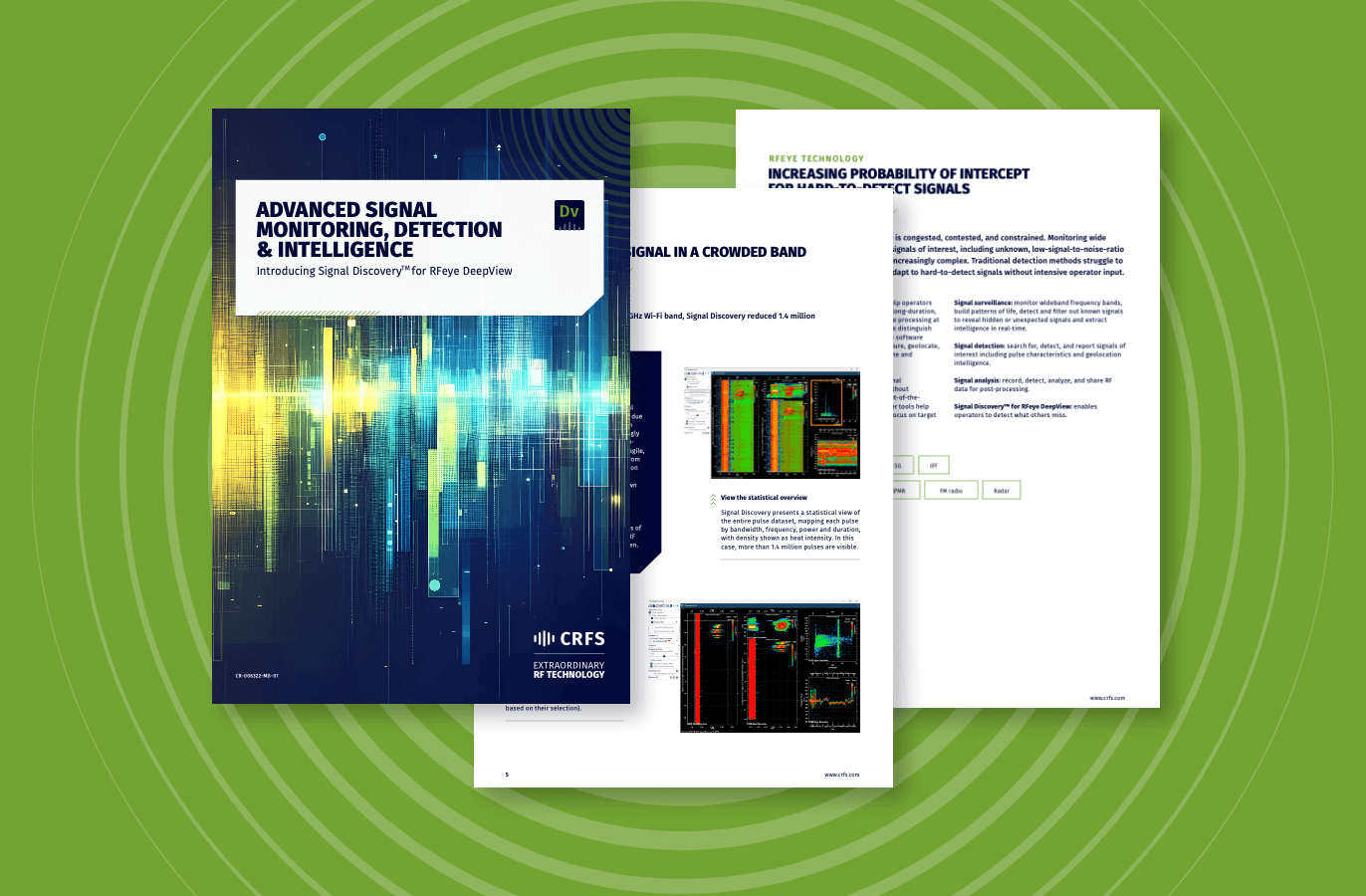 Brochures, Guides & Survey's
Brochures, Guides & Survey's
Advanced signal monitoring, detection & intelligence
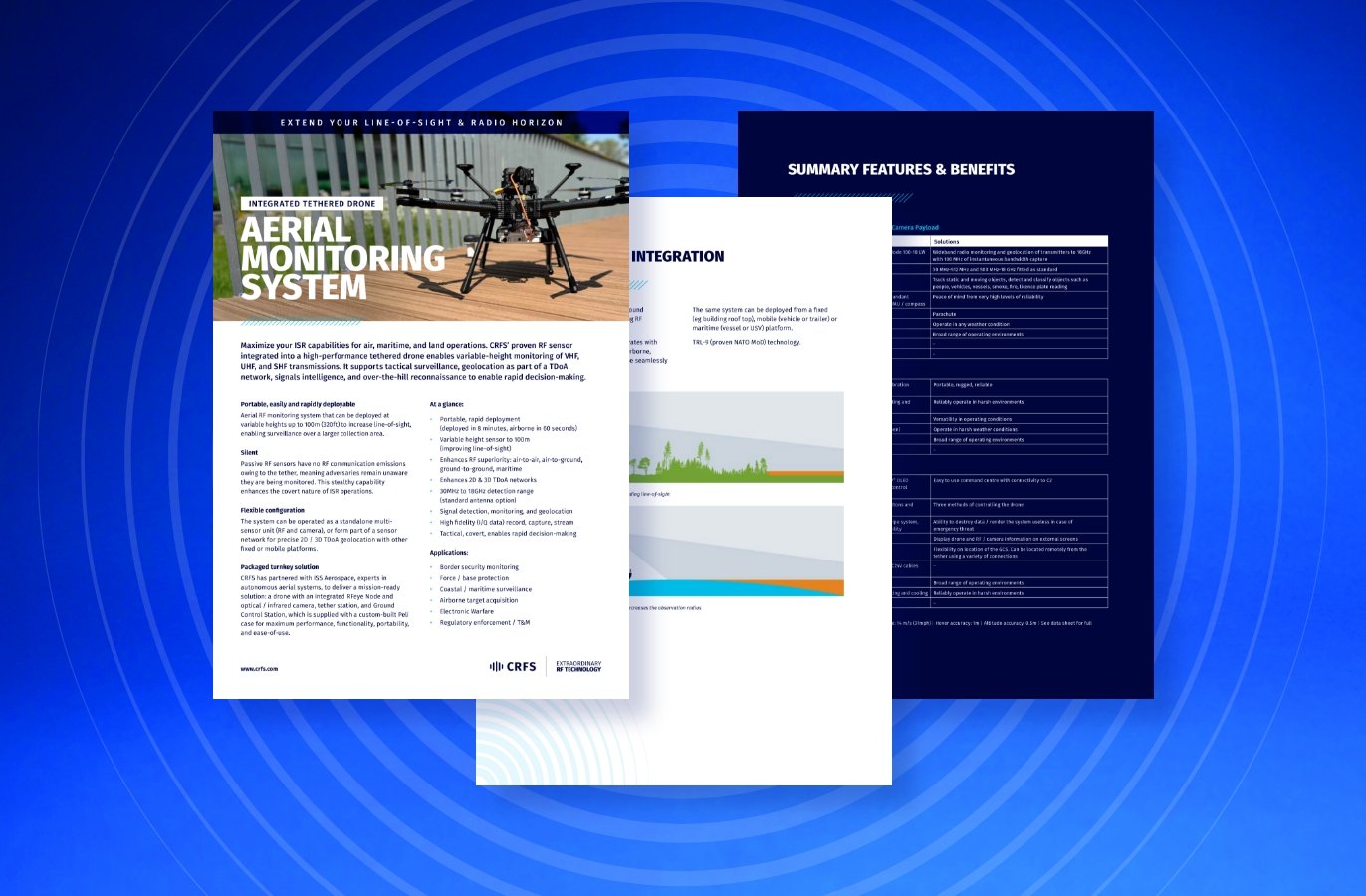 Brochures, Guides & Survey's
Brochures, Guides & Survey's
Integrated Tethered Drone Aerial Monitoring System
Maximize your ISR capabilities for air, maritime, and land operations. CRFS’ proven RF sensor integrated into a high-performance tethered drone enables variable-height monitoring of VHF, UHF, and SHF transmissions. It supports tactical surveillance, geolocation as part of a TDoA network, signals intelligence, and over-the-hill reconnaissance to enable rapid decision-making.
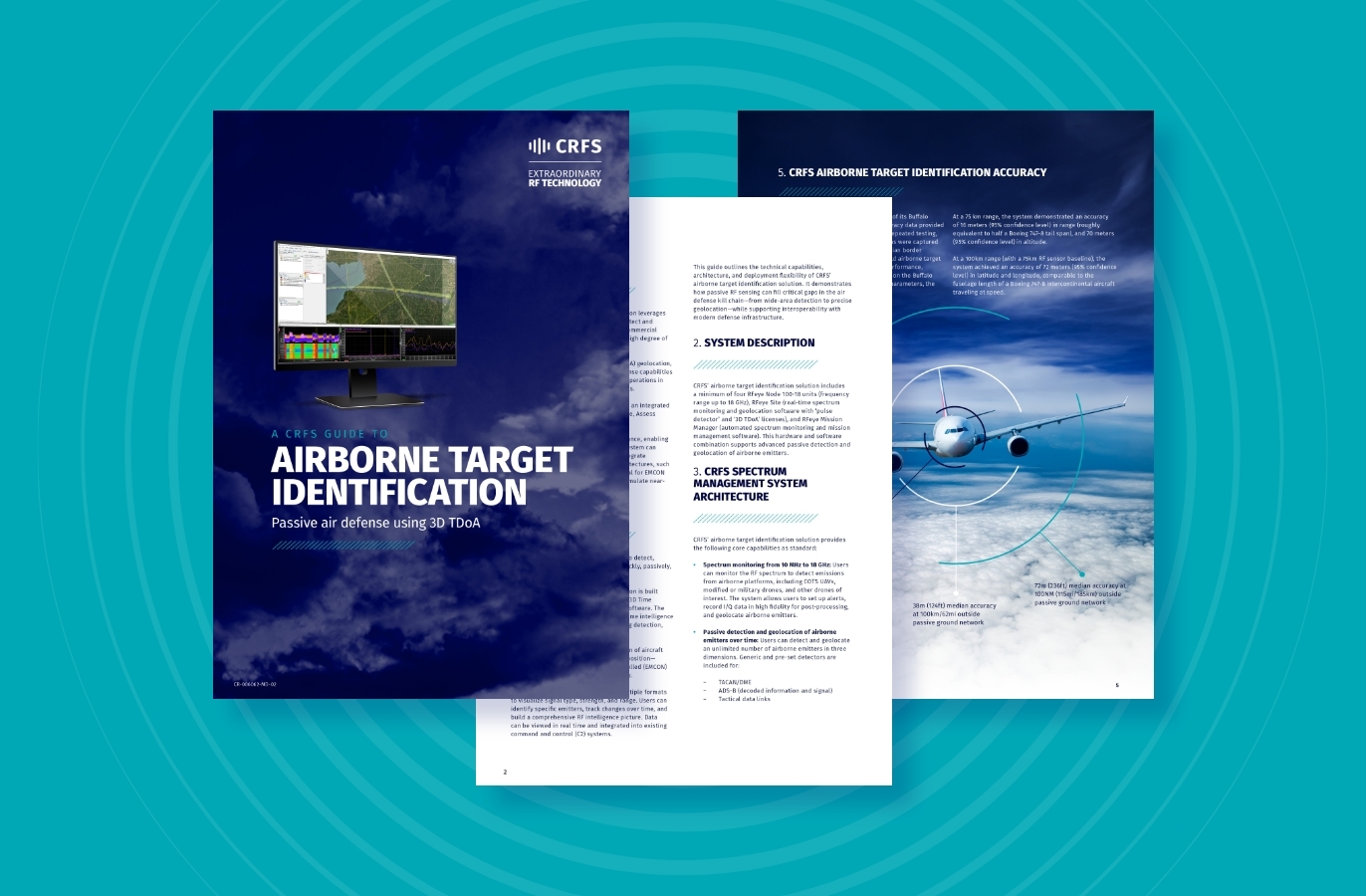 Brochures, Guides & Survey's
Brochures, Guides & Survey's
A CRFS guide to Airborne target identification
This guide outlines the technical capabilities, architecture, and deployment flexibility of CRFS’ airborne target identification solution. It demonstrates how passive RF sensing can fill critical gaps in the air defense kill chain—from wide-area detection to precise geolocation—while supporting interoperability with modern defense infrastructure.
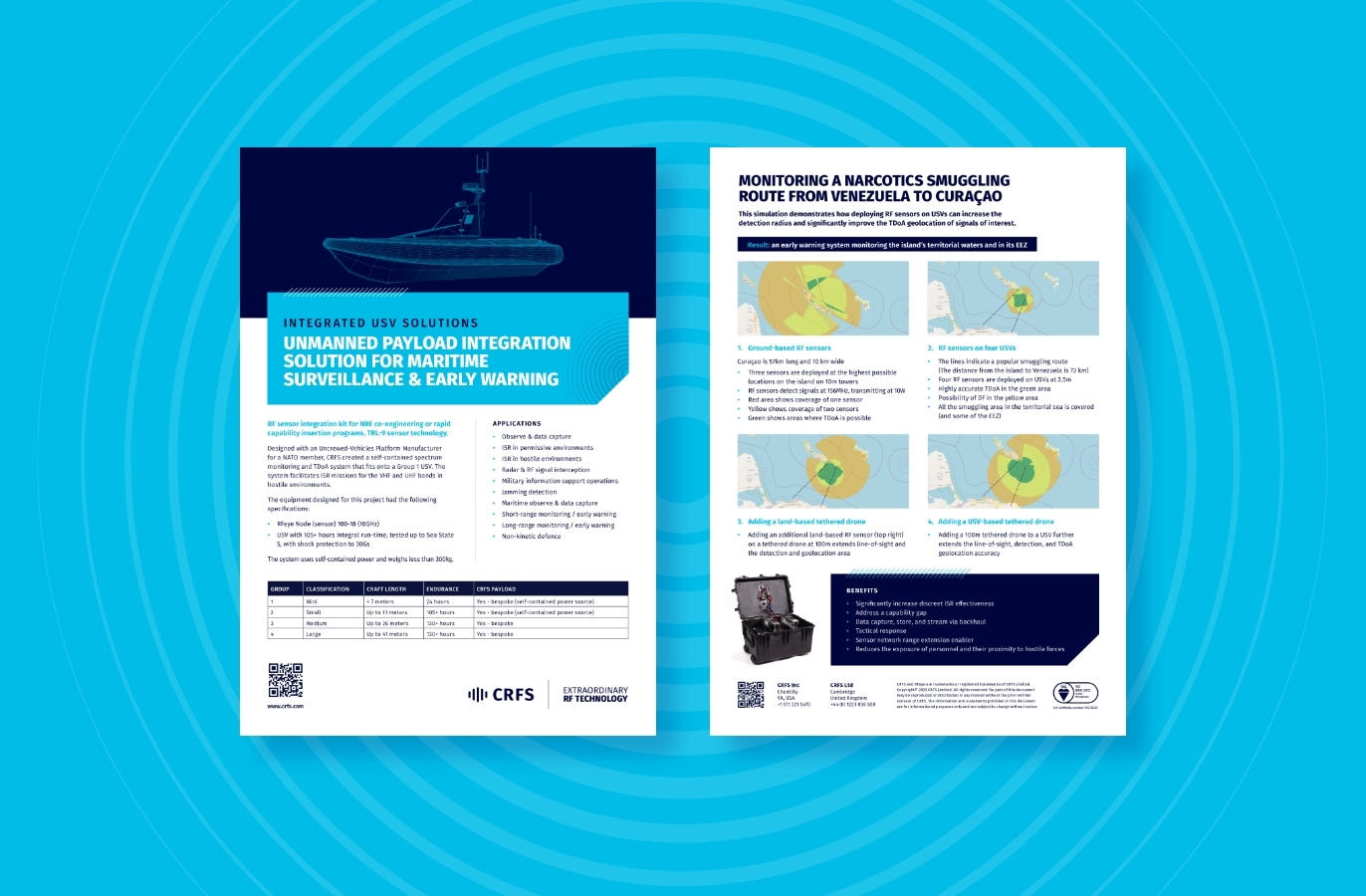 Brochures, Guides & Survey's
Brochures, Guides & Survey's
Integrated USV solutions
Designed with an Uncrewed-Vehicles Platform Manufacturer for a NATO member, CRFS created a self-contained spectrum monitoring and TDoA system that fits onto a Group 1 USV. The system facilitates ISR missions for the VHF and UHF bands in hostile environments.
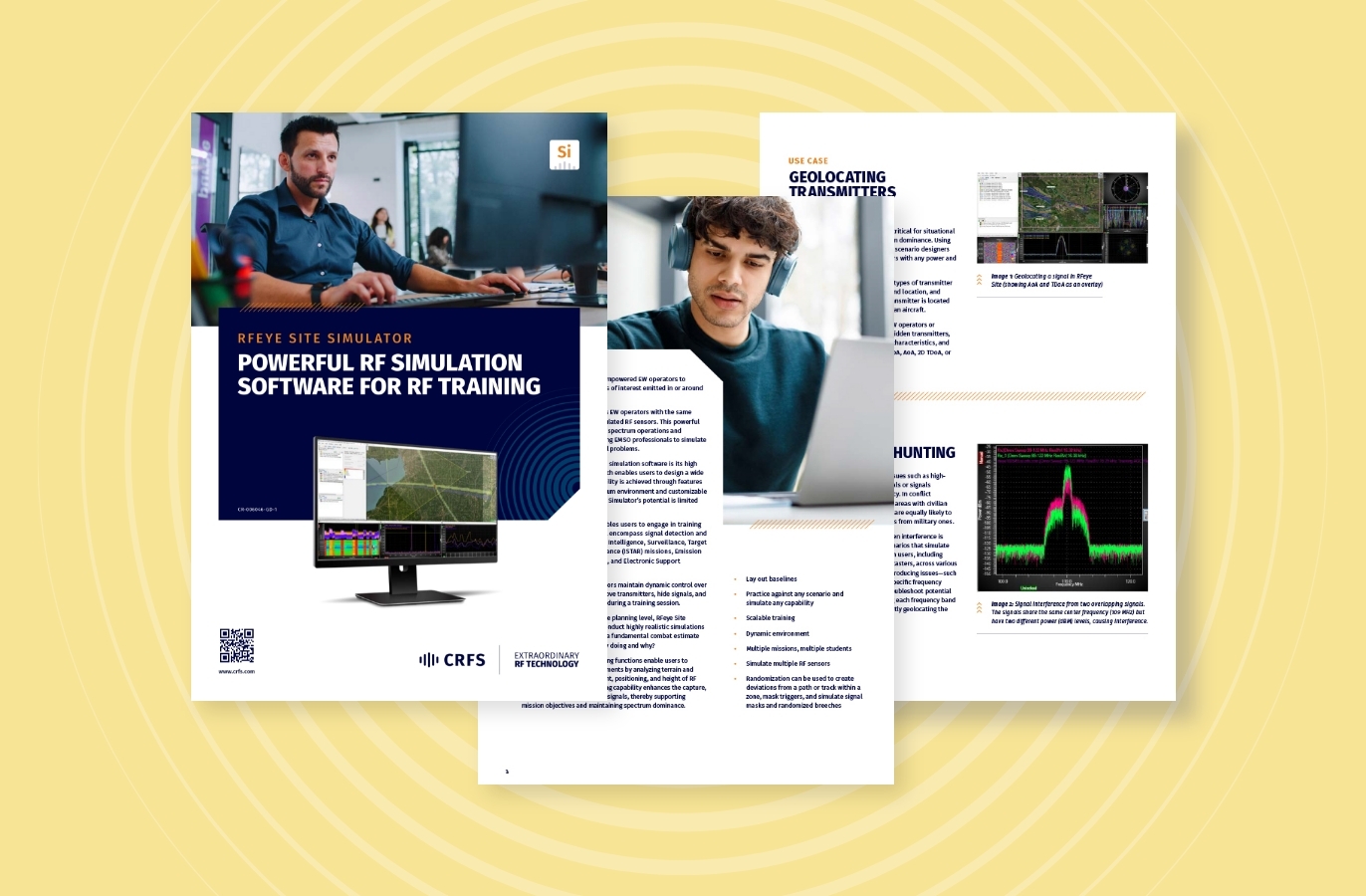 Brochures, Guides & Survey's
Brochures, Guides & Survey's
RF simulation software for RF training
RFeye Site has traditionally empowered spectrum managers to identify and geolocate signals of interest emitted in or around an RFeye Node network. RFeye Site Simulator provides experienced and trainee spectrum managers with the same capabilities but employs simulated RF sensors. By simulating real-world scenarios, this powerful tool can be used for interference hunting, strategic planning, and spectrum allocation.
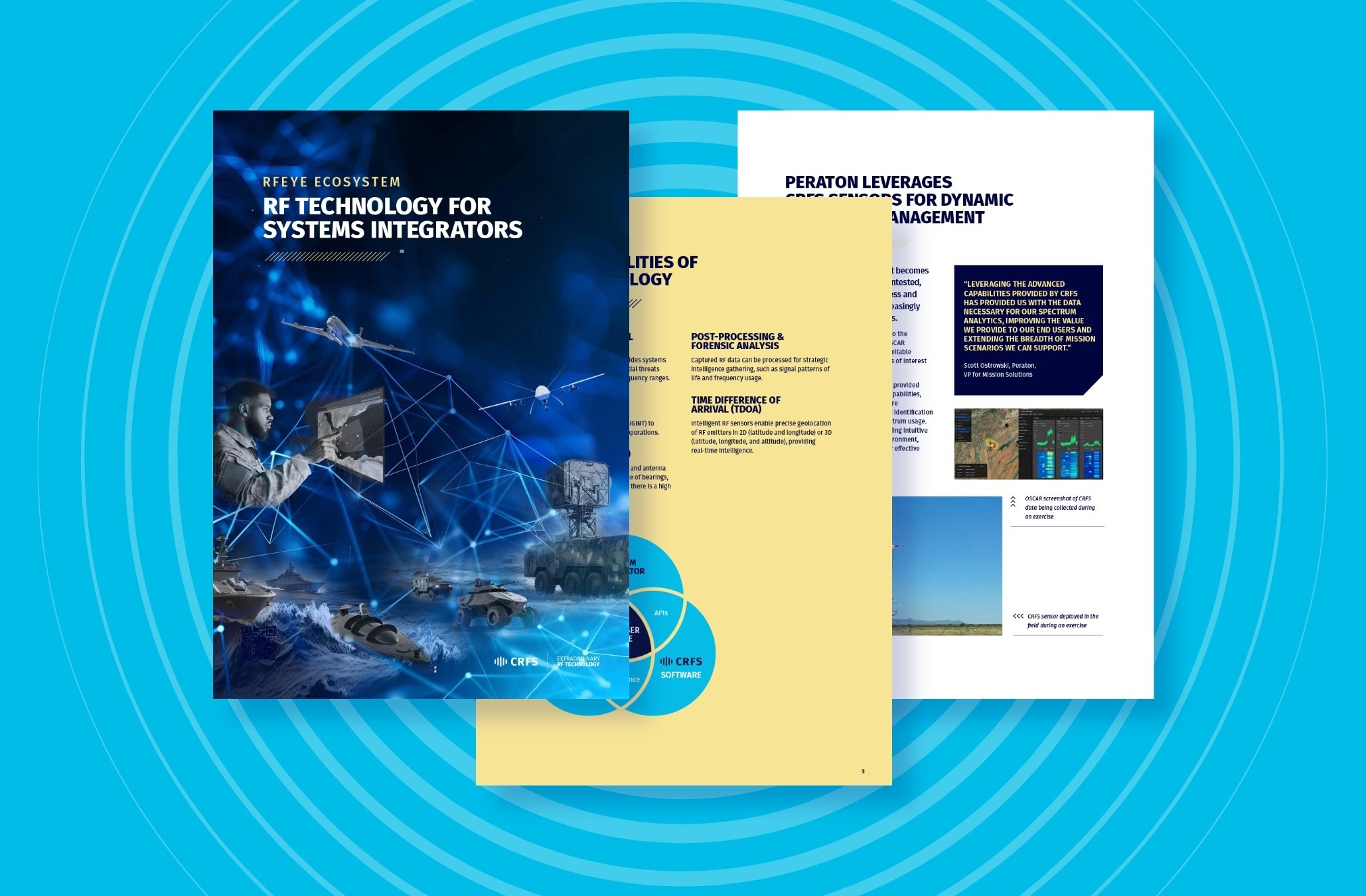 Brochures, Guides & Survey's
Brochures, Guides & Survey's
RF technology for defense companies and system integrators
Our globally recognized sensor (RFeye Node) technology, software and APIs are designed to help you unlock and interconnect the EMCON, COMINT, SIGINT and ISR programs vitally important to you for enhanced awareness and improved decision-making.
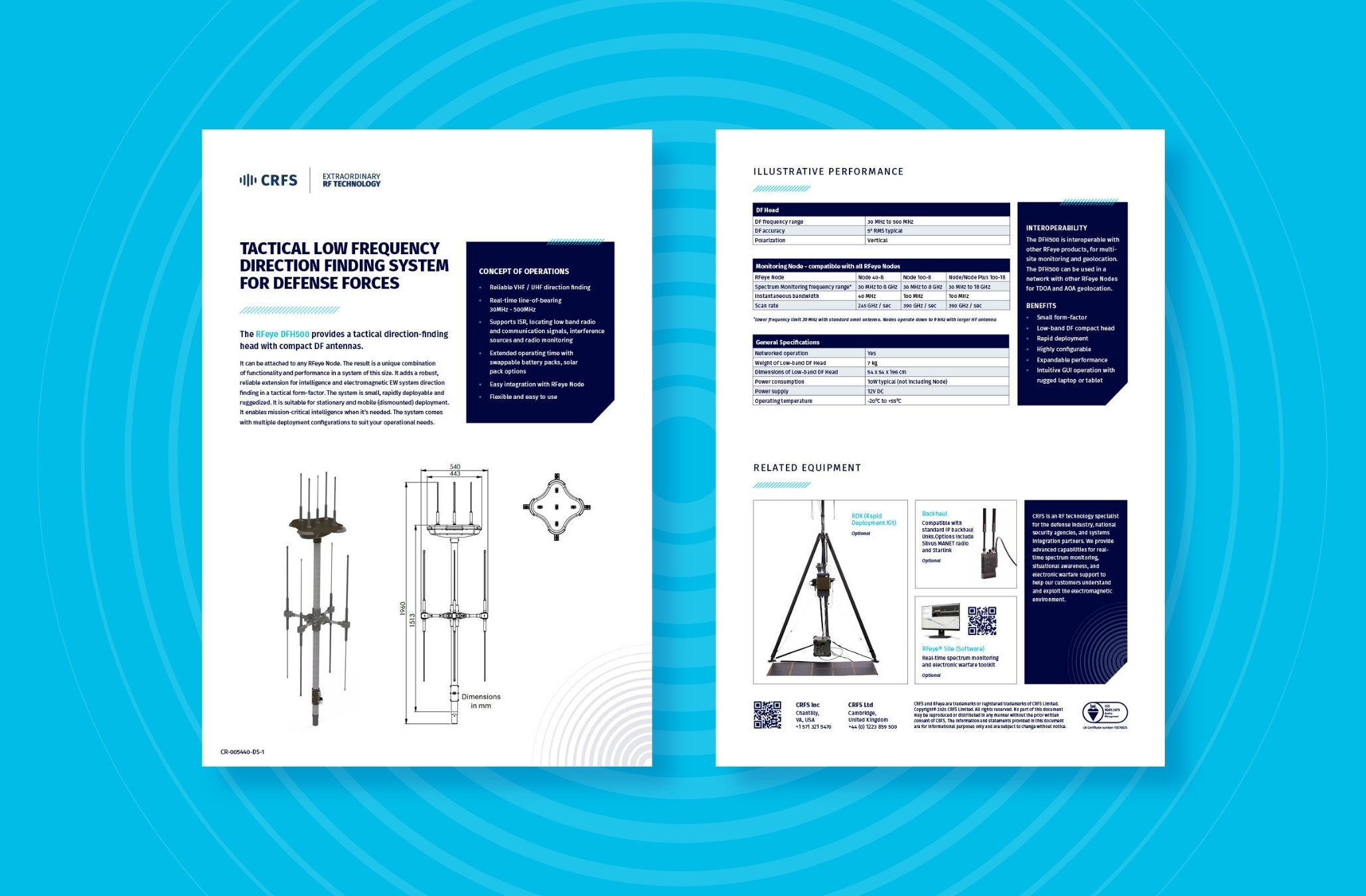 Data sheet
Data sheet
RFeye DFH500 - Tactical direction-finding head with compact DF antennas
A robust, reliable extension for intelligence and electromagnetic EW system direction finding in a tactical form-factor. The system is small, rapidly deployable and ruggedized. It is suitable for stationary and mobile (dismounted) deployment.
.jpg) Brochures, Guides & Survey's
Brochures, Guides & Survey's
RFeye Node Overview
Discover our advanced superheterodyne RF technology for superior sensitivity, frequency stability, and selectivity. Compare Node specifications, view the new RFeye Node models, and discover what makes them unique.
.jpg) Brochures, Guides & Survey's
Brochures, Guides & Survey's
RFeye Array Overview
Ultra wide frequency, high performance radio direction finding up to 40 GHz.
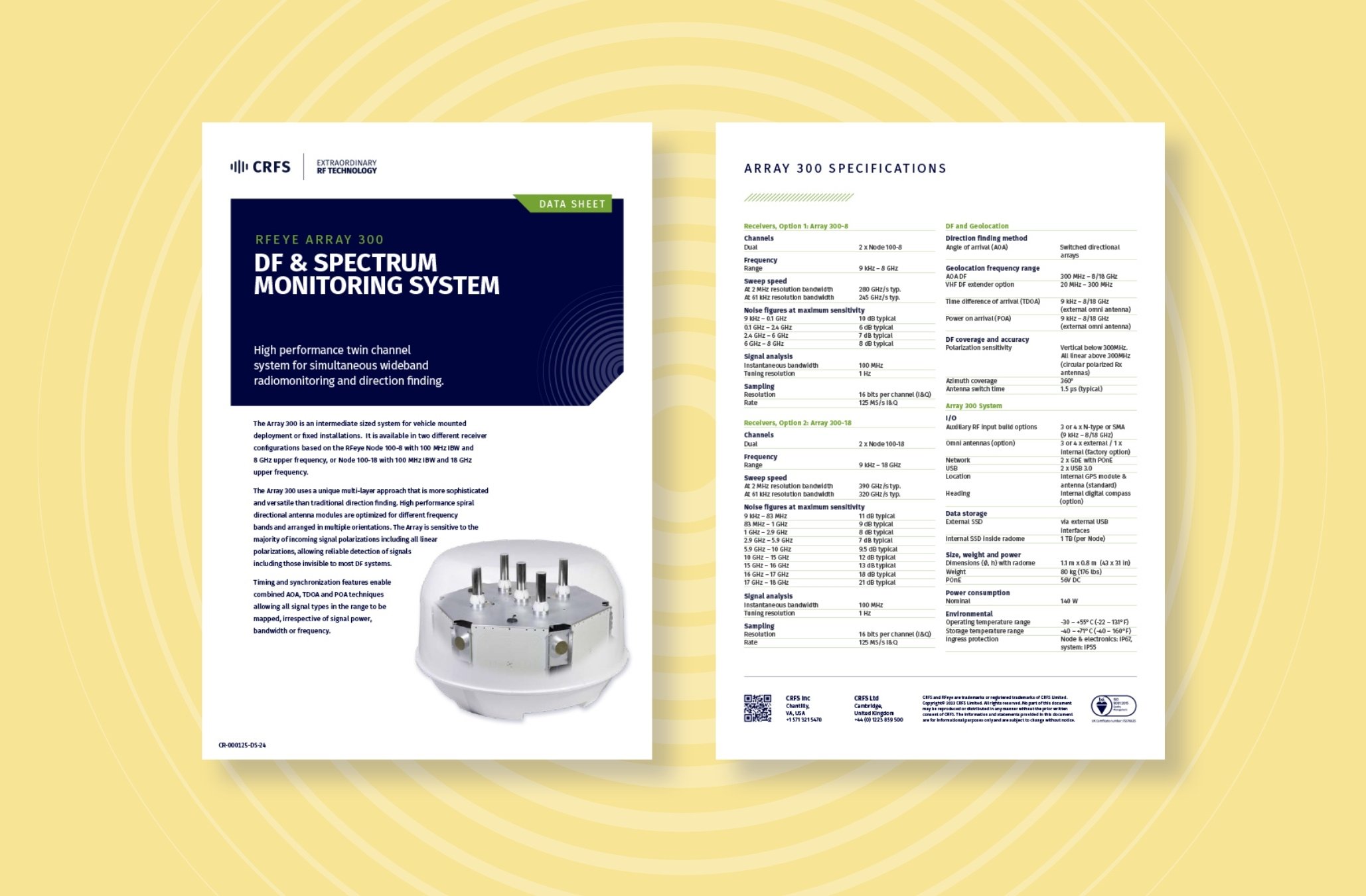 Data sheet
Data sheet
RFeye Array 300
High performance twin channel system for simultaneous wideband radiomonitoring and direction finding.
 Brochures, Guides & Survey's
Brochures, Guides & Survey's
Digital twins for radio spectrum
 White papers & reports
White papers & reports
Keeping airports safe
This guide explores critical strategies for identifying and managing these risks, including RF interference detection, VHF and ILS compliance, GNSS jamming countermeasures, and advanced drone detection methods.
 White papers & reports
White papers & reports
Augmenting port protection & security in territorial waters
This white paper discusses how adding RF technology to existing port security measures can help augment port protection and security.
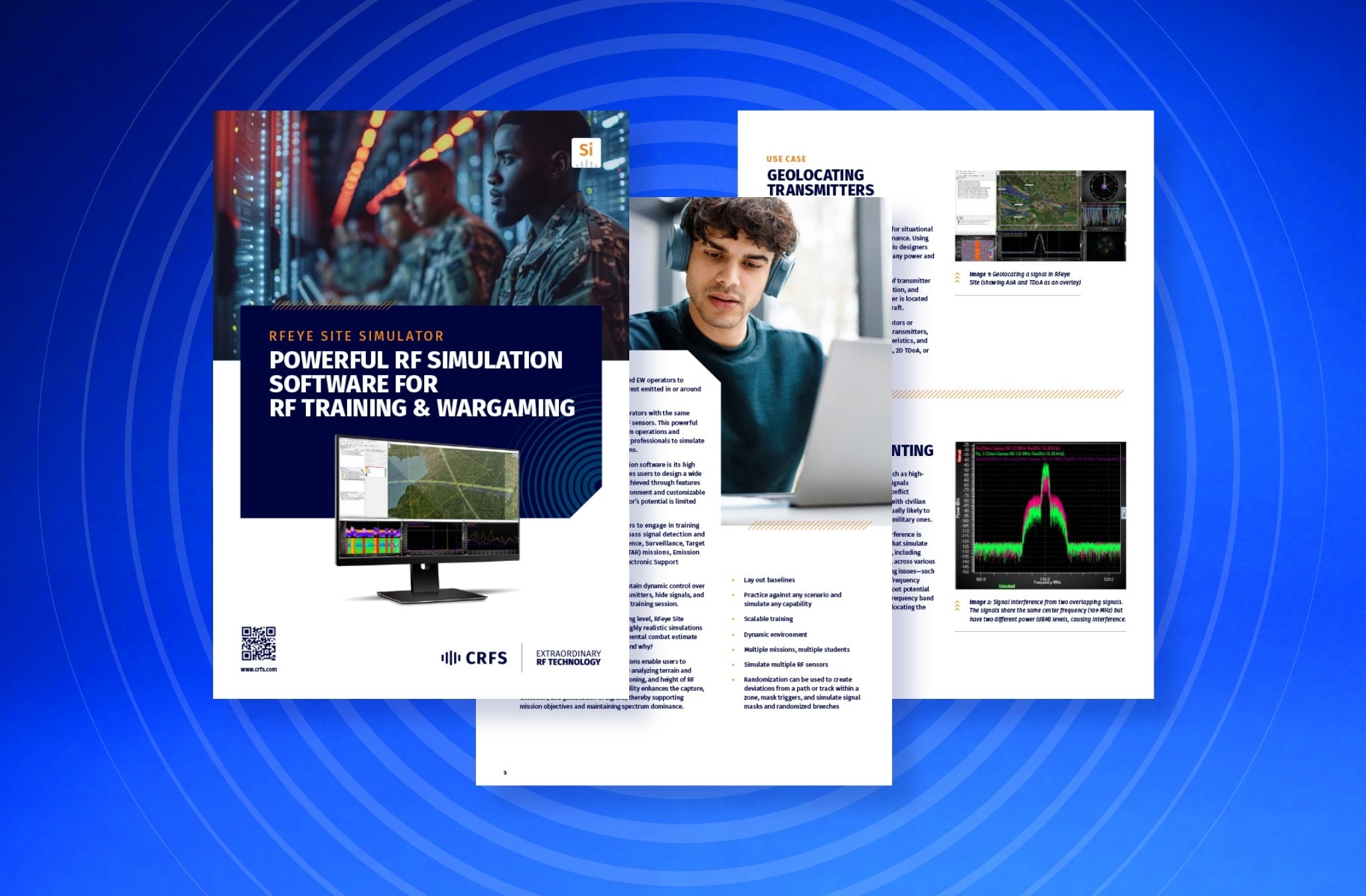 Brochures, Guides & Survey's
Brochures, Guides & Survey's
RF simulation software for RF training & wargaming
RFeye Site Simulator provides EW operators with simulated RF sensors. This powerful tool can be used for teaching spectrum operations and conducting wargames, allowing EMSO professionals to simulate scenarios and resolve tactical problems.
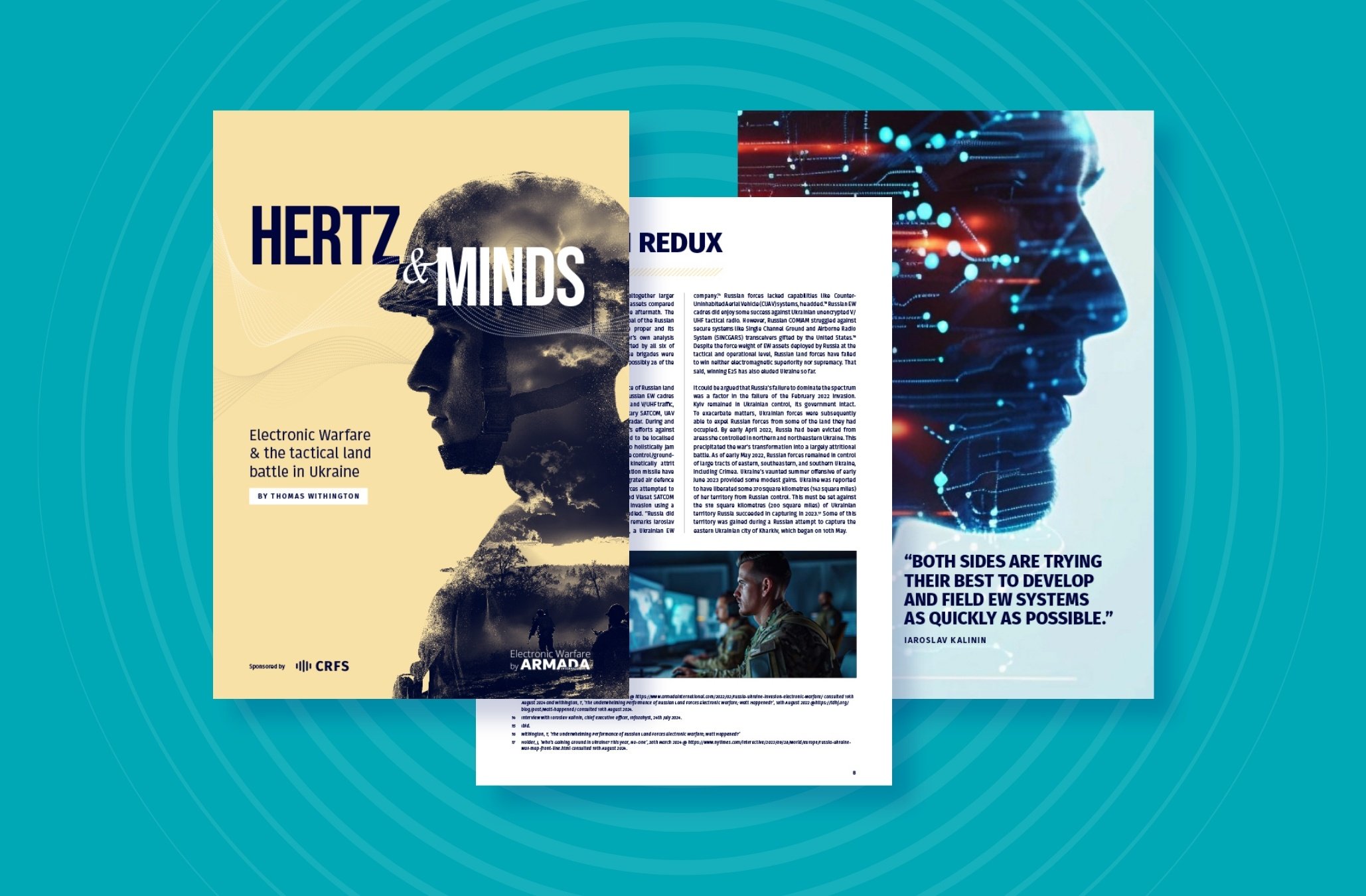 White papers & reports
White papers & reports
Hertz & Minds: Electronic Warfare & the tactical land battle in Ukraine
Dr Withington’s in-depth analysis highlights essential lessons from the conflict for future warfare. NATO forces can no longer assume spectrum dominance and will likely depend on passive, networked, unattended sensors across the battlefield.
 Brochures, Guides & Survey's
Brochures, Guides & Survey's
Strengthening ISR capabilities with RF sensor payloads in unmanned aerial vehicles
Learn why RF sensors provide significant advantages for UAV ISR missions, enhancing intelligence, surveillance, and reconnaissance capabilities. Discover EW & ISR lightweight RF sensor payload technology and overcome engineering challenges.
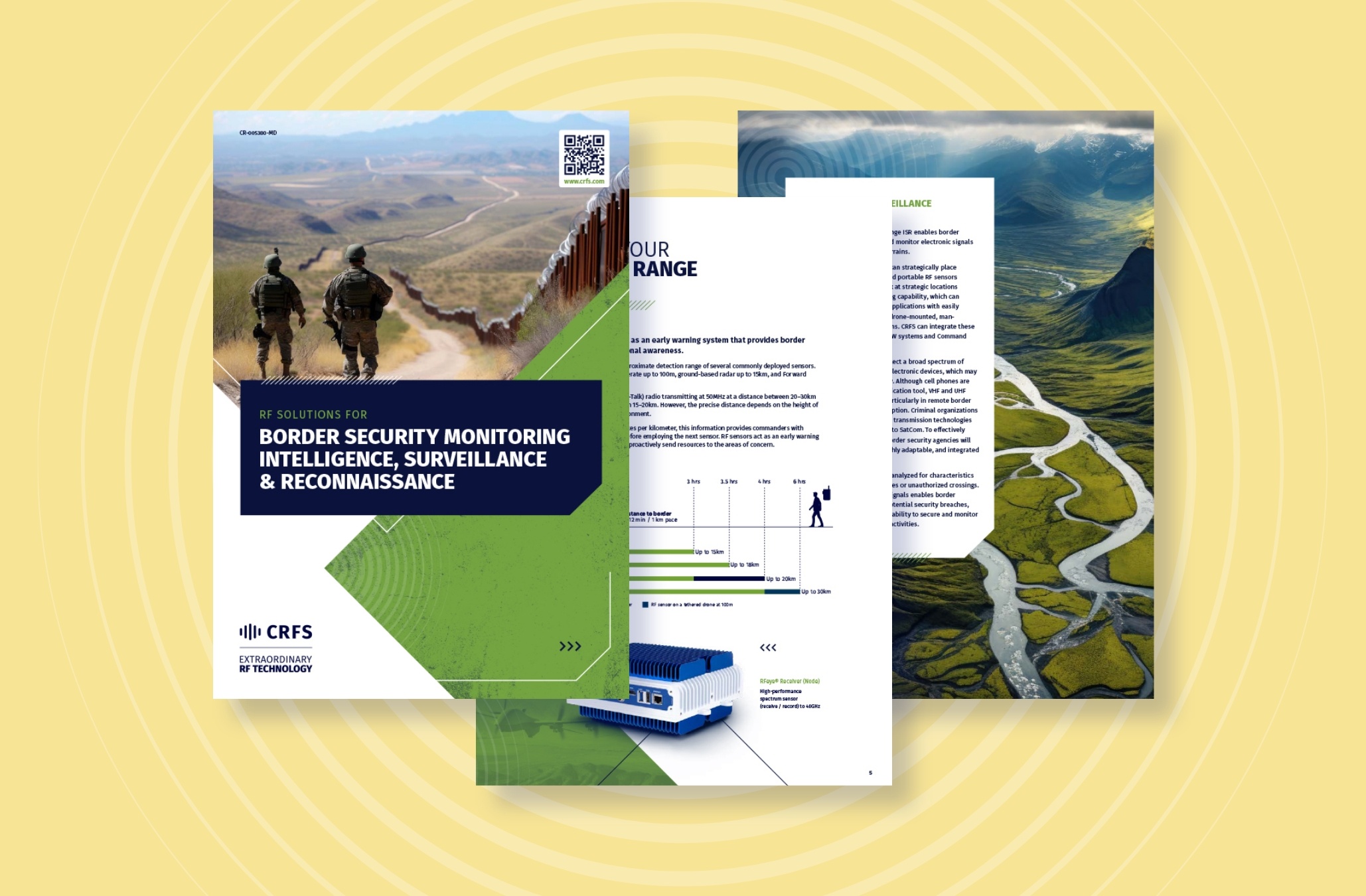 Brochures, Guides & Survey's
Brochures, Guides & Survey's
RF solutions for border security monitoring intelligence, surveillance & reconnaissance
Strategic intelligence gathering, early warning, signal-based detectors, and accurate geolocations can all help avoid conflict, manage hostile neighbors, and detect terrorist activity or unauthorized movement of goods and people.
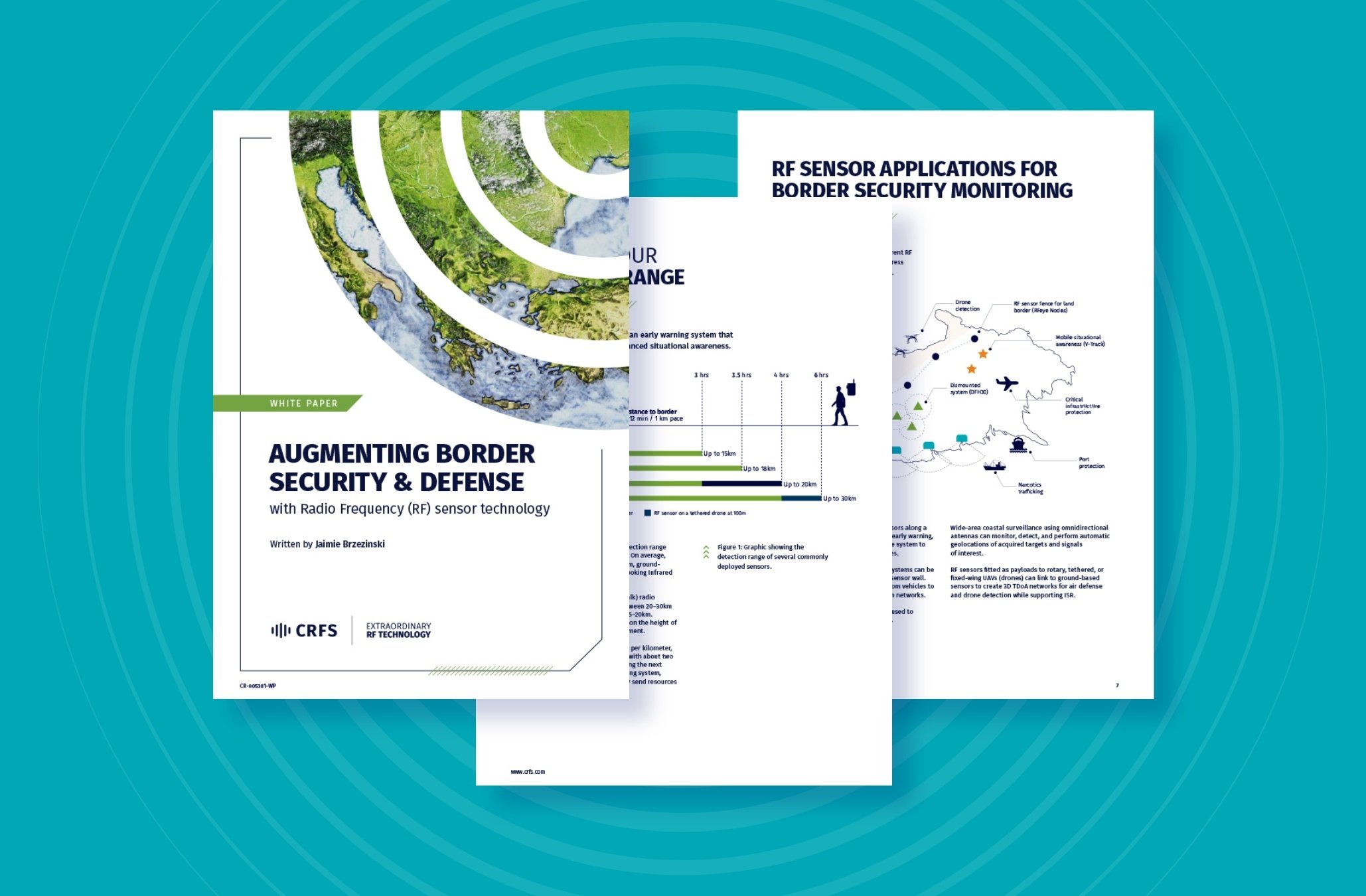 White papers & reports
White papers & reports
Augmenting border security & defense with Radio Frequency (RF) sensor technology
This white paper was guided by the results of a border security survey aimed at border control, border security, and military personnel tasked with national security and defense. It examines how RF sensor technology can be used to tackle modern border security threats.
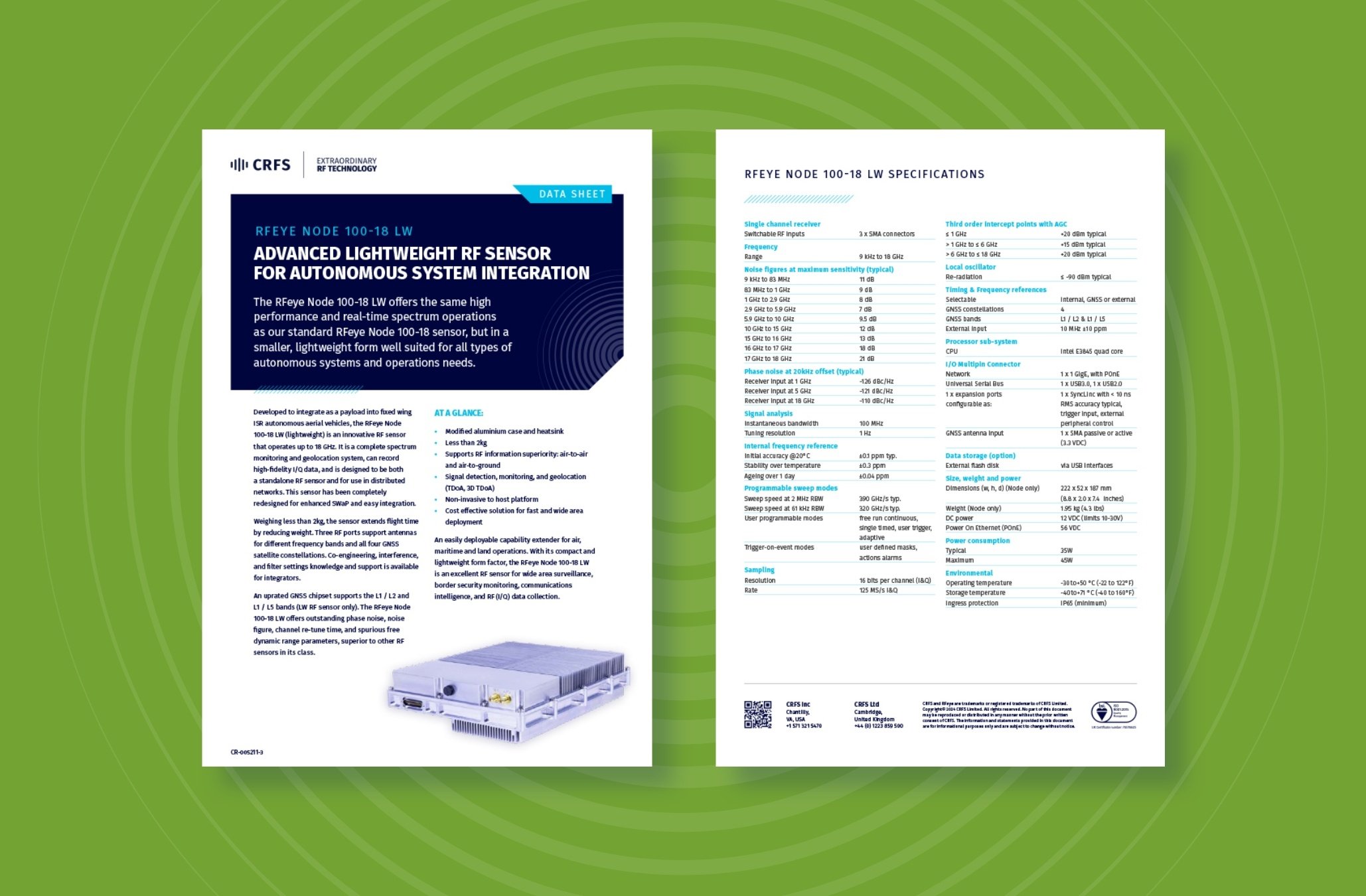 Data sheet
Data sheet
RFeye Node 100-18 LW
The RFeye Node 100-18 LW offers the same high performance and real-time spectrum operations as our standard RFeye Node 100-18 sensor, but in a smaller, lightweight form well suited for all types of autonomous systems and operations needs
 Brochures, Guides & Survey's
Brochures, Guides & Survey's
CRFS APIs Overview
CRFS provides a range of APIs, and by leveraging them customers can seamlessly integrate the capabilities of CRFS software into their proprietary systems, thereby automating tasks, which would otherwise have to be performed manually.
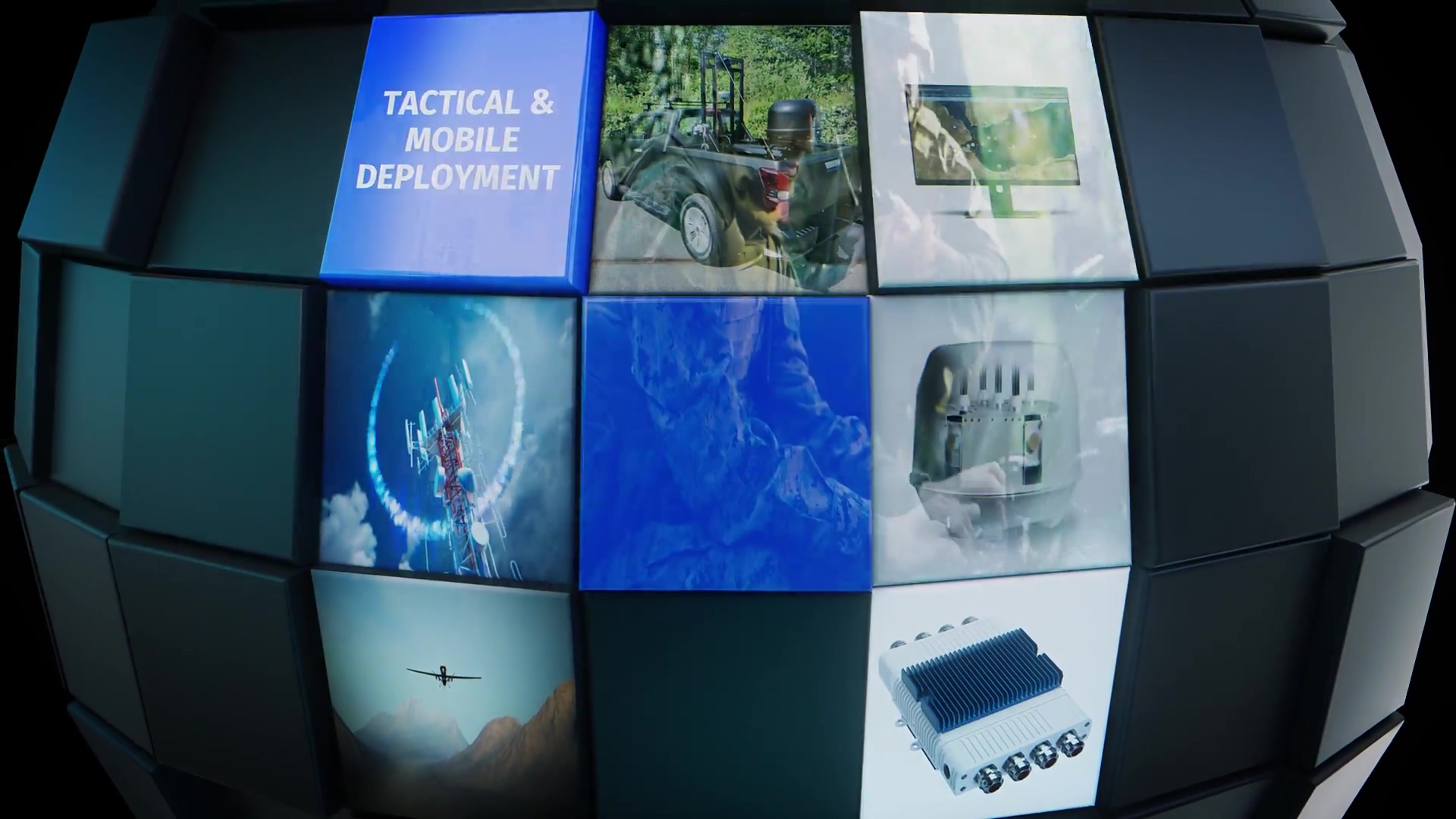 Video
Video
RFeye Ecosystem
The system, hardware, software, and APIs that drive missions carried out by governments, militaries, regulators, R&D companies, and space operators all rely on CRFS technology and support.
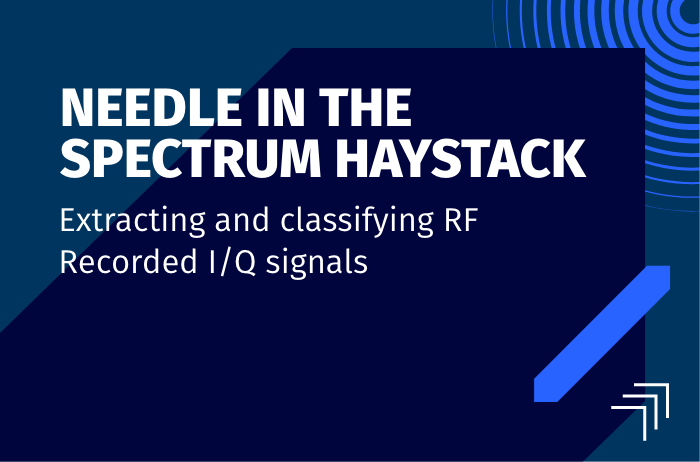 Webinar on demand
Webinar on demand
Needle in the spectrum haystack
Extracting and classifying RF recorded I/Q signals.
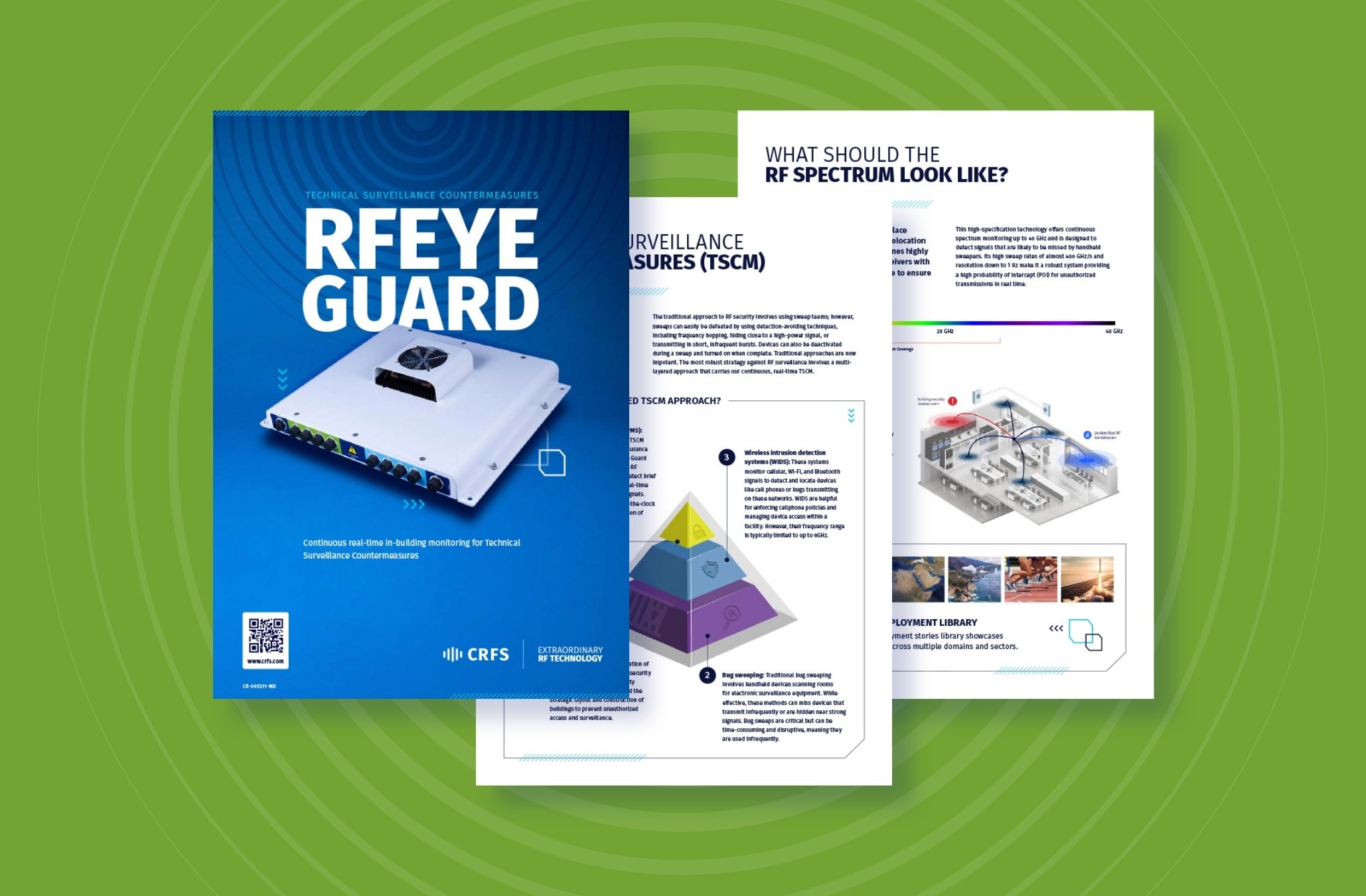 Brochures, Guides & Survey's
Brochures, Guides & Survey's
RFeye Guard Overview
Continuous real-time technical surveillance counter measures for sensitive or secure facilities.
 White papers & reports
White papers & reports
10 ways to meet OPEX & CAPEX challenges
Here are ten things spectrum regulators can do to address OPEX and CAPEX challenges when finances are limited.
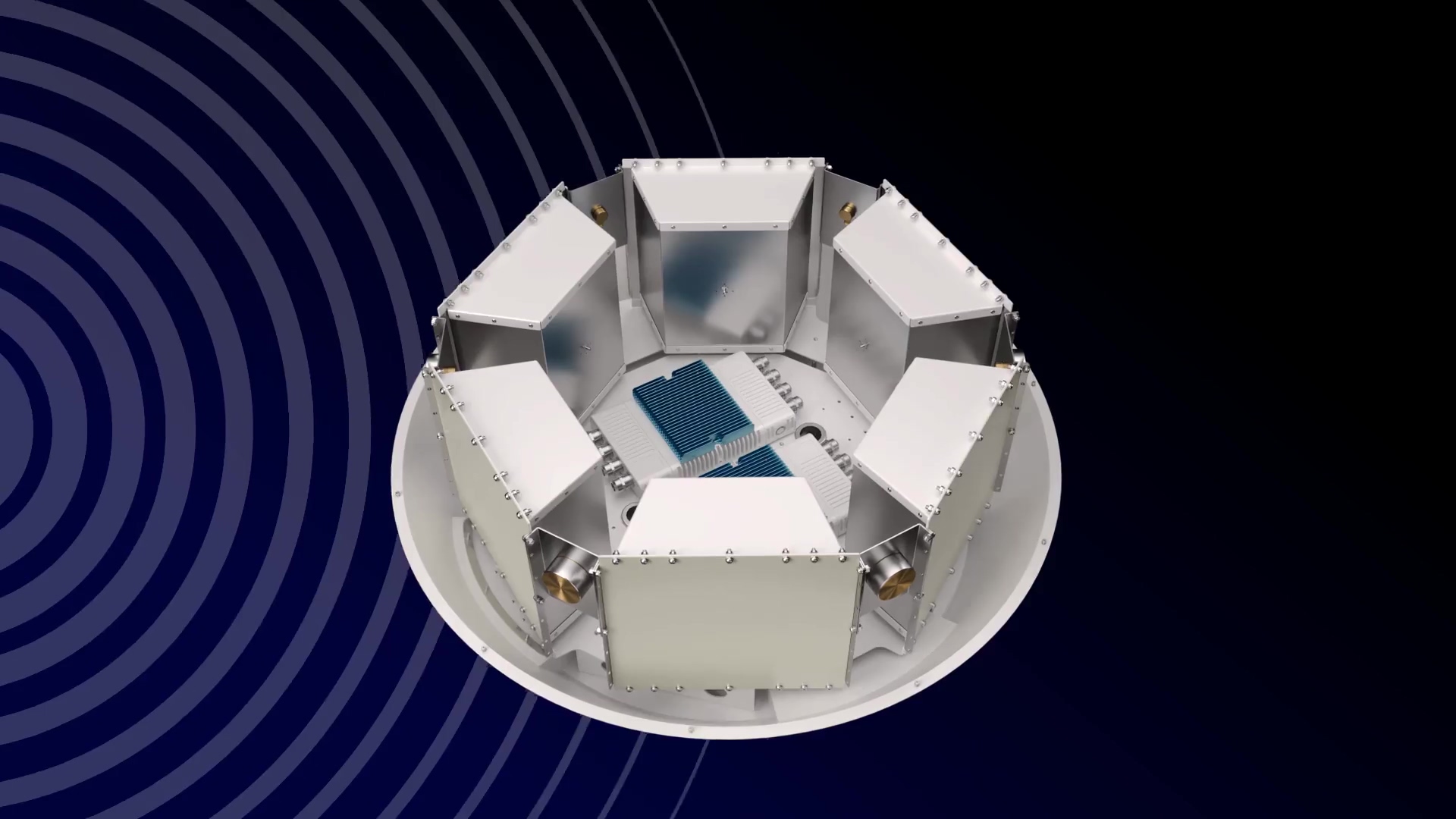 Video
Video
Small Form Factor
CRFS Nodes are small, rugged, lightweight, powerful sensors (receivers and recorders) with outstanding performance and endurance. They are highly versatile, have a low SWaP, and can be used for fixed, mobile, tactical, and in-building deployments.
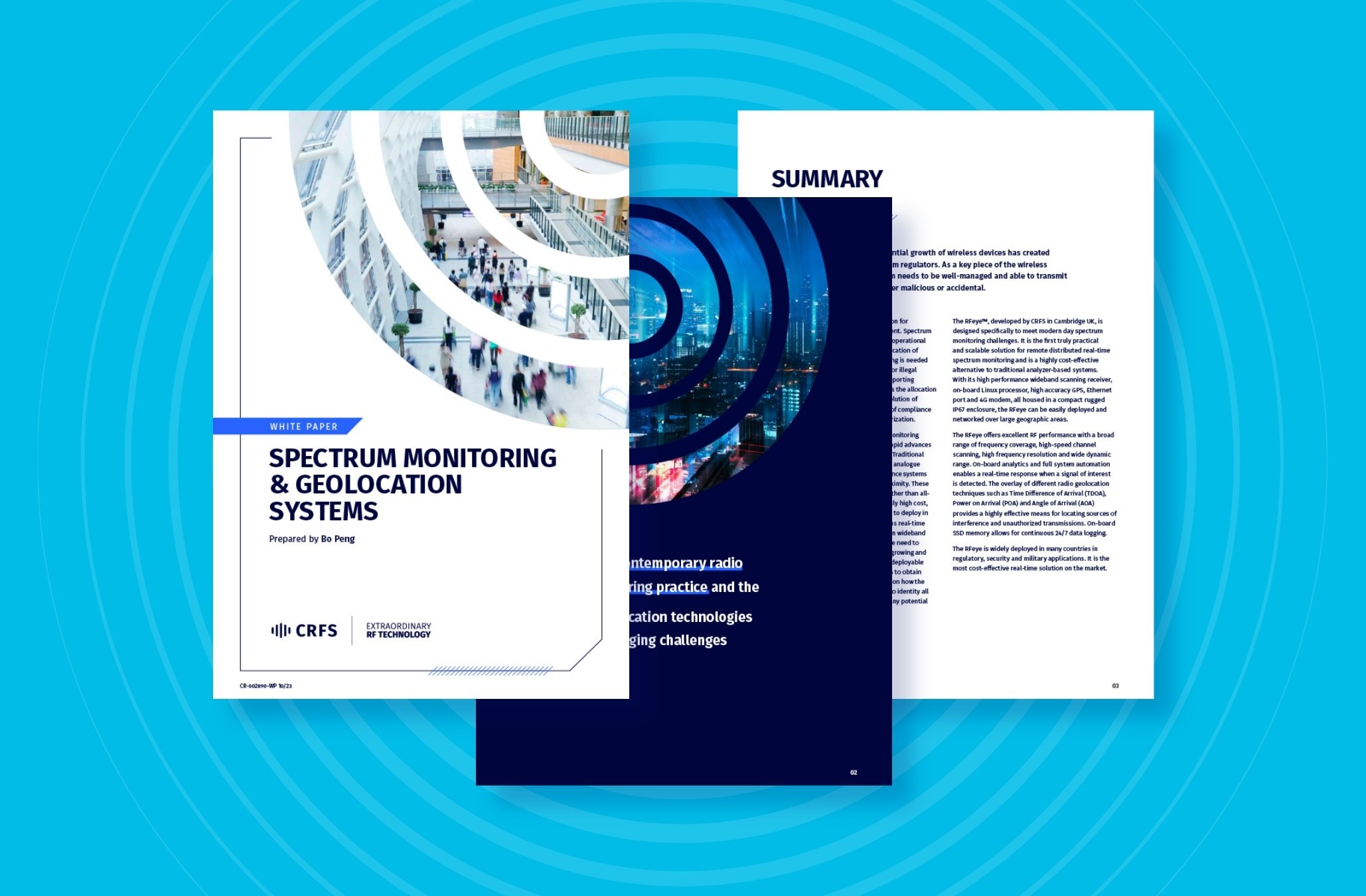 White papers & reports
White papers & reports
Spectrum monitoring & geolocation systems
This white paper provides an overview of contemporary radio spectrum monitoring and the sensor and geolocation technologies required to meet emerging challenges.
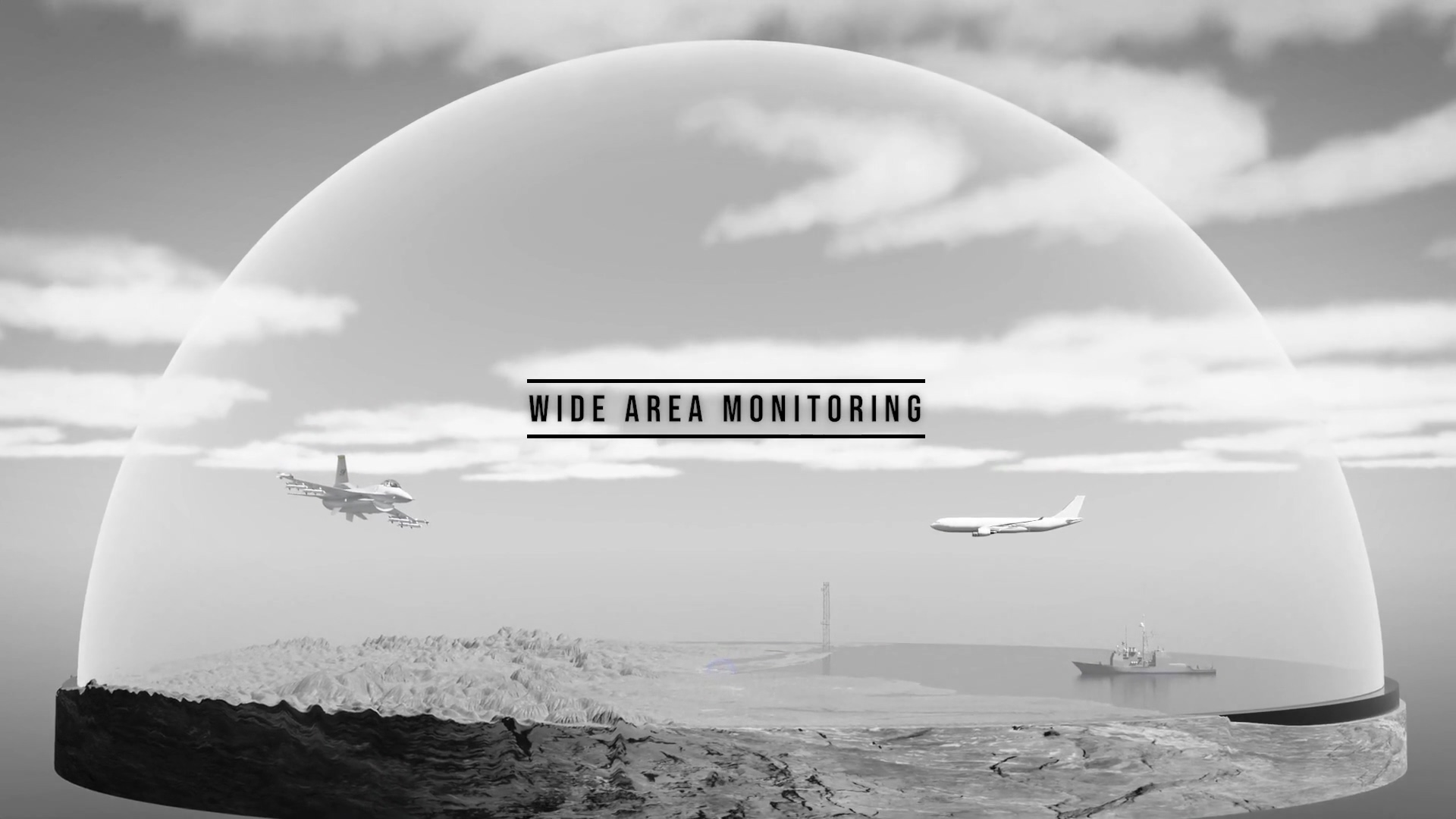 Video
Video
Capability Introduction
Obtain RF intelligence, maintain spectrum awareness, and achieve mission-critical objectives.
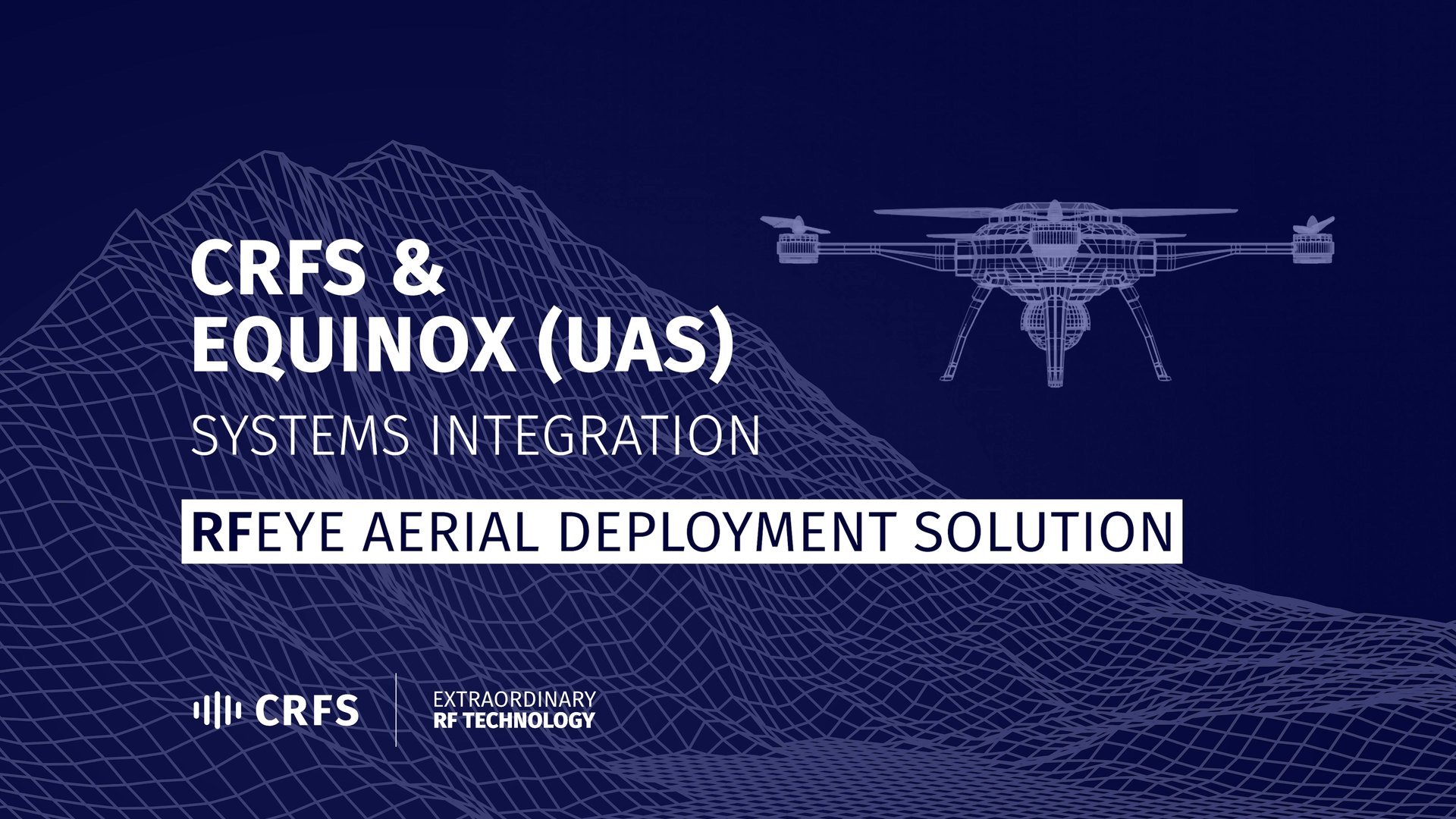 Video
Video
Tethered Drone Integration
CRFS x Equinox innovate systems: RFeye aerial deployment solutions.
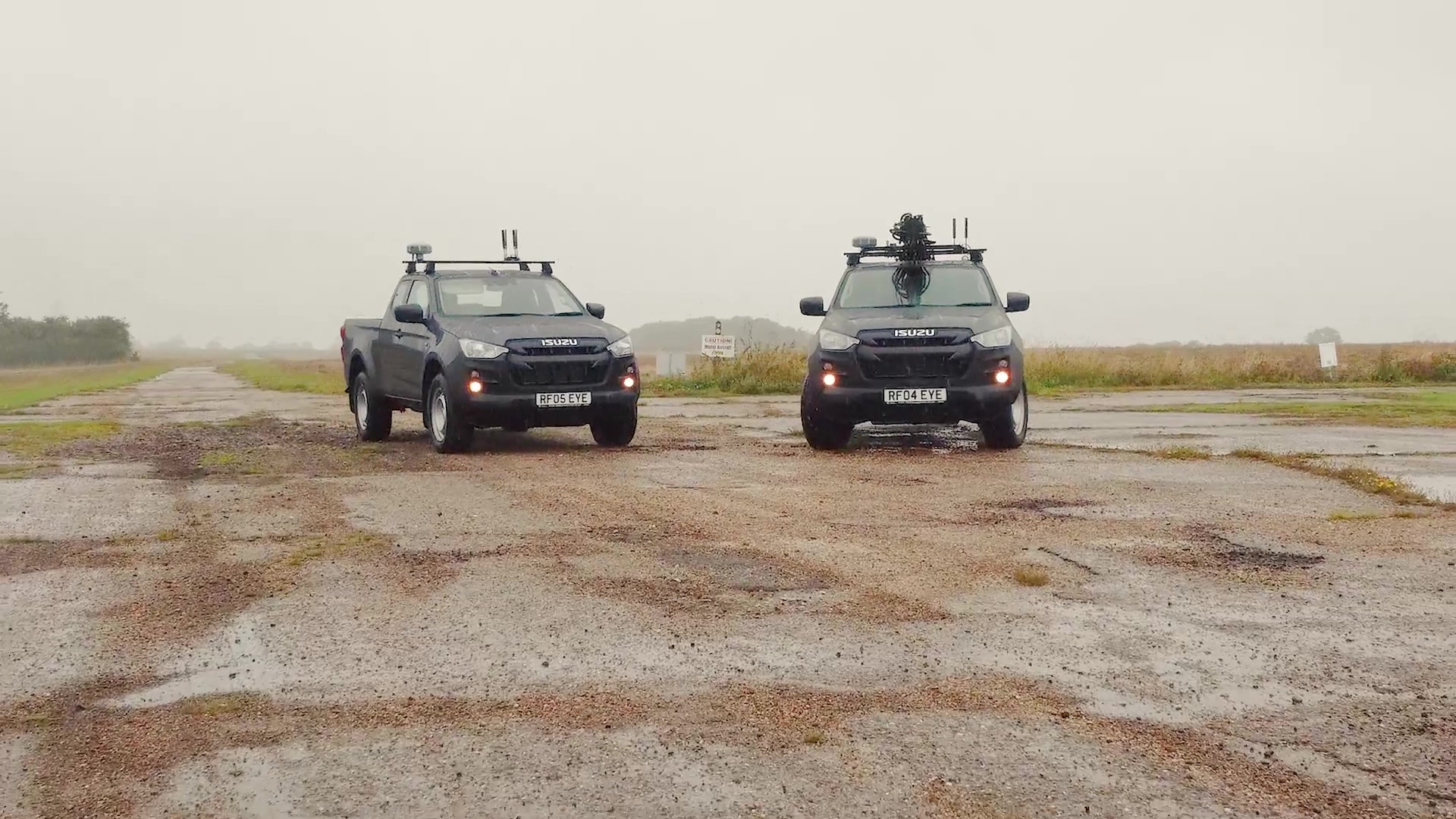 Video
Video
Integrated Vehicles
Introducing RFeye V-Track: RFeye Nodes can be deployed on a 20m mast for mobile missions.
 Video
Video
Military & EW Operator Solutions
On today’s battlefield, achieving spectrum dominance is key to ensuring military superiority and tactical advantage. To dominate the spectrum, operators must identify and locate a threat by turning real-time signal capture and emitter data into actionable intelligence.
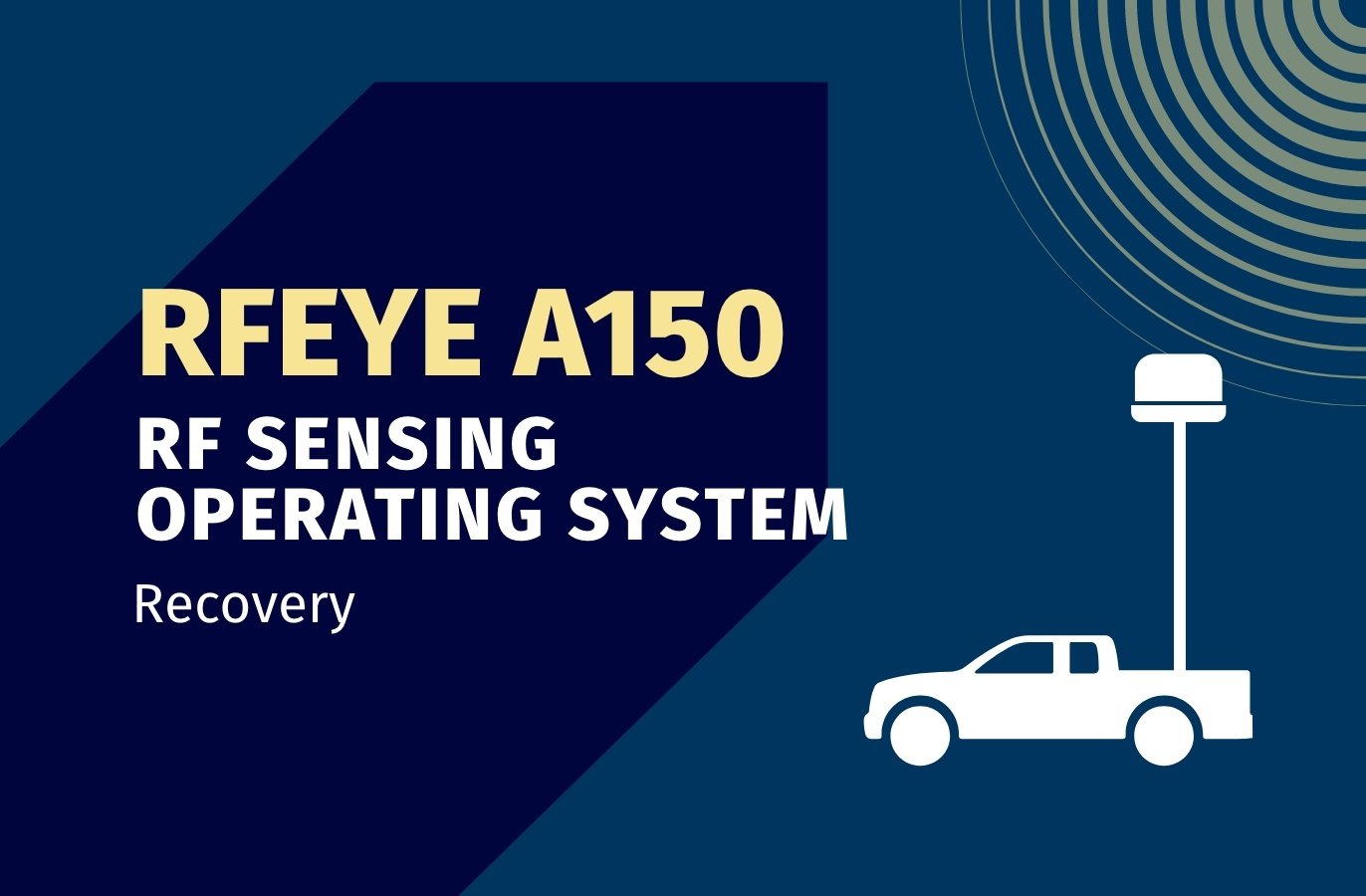 Video
Video
RFeye integrated vehicle solutions
RFeye A150: Recovery
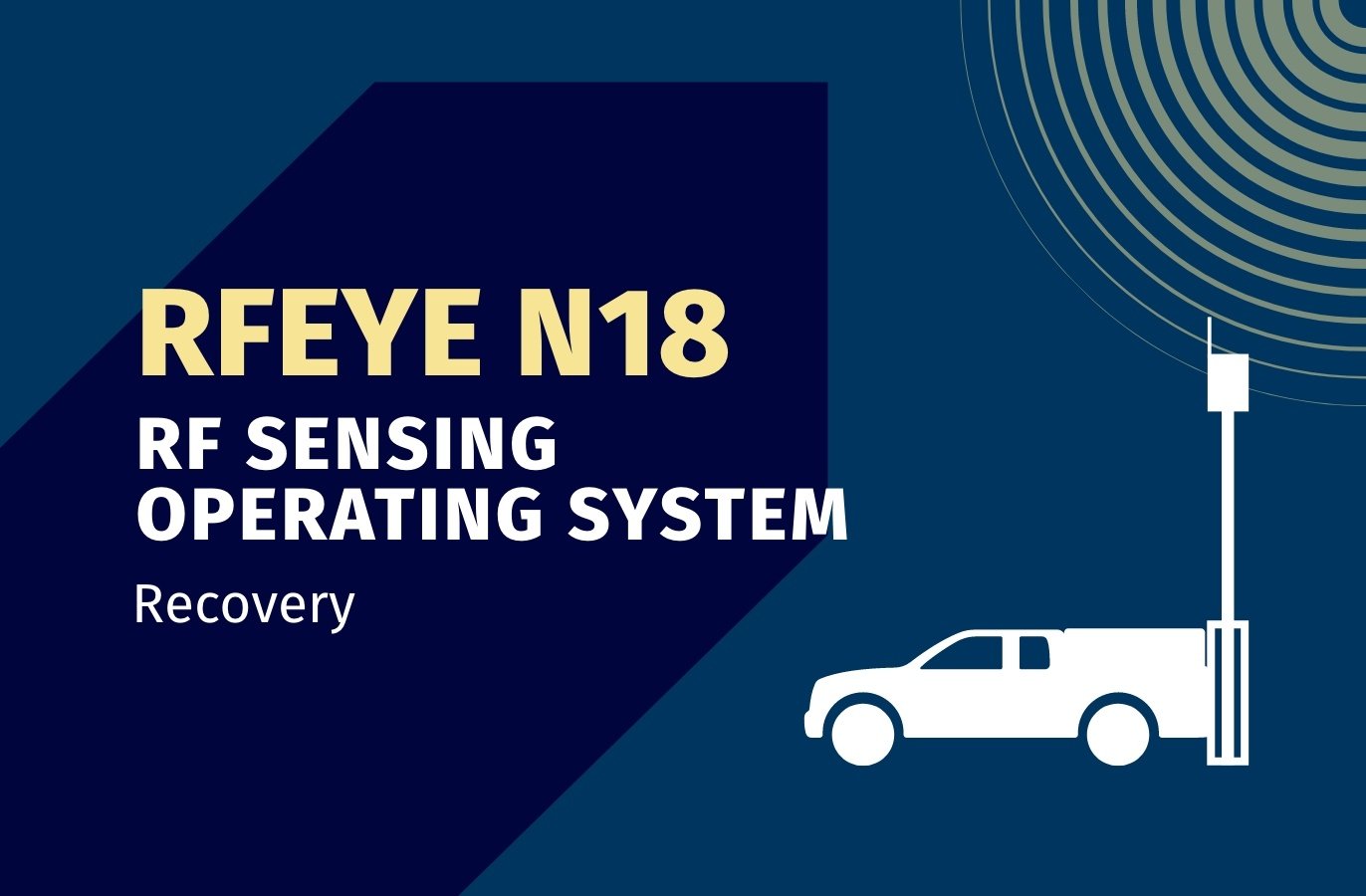 Video
Video
RFeye integrated vehicle solutions
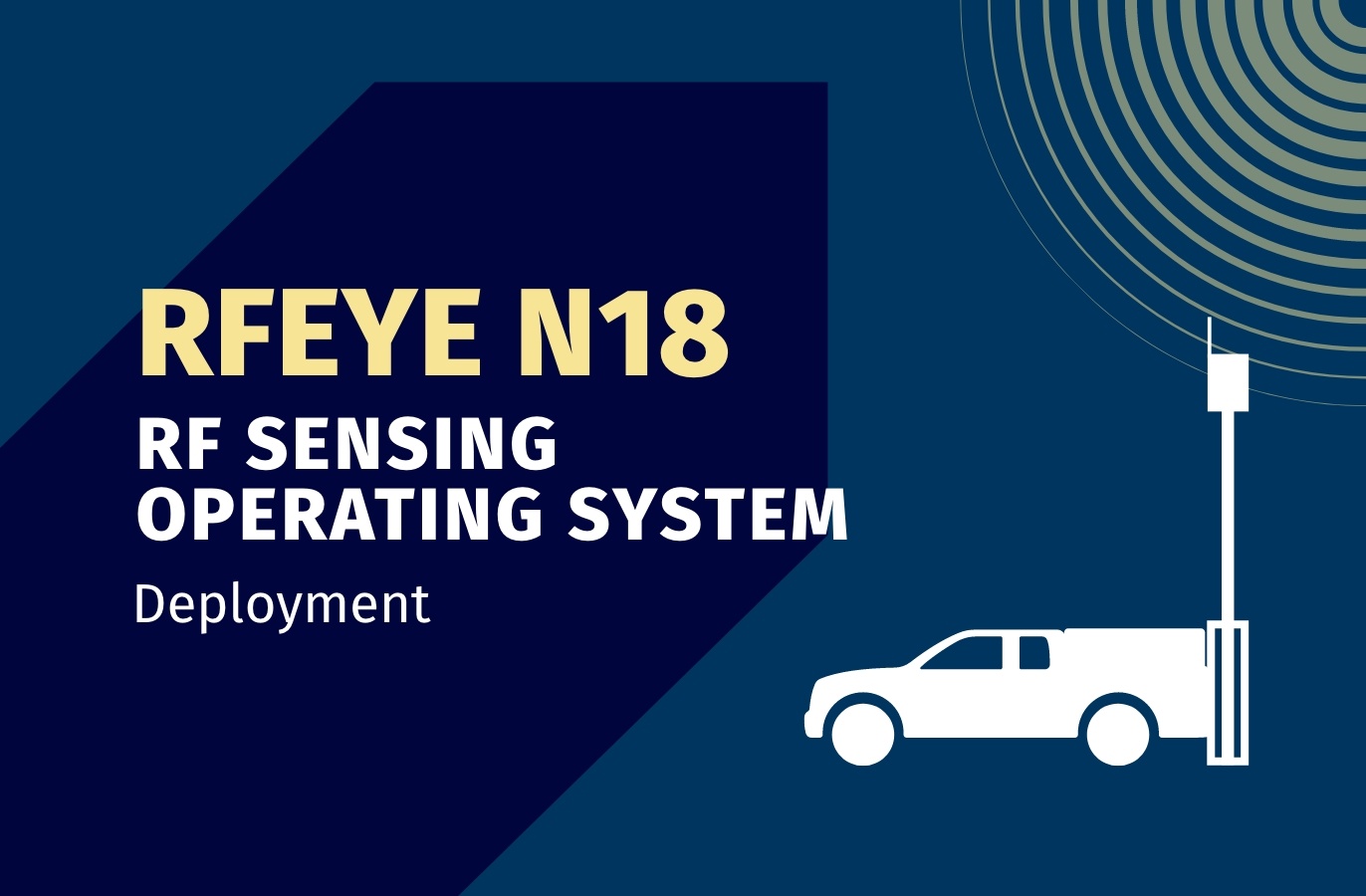 Video
Video
RFeye integrated vehicle solutions
 Video
Video
RFeye integrated vehicle solutions
-thumb-1.jpeg?length=1920) Video
Video
Spectrum Monitoring
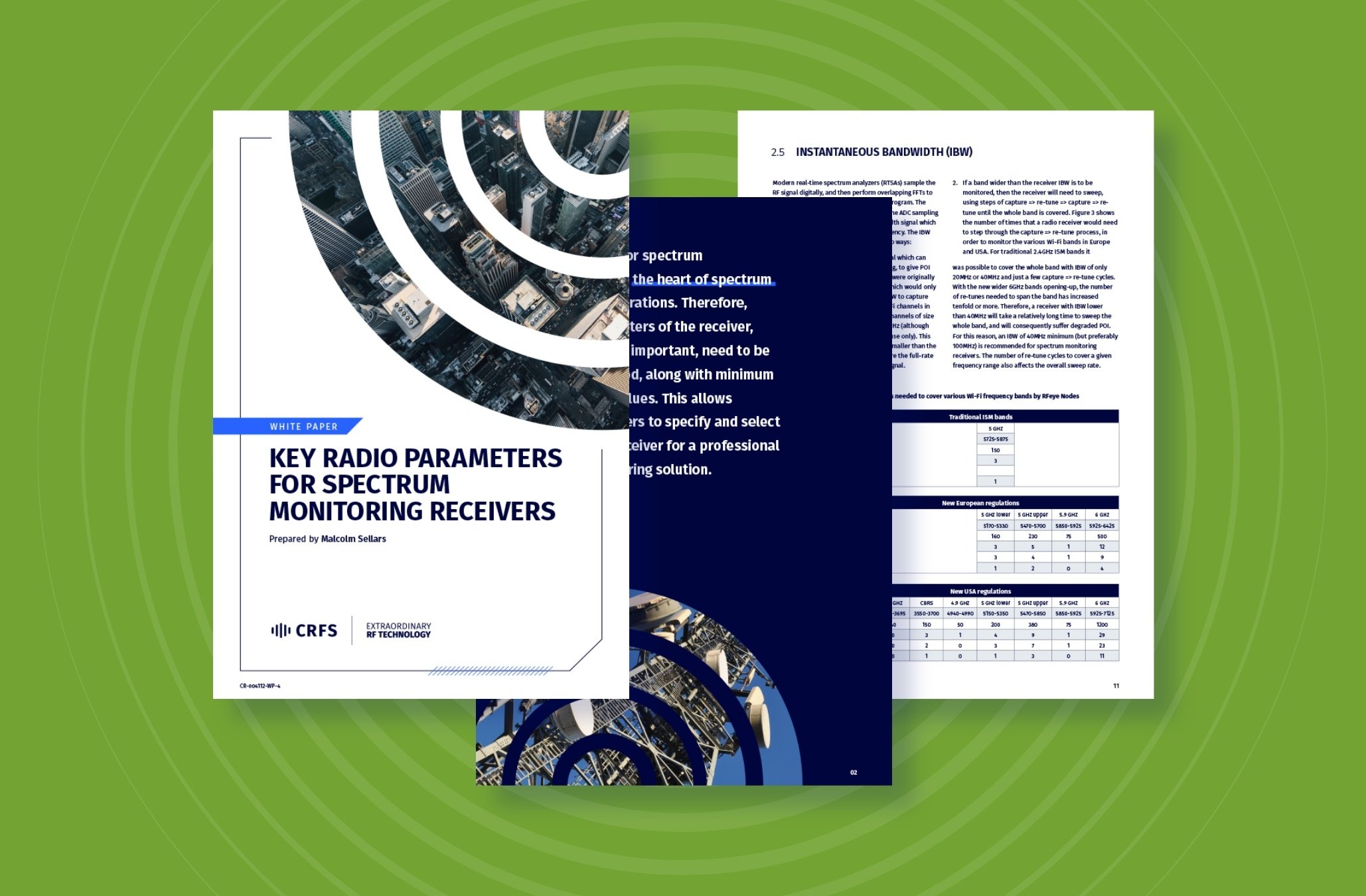 White papers & reports
White papers & reports
Key radio parameters for spectrum monitoring receivers
Radio receivers are essential for spectrum monitoring operations. Therefore, an understanding of receivers' key radio parameters and minimum recommended values allows spectrum managers to select the best radio receiver for their spectrum monitoring solution.
 White papers & reports
White papers & reports
Passive geolocation with 3D TDOA
This white paper addresses the basic operating principles of 3D TDoA; Practical limitations on its accuracy; Applications of the technique.
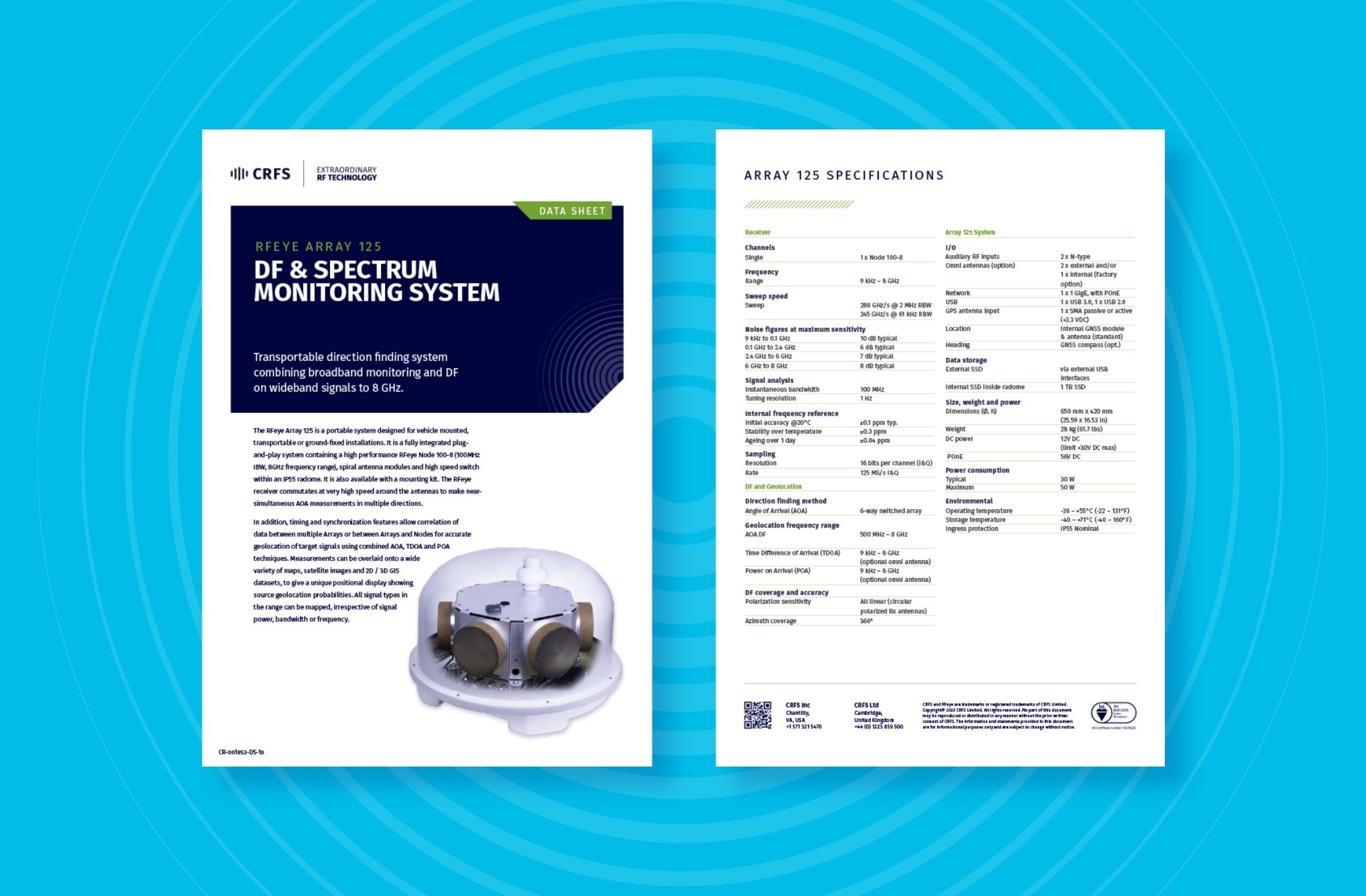 Data sheet
Data sheet
RFeye Array 125
Transportable direction finding system combining broadband monitoring and DF on wideband signals to 8 GHz.
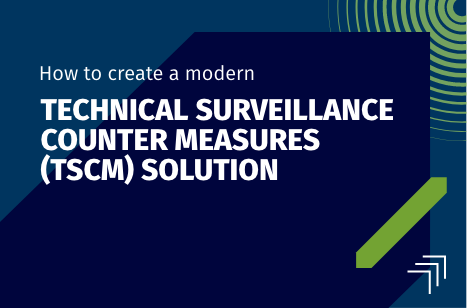 Webinar on demand
Webinar on demand
Technical surveillance counter measures (TSCM) solutions
How to create a best-of-breed Technical Surveillance Counter Measures (TSCM) solution
 Webinar on demand
Webinar on demand
Spectrum monitoring for regulators
De-risking investment decisions
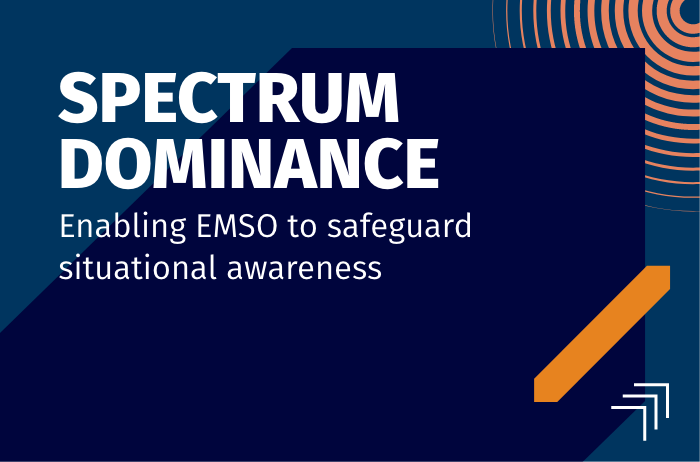 Webinar on demand
Webinar on demand
Spectrum dominance
Enabling EMSO to safeguard situational awareness
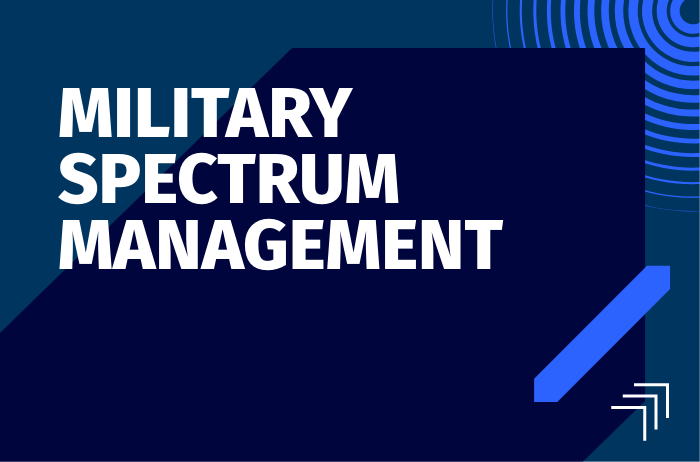 Webinar on demand
Webinar on demand
Military spectrum management
Challenges faced by modern militaries and methods to streamline and automate spectrum management
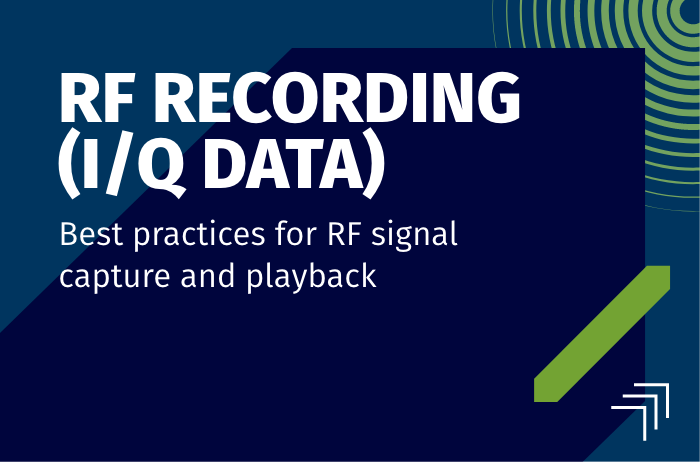 Webinar on demand
Webinar on demand
RF recording (I/Q data)
Best practices for RF signal capture and playback
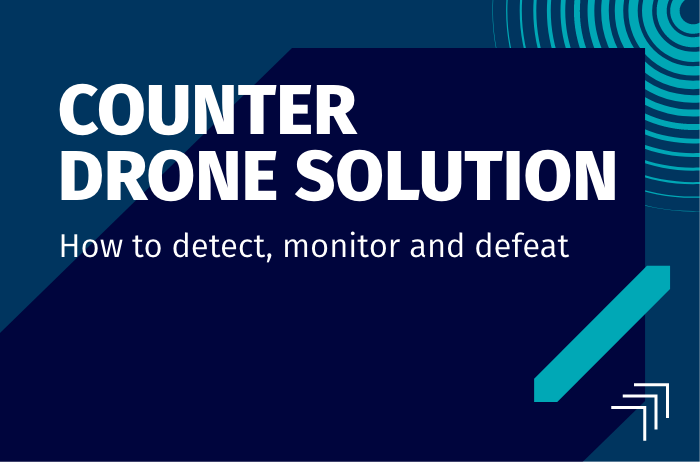 Webinar on demand
Webinar on demand
Counter drone solution
How to detect, monitor and defeat
 Video
Video
RFeye integrated vehicle solutions
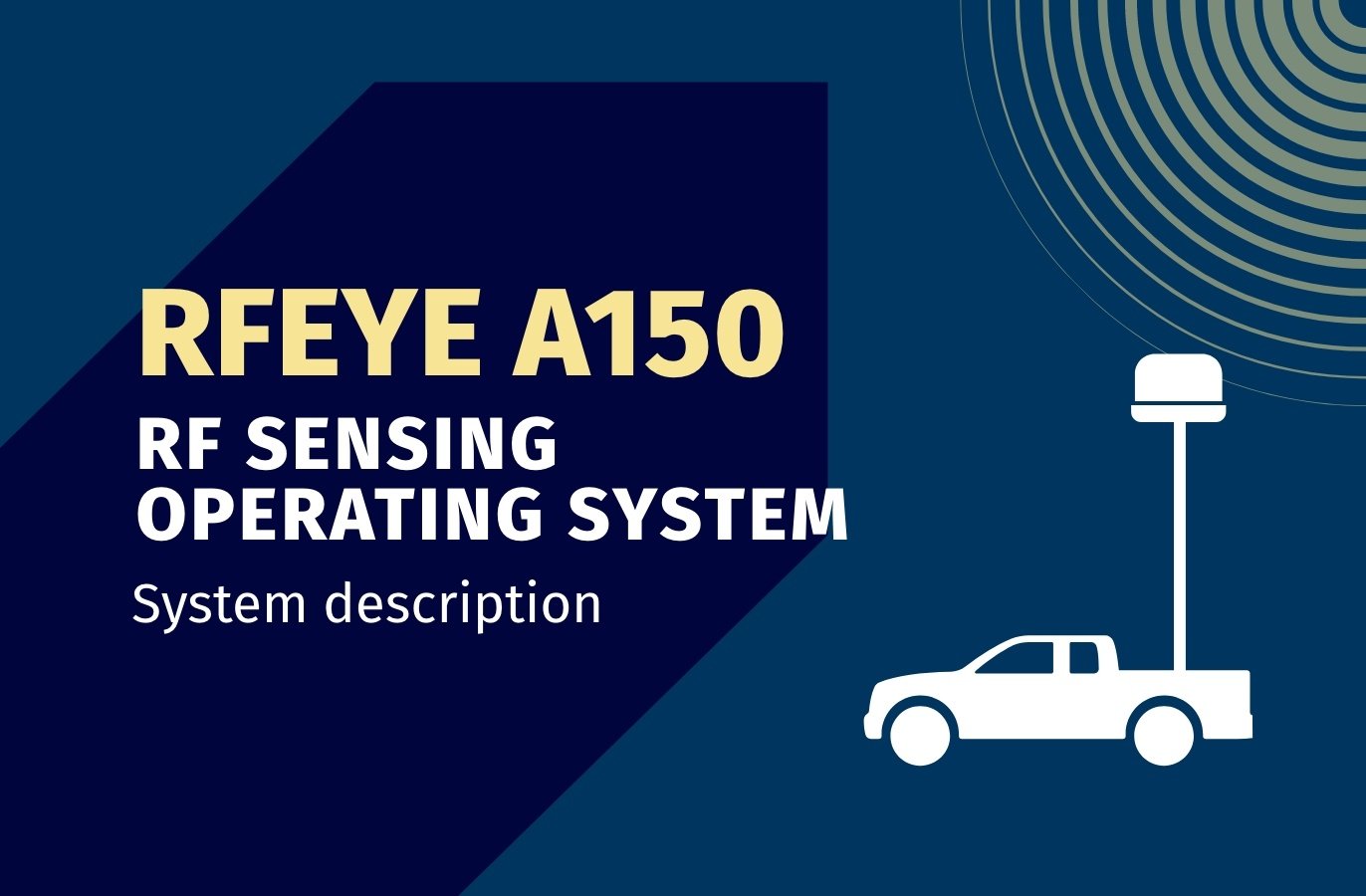 Video
Video
RFeye integrated vehicle solutions
 Webinar on demand
Webinar on demand
SIGINT in the modern environment
D&D developments and methodologies that affect modern SIGINT operations
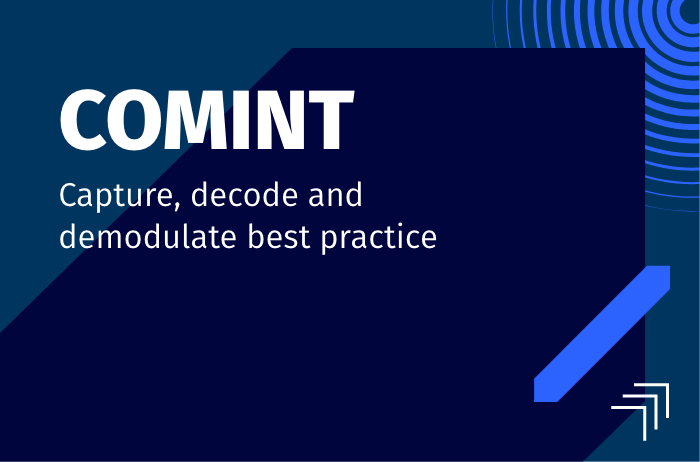 Webinar on demand
Webinar on demand
COMINT
Capture, decode & demodulate best practice
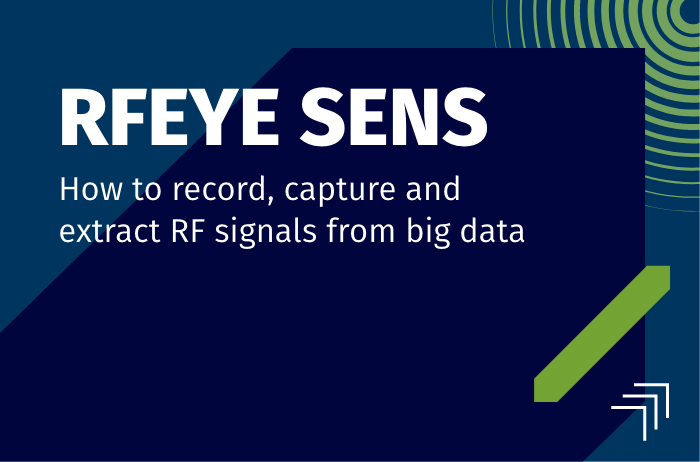 Webinar on demand
Webinar on demand
RFeye SenS
How to record, capture & extract RF signals from big data
 Webinar on demand
Webinar on demand
TDOA – a modern geolocation solution
How and why TDOA is the new go to RF geolocation method
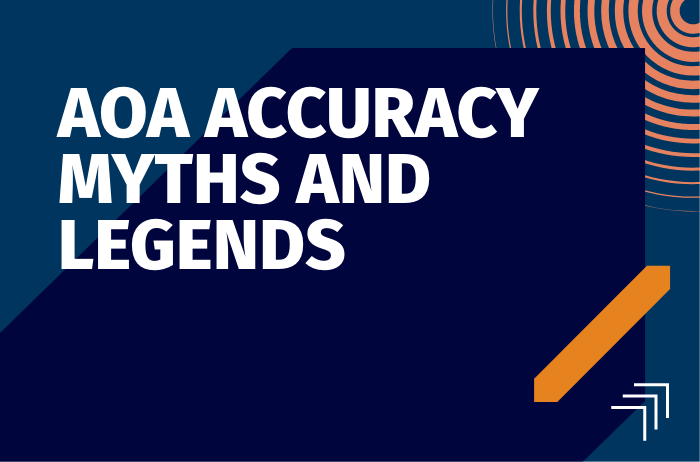 Webinar on demand
Webinar on demand
AoA accuracy myths and legends
Examine the limitations and ways to use the data
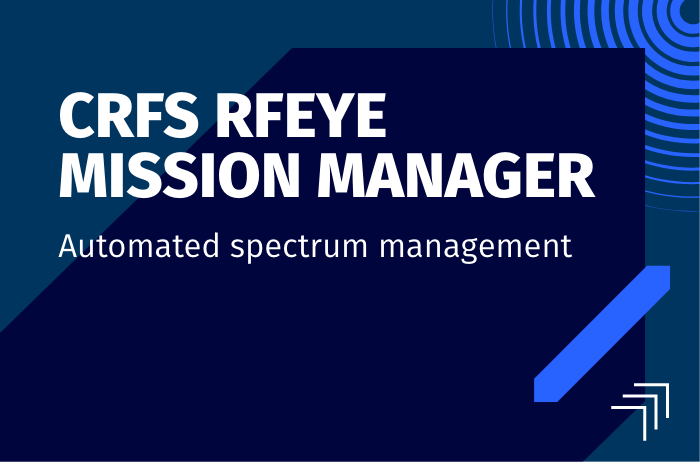 Webinar on demand
Webinar on demand
RFeye Mission Manager
Automate spectrum management tasks to reduce workloads
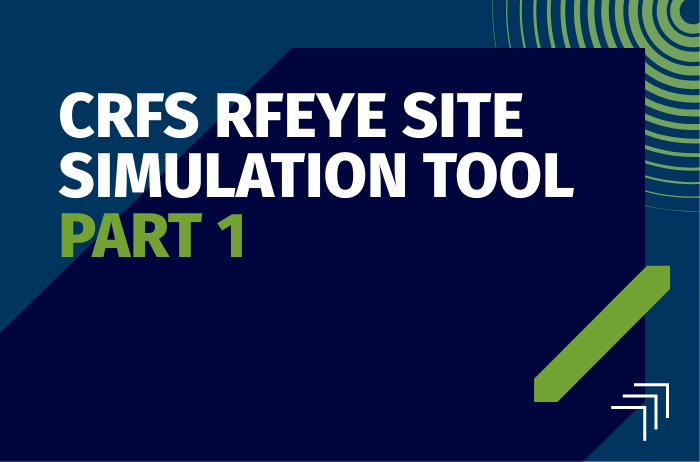 Webinar on demand
Webinar on demand
RFeye Site Simulation tool (Part 1)
Using simulated receivers and transmitters in CRFS’s RFeye software
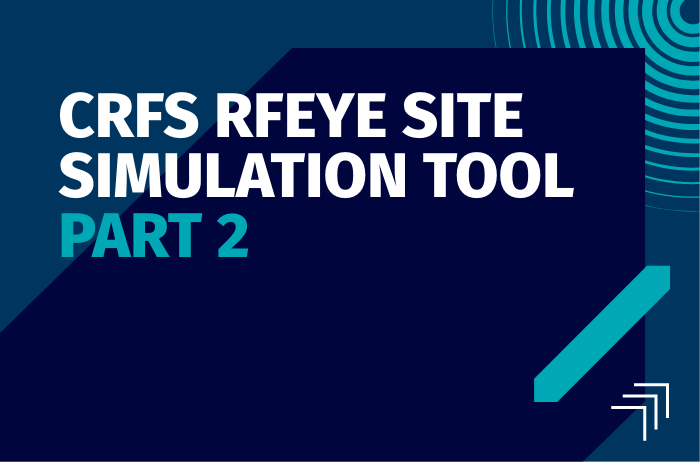 Webinar on demand
Webinar on demand
RFeye Site Simulation tool (Part 2)
AOA (Angle On Arrival) geolocation of a sweeping (chirp) continuous wave transmitter in a complex signal environment
 White papers & reports
White papers & reports
Angle of arrival / direction finding techniques
This white paper outlines the various forms of AoA , including how they work, how they can be applied in practice, and how they can be combined with other geolocation techniques, such as time difference of arrival (TDoA).
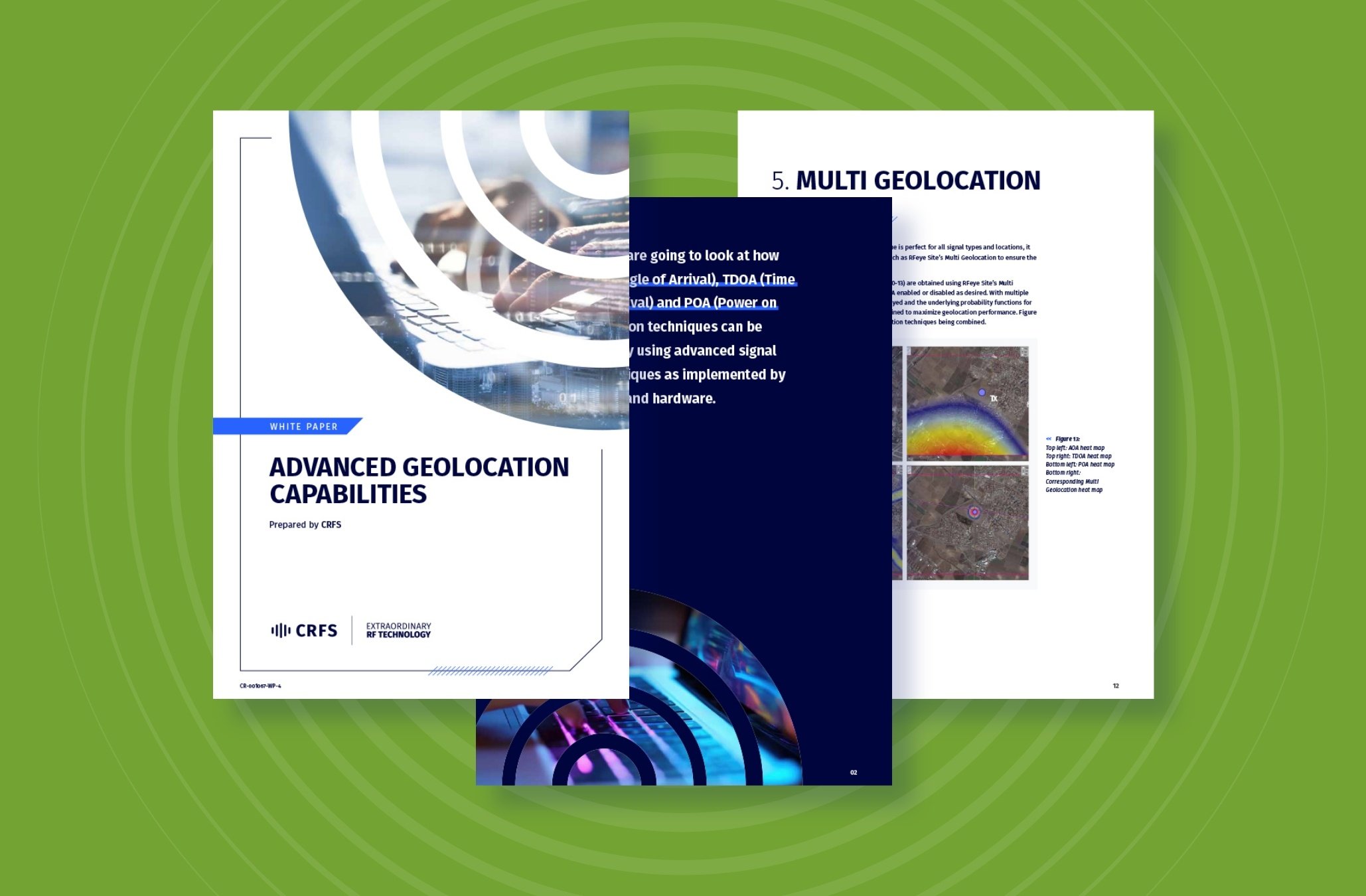 White papers & reports
White papers & reports
Advanced geolocation capabilities
This white paper explores how to enhance standard geolocation techniques such as AoA (Angle of Arrival), TDoA (Time Difference of Arrival), and PoA (Power on Arrival) by using the advanced signal processing methods employed by RFeye software and hardware.
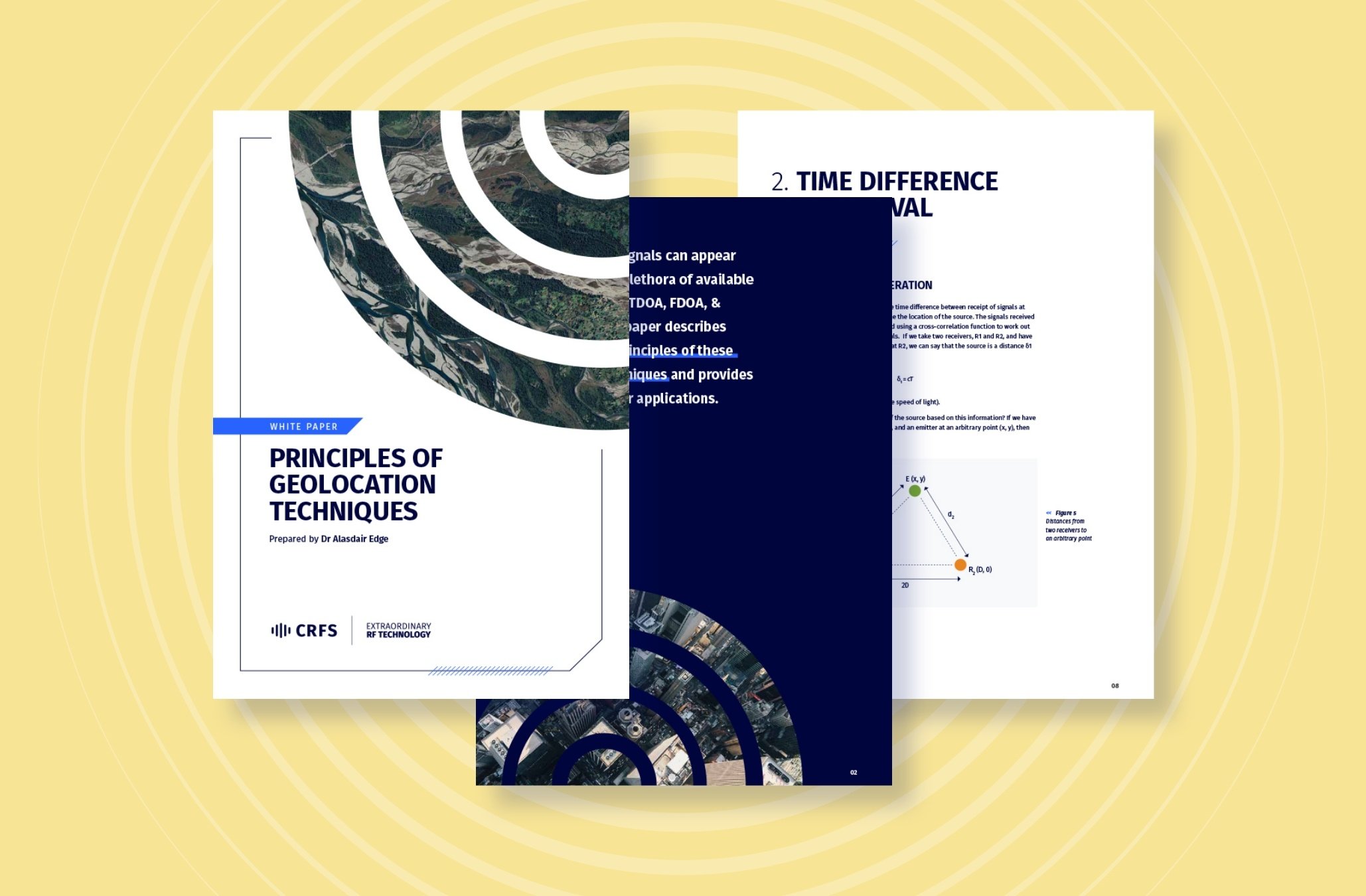 White papers & reports
White papers & reports
Principles of geolocation techniques
This white paper outlines the most important geolocation techniques, explains the differences between them, and provides an outline of their applications.
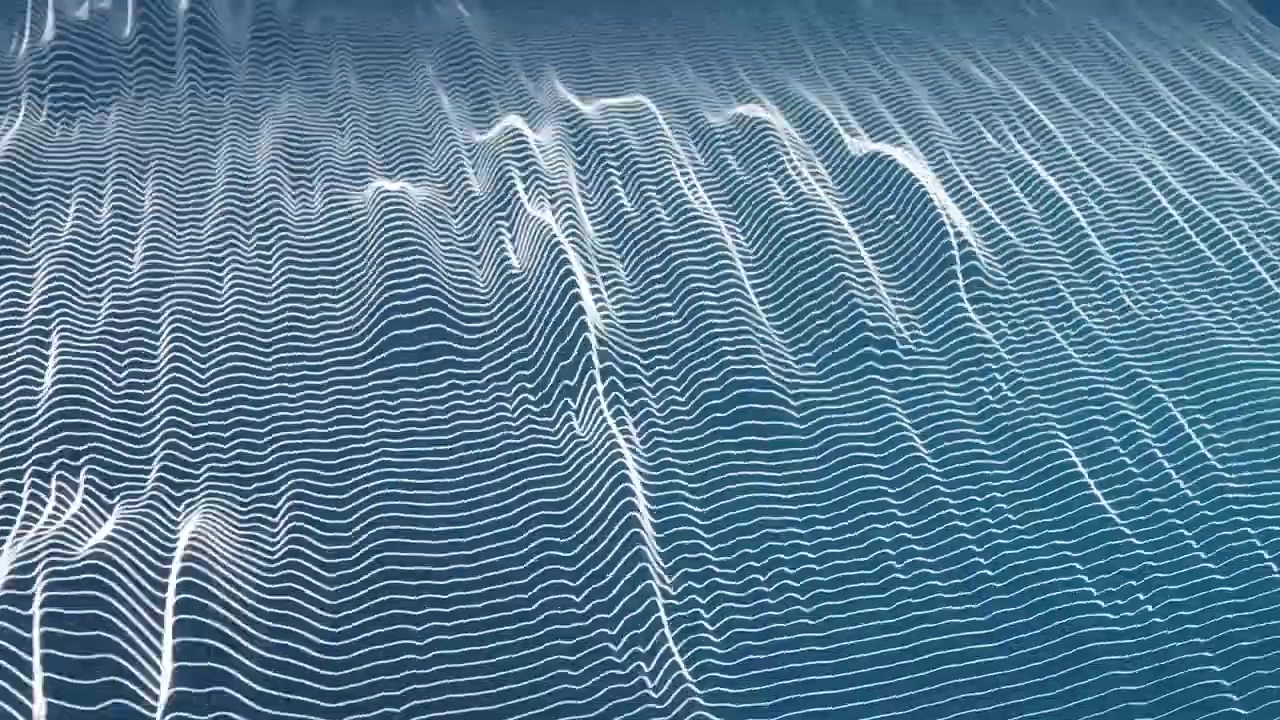 Video
Video
RFeye Node Introduction
Explanation by Alistair Massarella - CTO & Co-founder of CRFS.
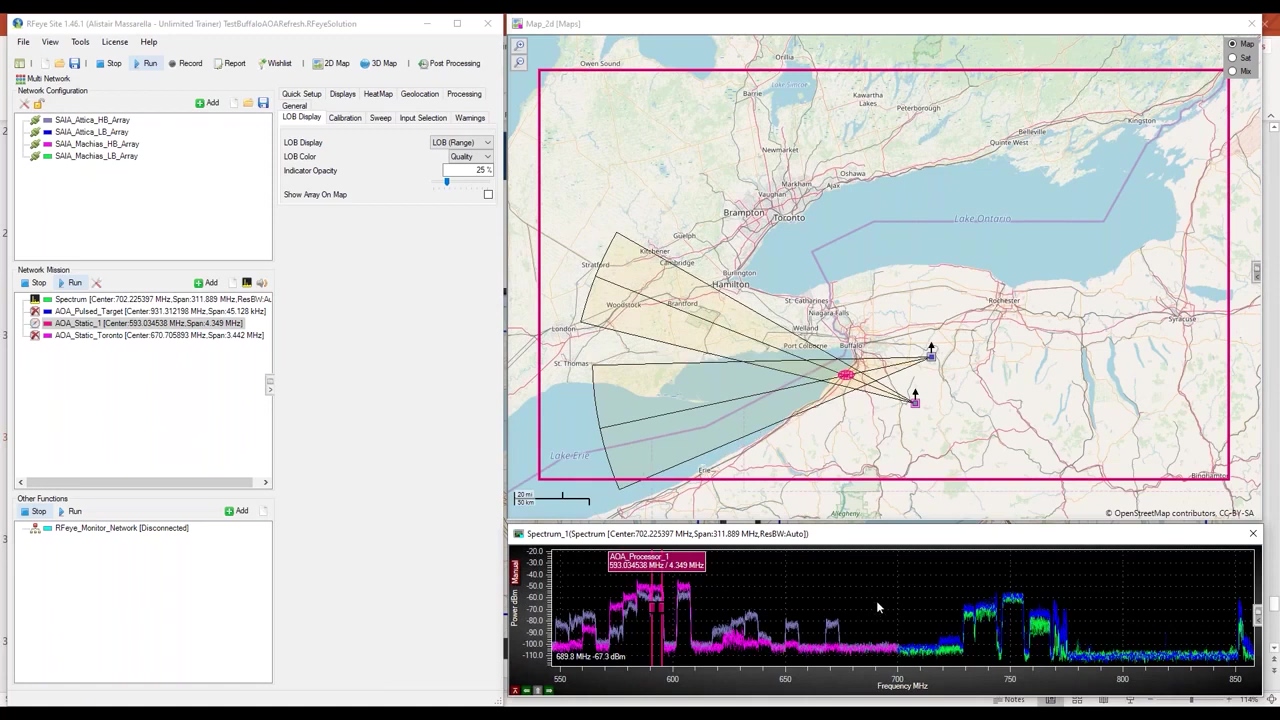 Video
Video
RFeye Site Software
An AOA Illustration.
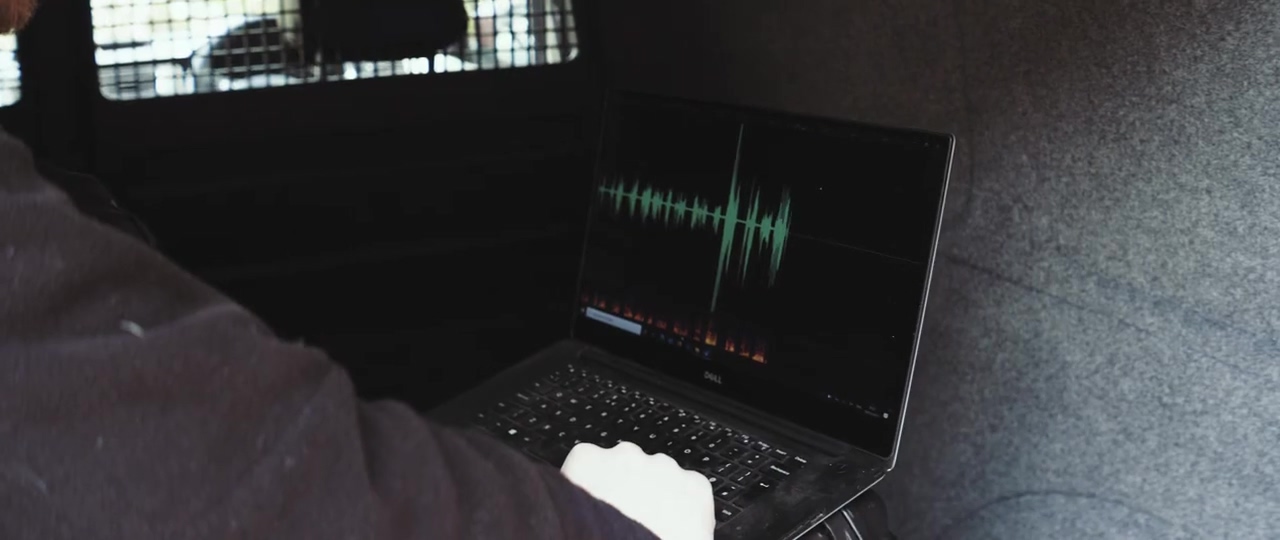 Video
Video
RFeye Guard
Technical Surveillance Countermeasures.
 Video
Video
Multipath: Understanding RF
Understanding multipath RF for direction finding.
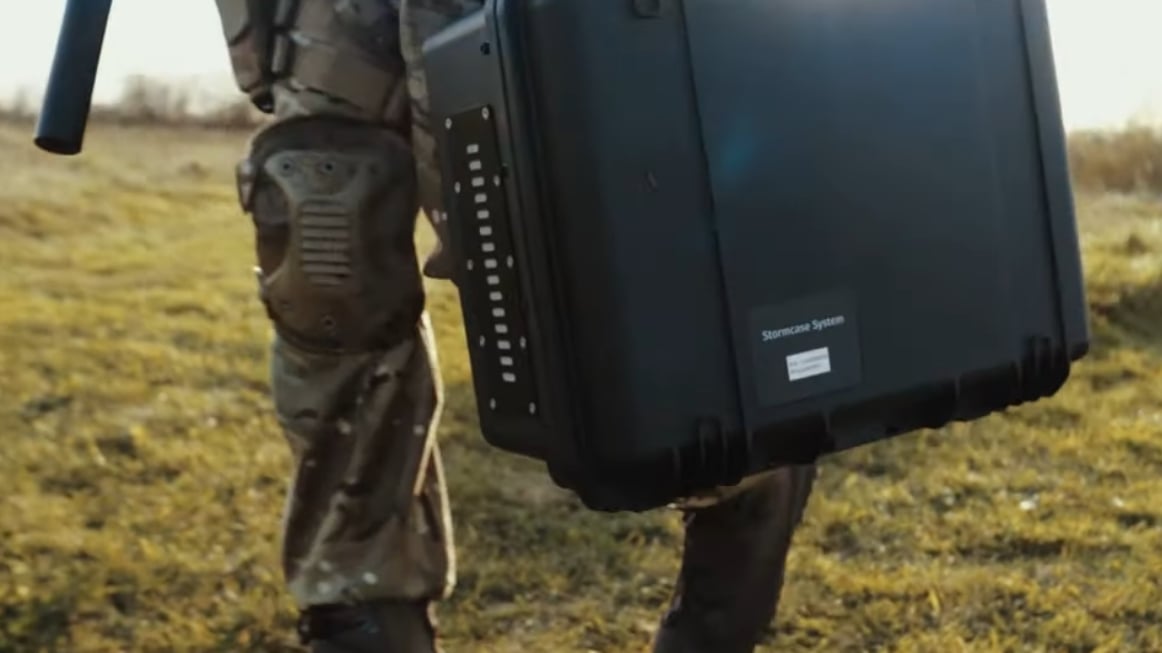 Video
Video
RFeye Stormcase Introduction
A plug-and-play portable, intelligent RF receiver.
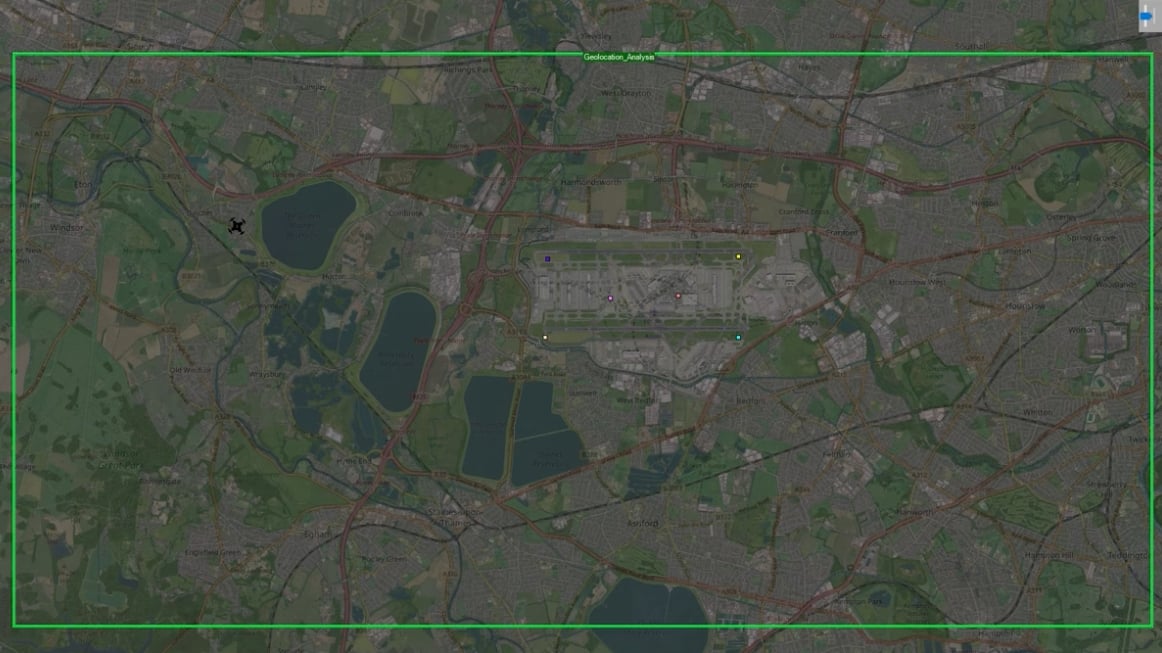 Video
Video
RFeye Site (Synthetic Vector)
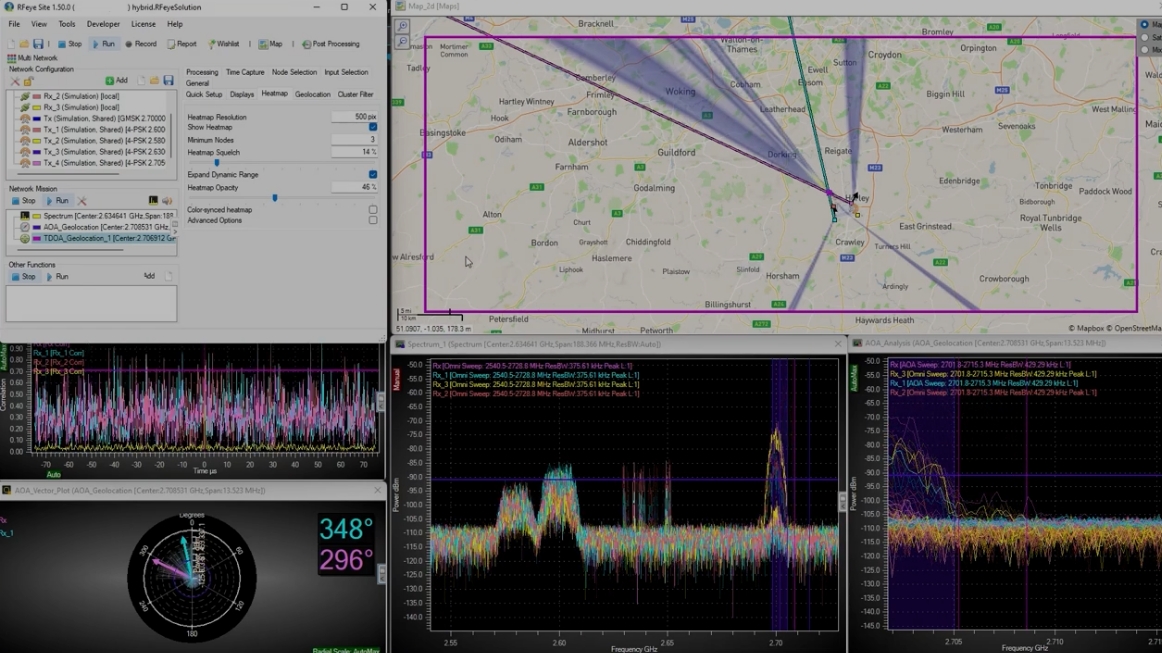 Video
Video
RFeye Site Hybrid TDOA & AOA
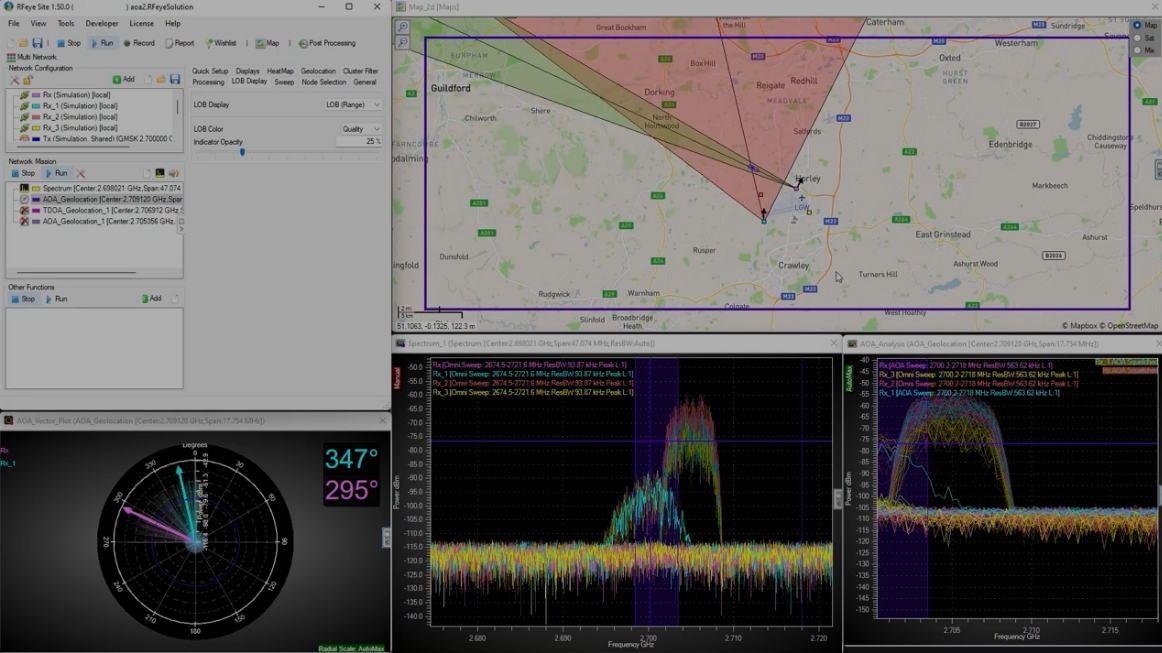 Video
Video
CRFS RFeye Site AoA
 Video
Video
CRFS Drone Detection Video
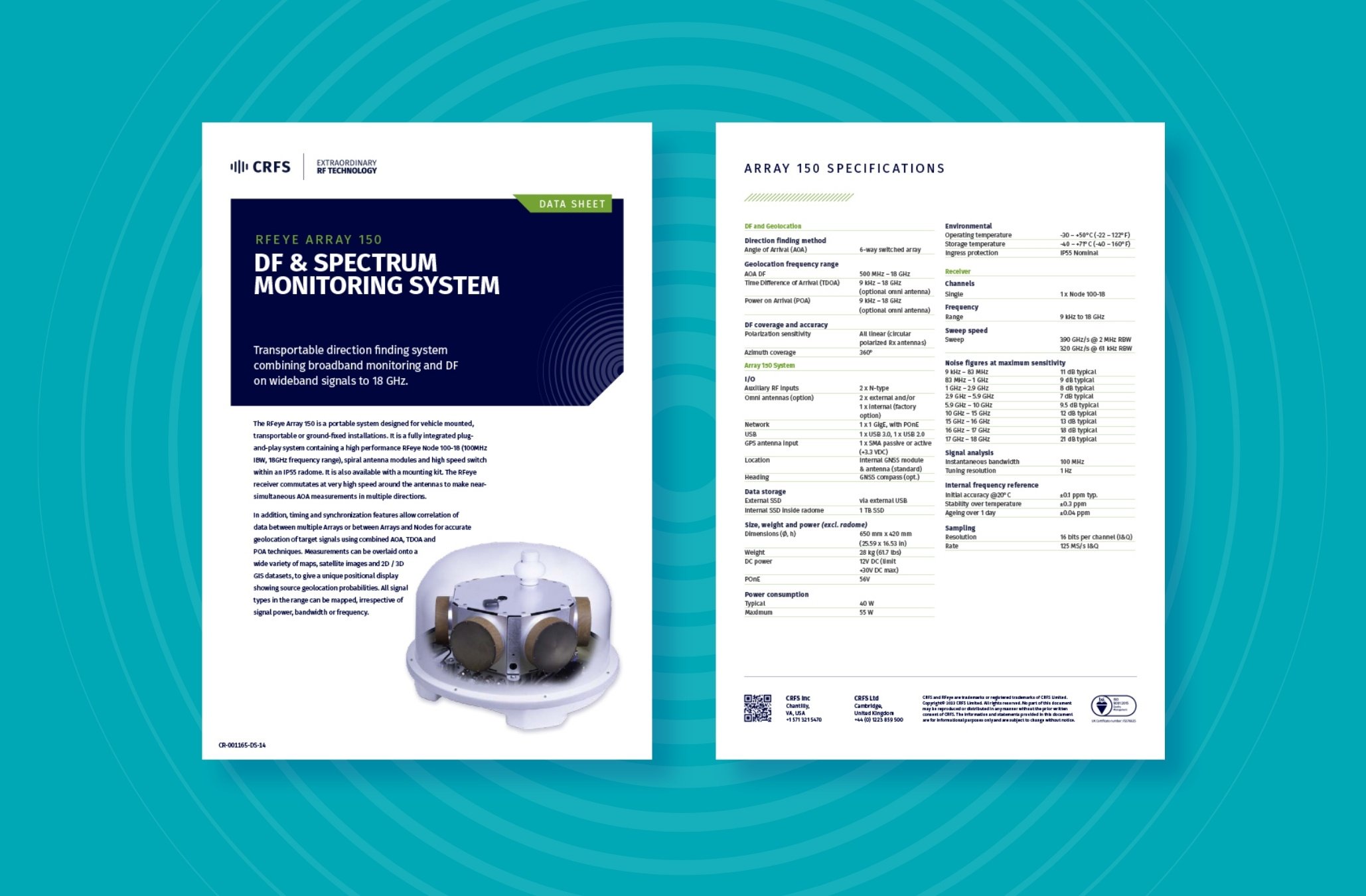 Data sheet
Data sheet
RFeye Array 150
Transportable direction finding system combining broadband monitoring and DF on wideband signals to 18 GHz.
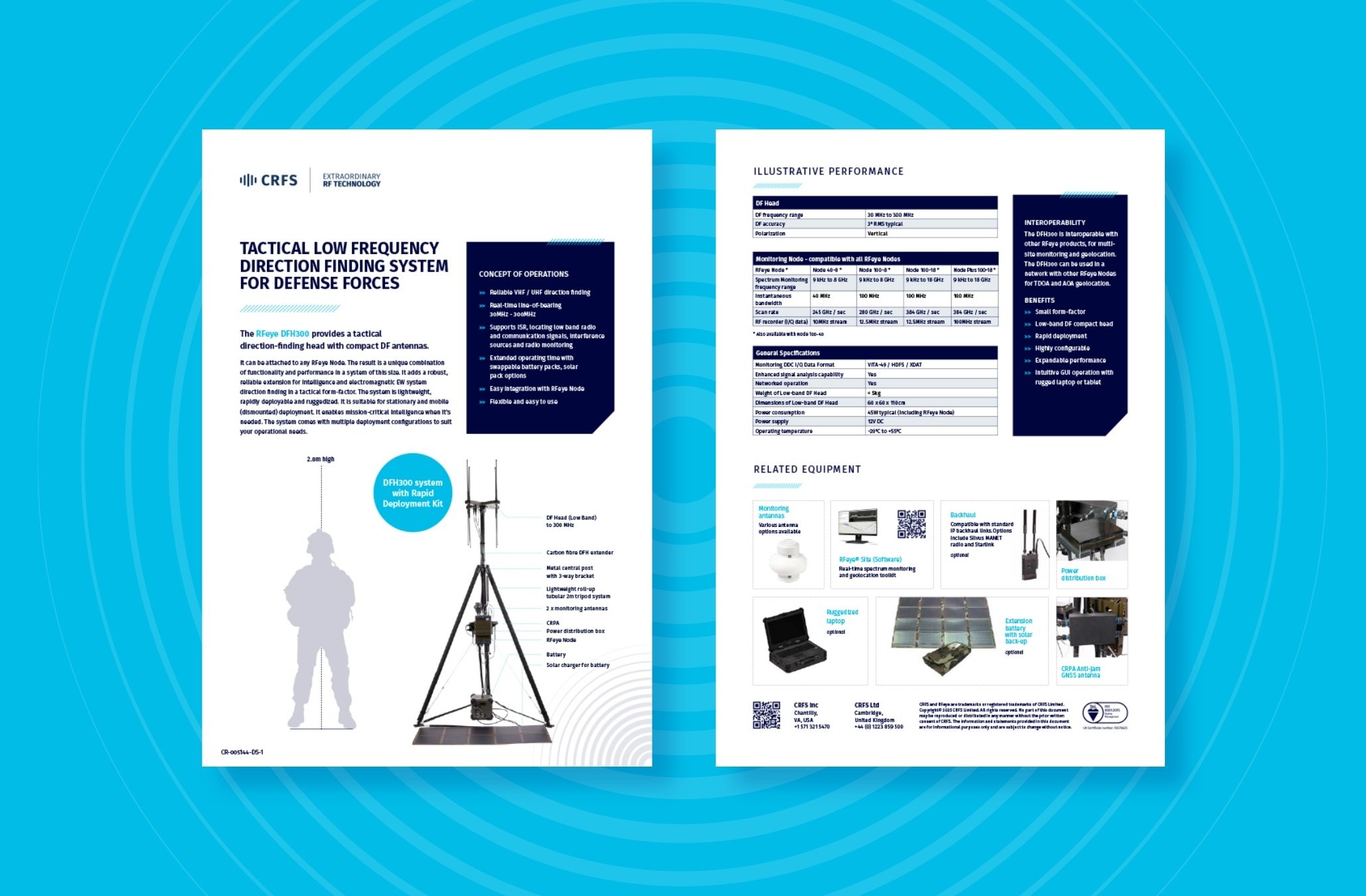 Data sheet
Data sheet
RFeye DFH300
Tactical direction-finding head with compact DF antennas.
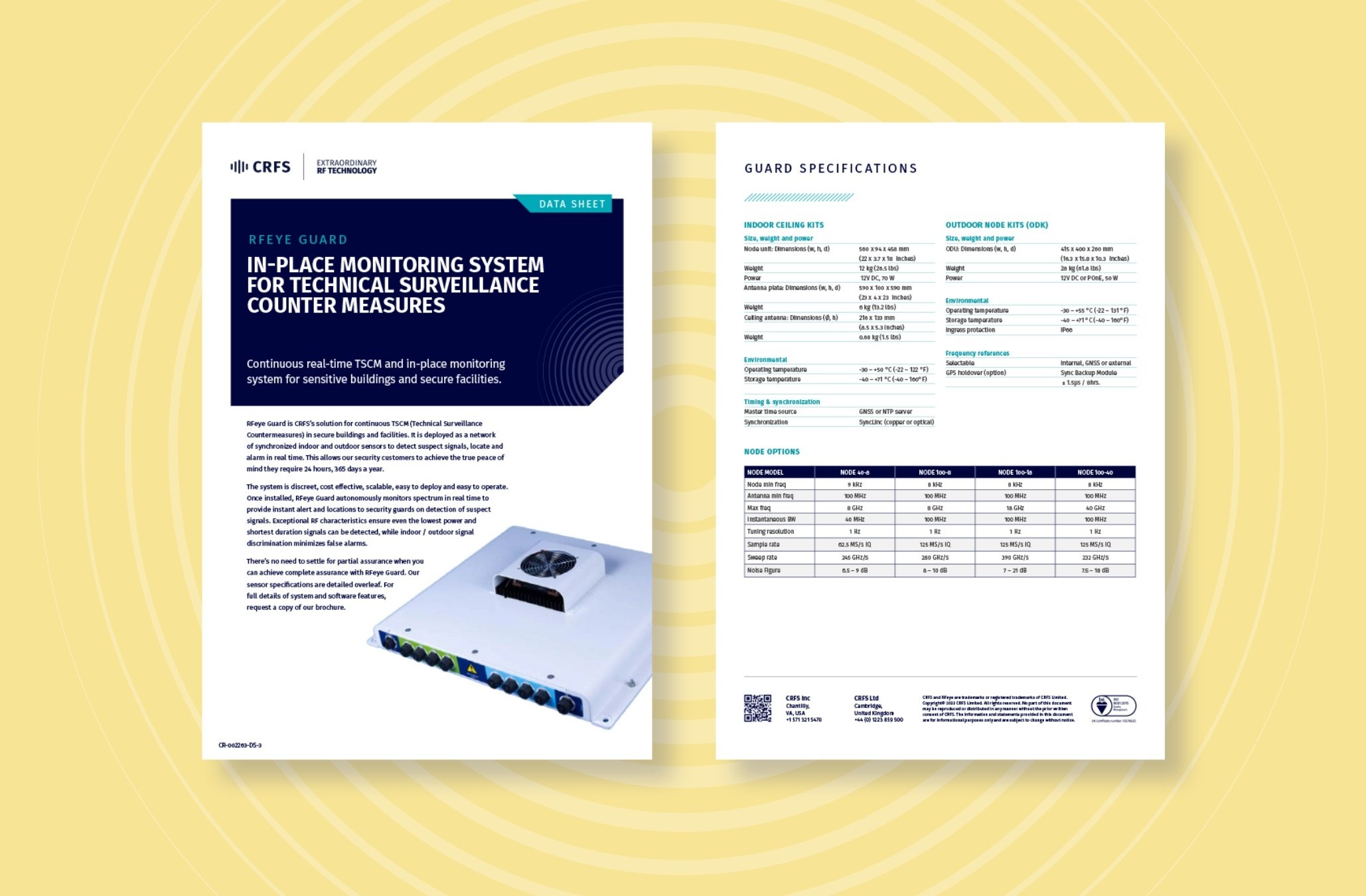 Data sheet
Data sheet
RFeye Guard
Continuous real-time TSCM and in-place monitoring system for sensitive buildings and secure facilities.
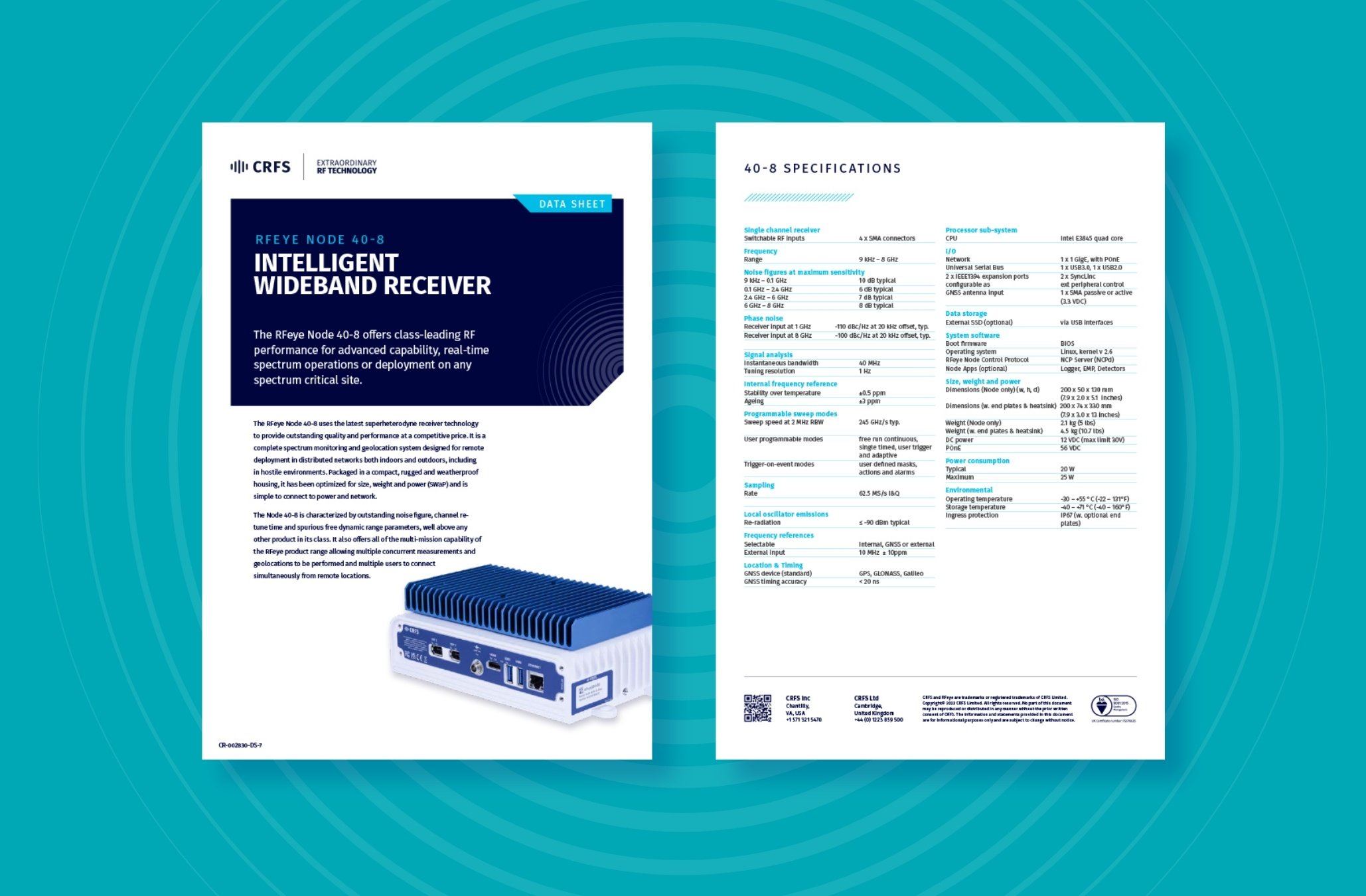 Data sheet
Data sheet
RFeye Node 40-8
Class-leading RF performance for advanced capability, real-time spectrum operations or deployment on any spectrum critical site.
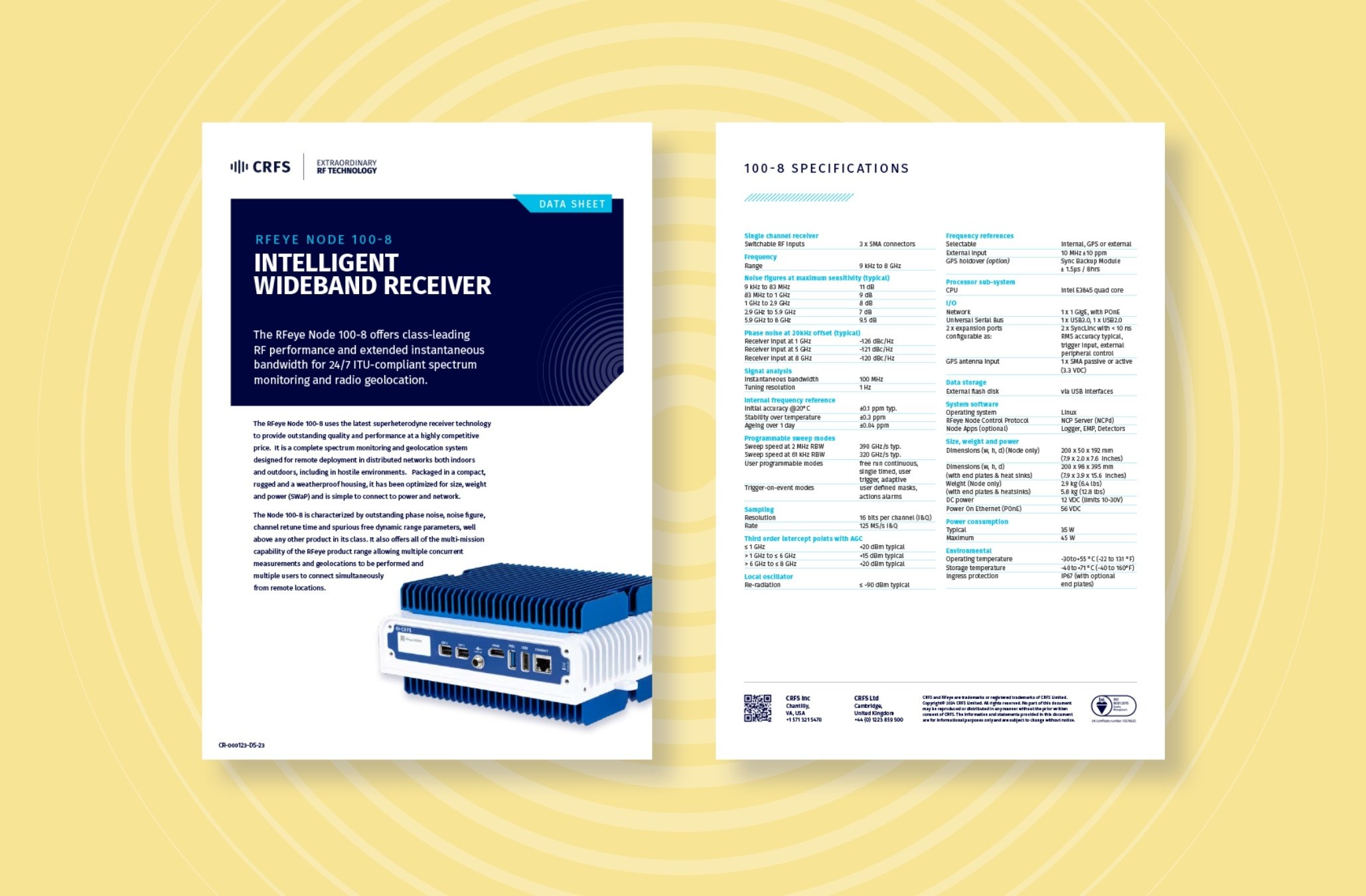 Data sheet
Data sheet
RFeye Node 100-8
Class-leading RF performance and extended instantaneous bandwidth for 24/7 ITU-compliant spectrum monitoring and radio geolocation.
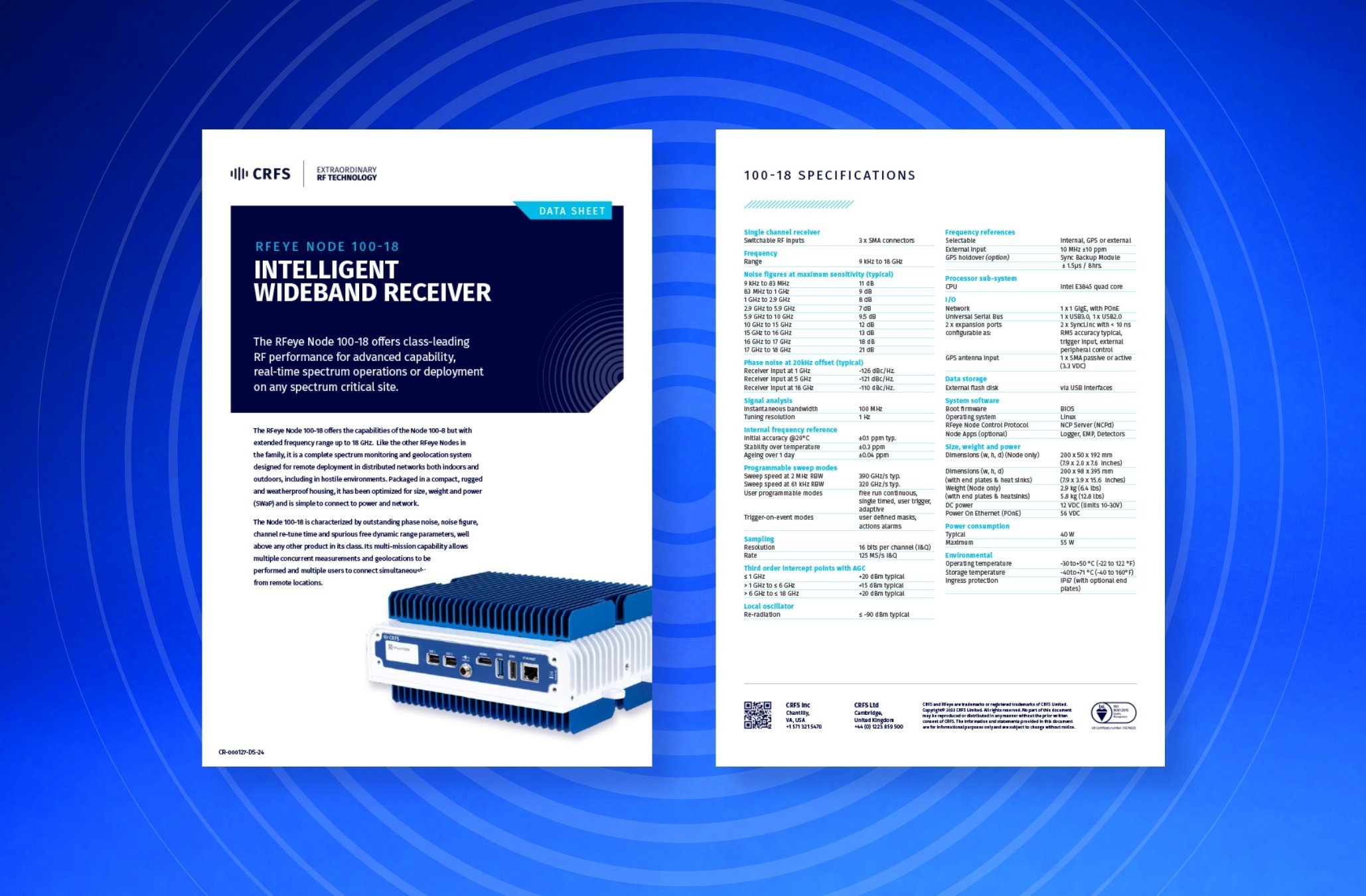 Data sheet
Data sheet
RFeye Node 100-18
Class-leading RF performance for advanced capability, real-time spectrum operations or deployment on any spectrum critical site.
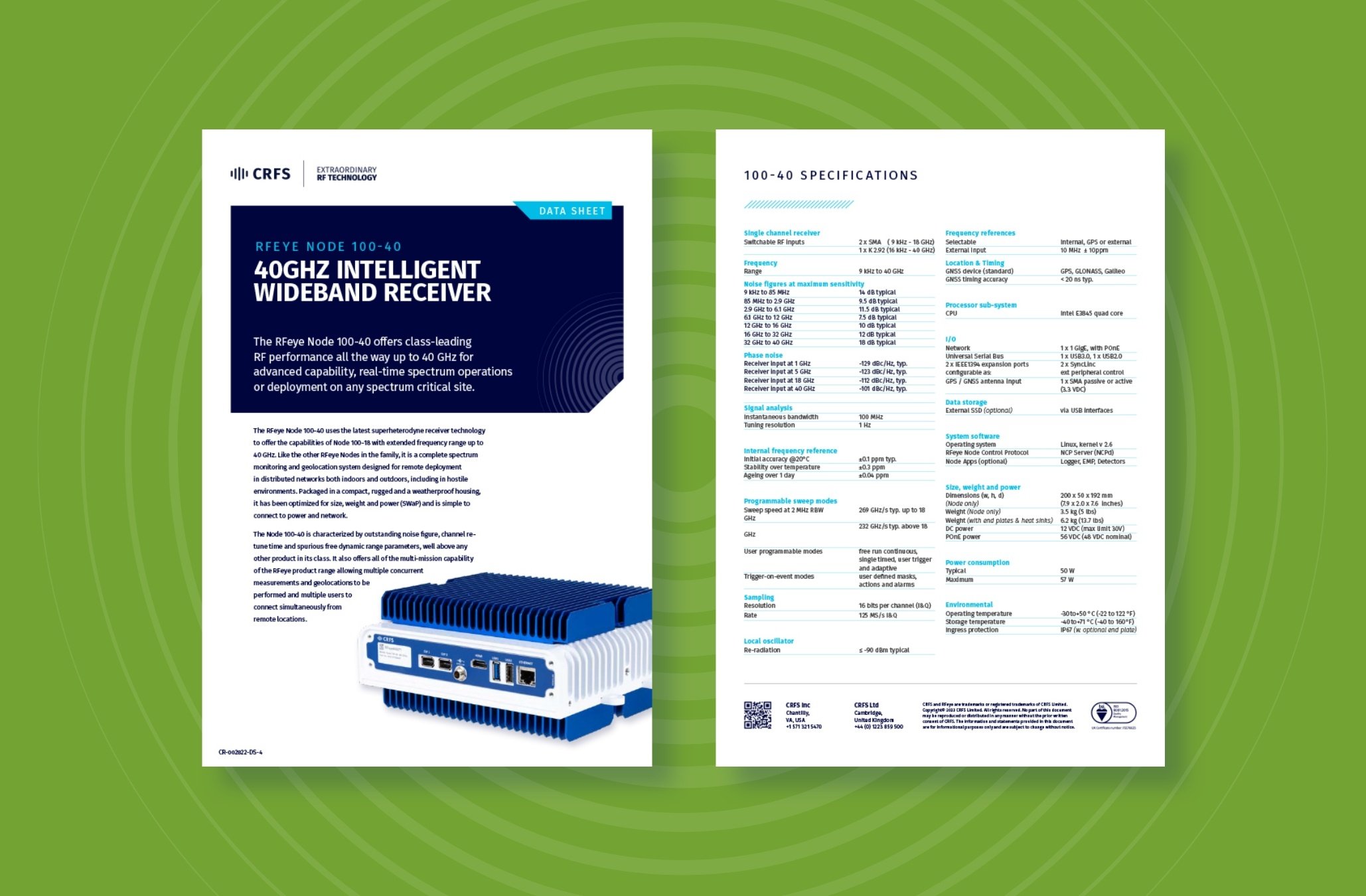 Data sheet
Data sheet
RFeye Node 100-40
RF performance all the way up to 40 GHz for advanced capability, real-time spectrum operations or deployment on any spectrum critical site.
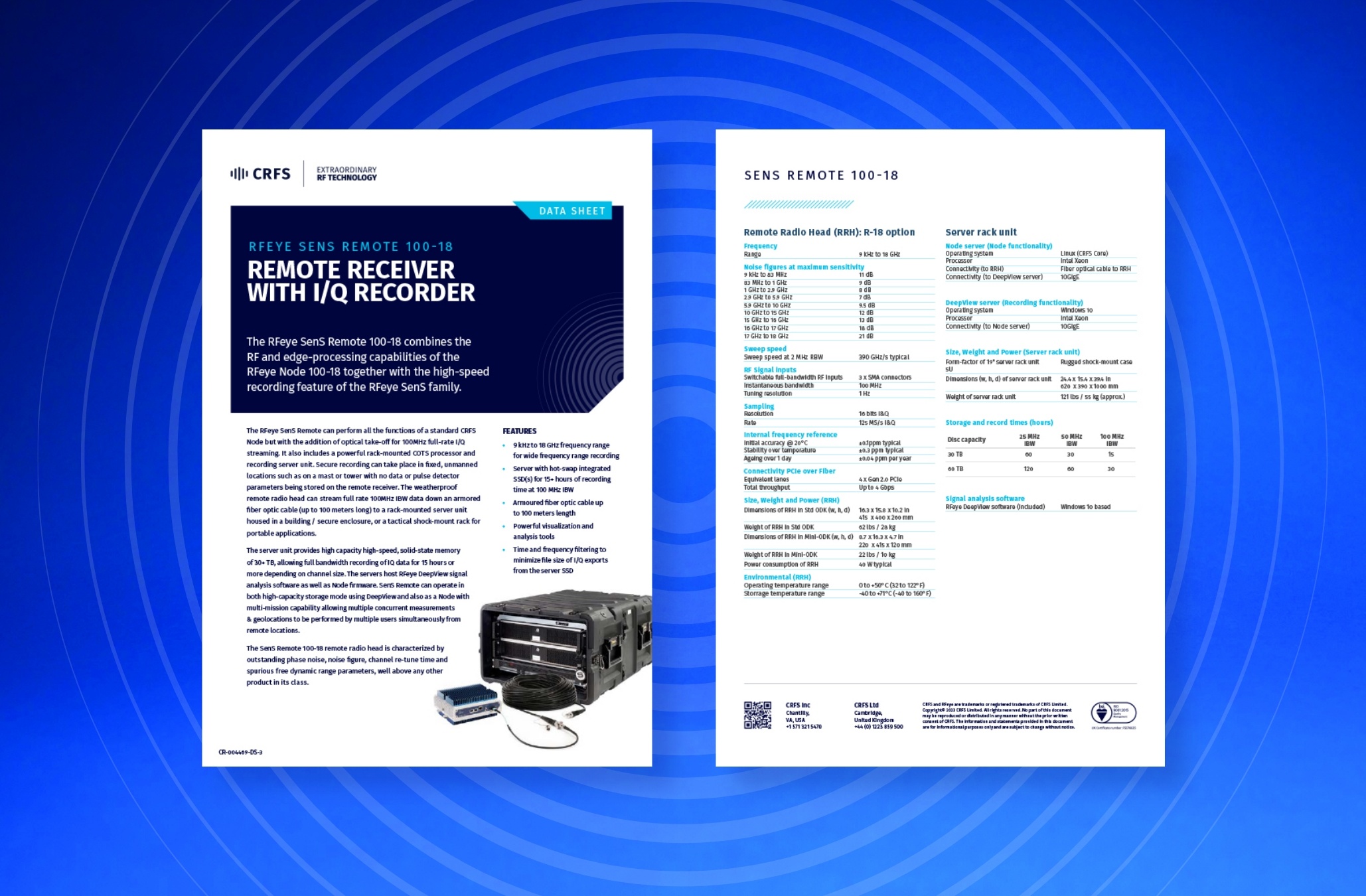 Data sheet
Data sheet
RFeye Sens Remote 100-18
The RFeye SenS Remote 100-18 combines the RF and edge-processing capabilities of the RFeye Node 100-18 together with the high-speed recording feature of the RFeye SenS family.
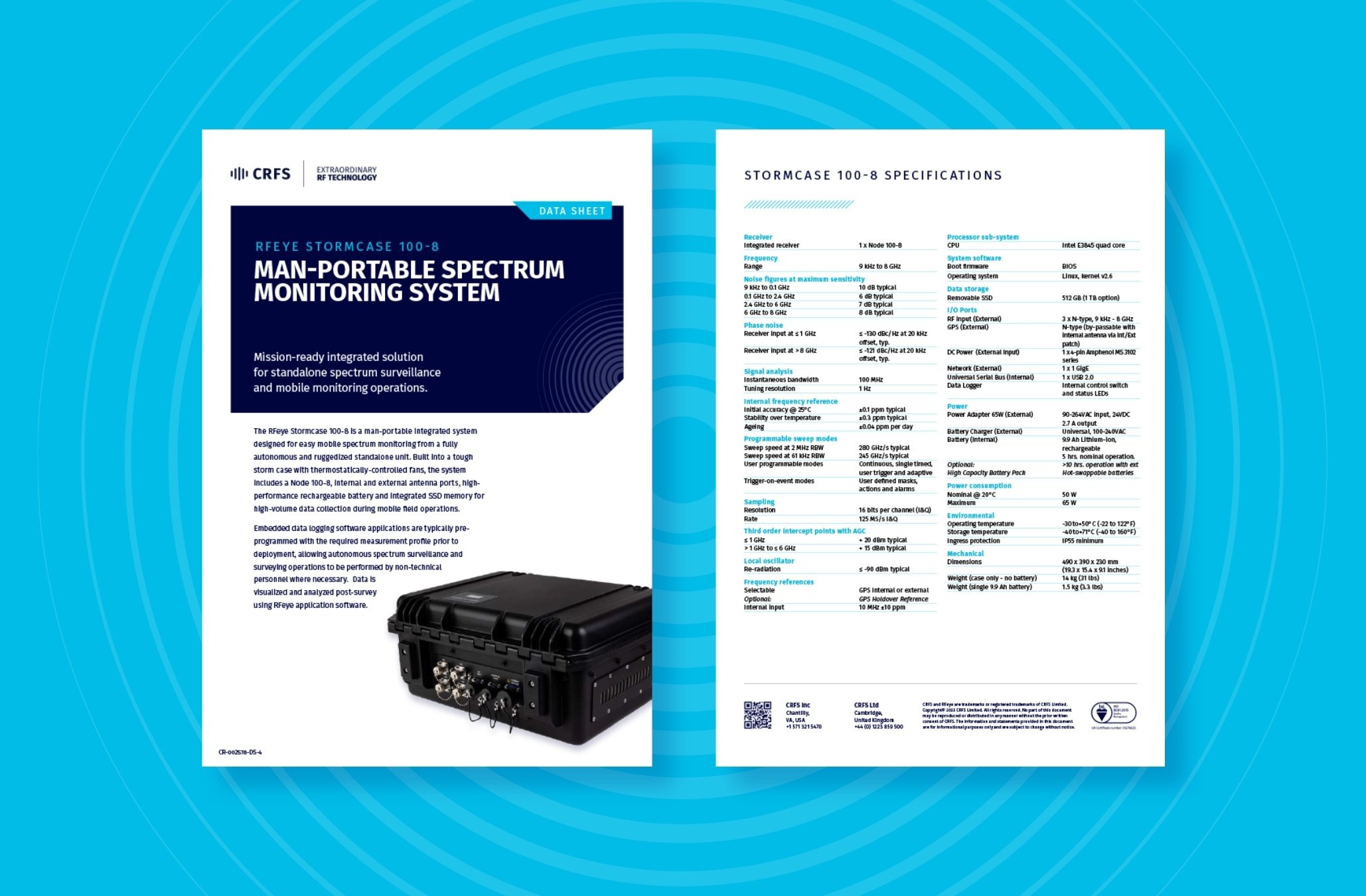 Data sheet
Data sheet
RFeye Stormcase 100-8
Mission-ready integrated solution for standalone spectrum surveillance and mobile monitoring operations
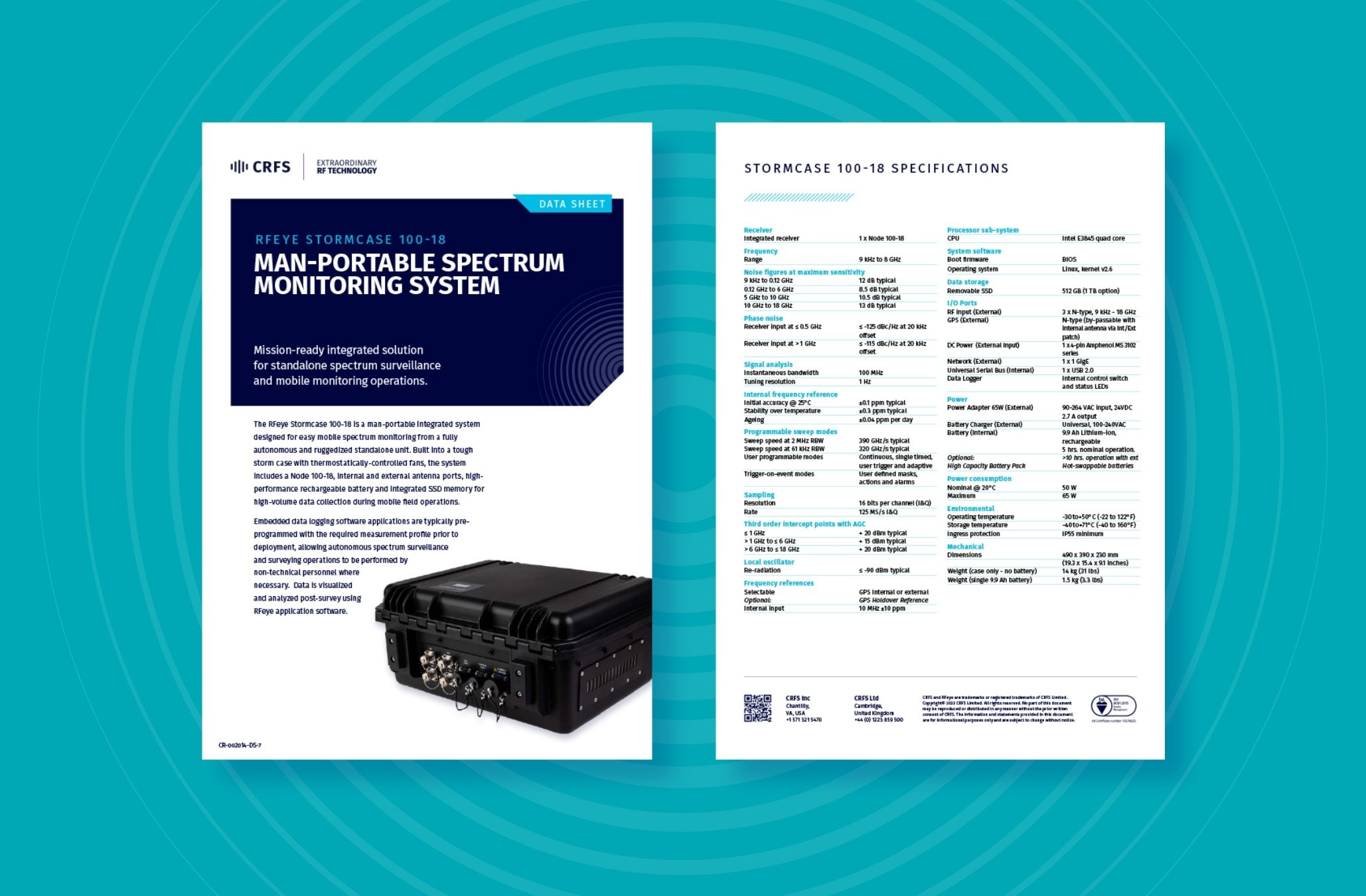 Data sheet
Data sheet
RFeye Stormcase 100-18
Mission-ready integrated solution for standalone spectrum surveillance and mobile monitoring operations
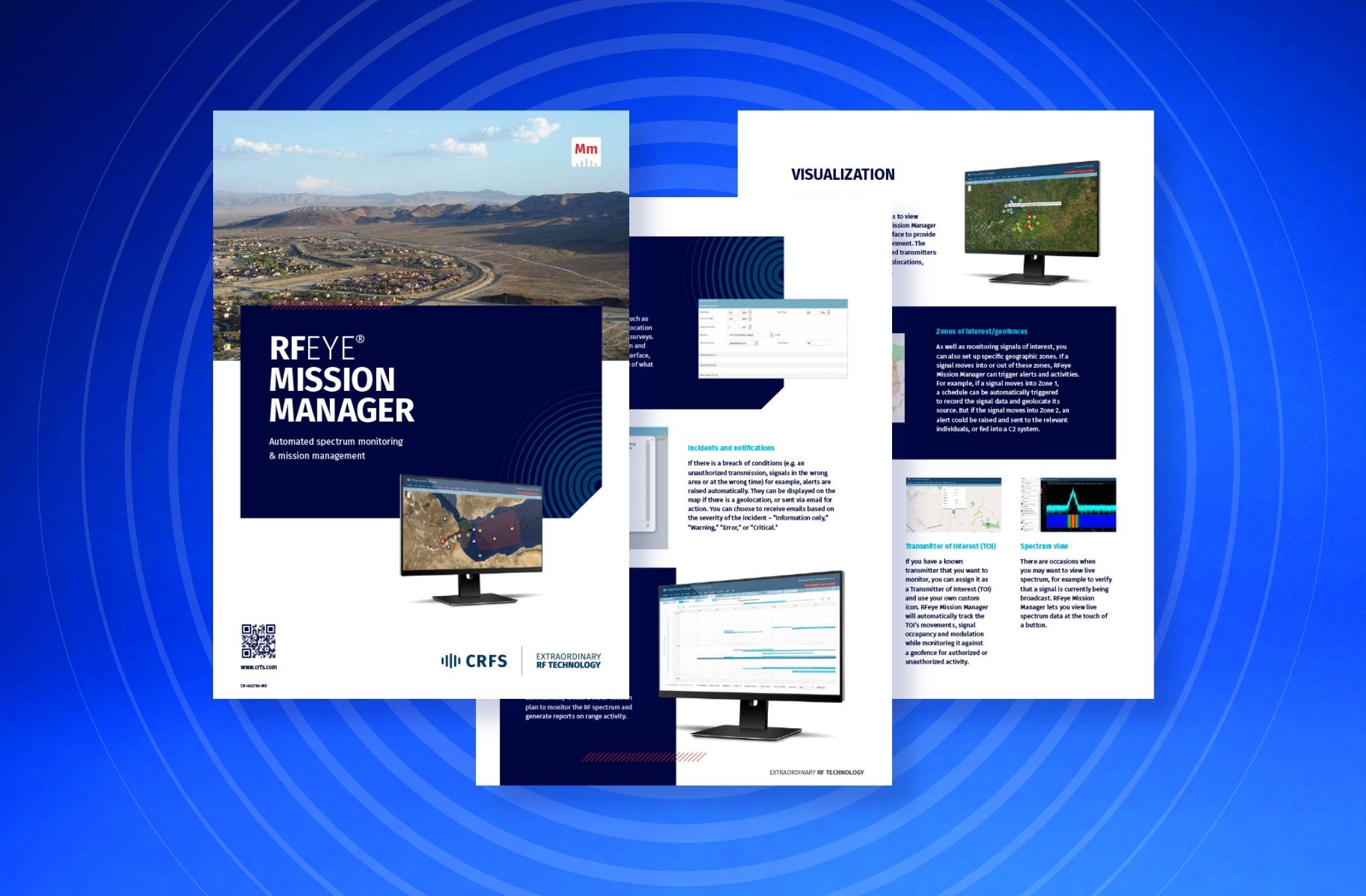 Brochures, Guides & Survey's
Brochures, Guides & Survey's
RFeye Mission Manager
Schedule & automate spectrum monitoring in multi-user environments
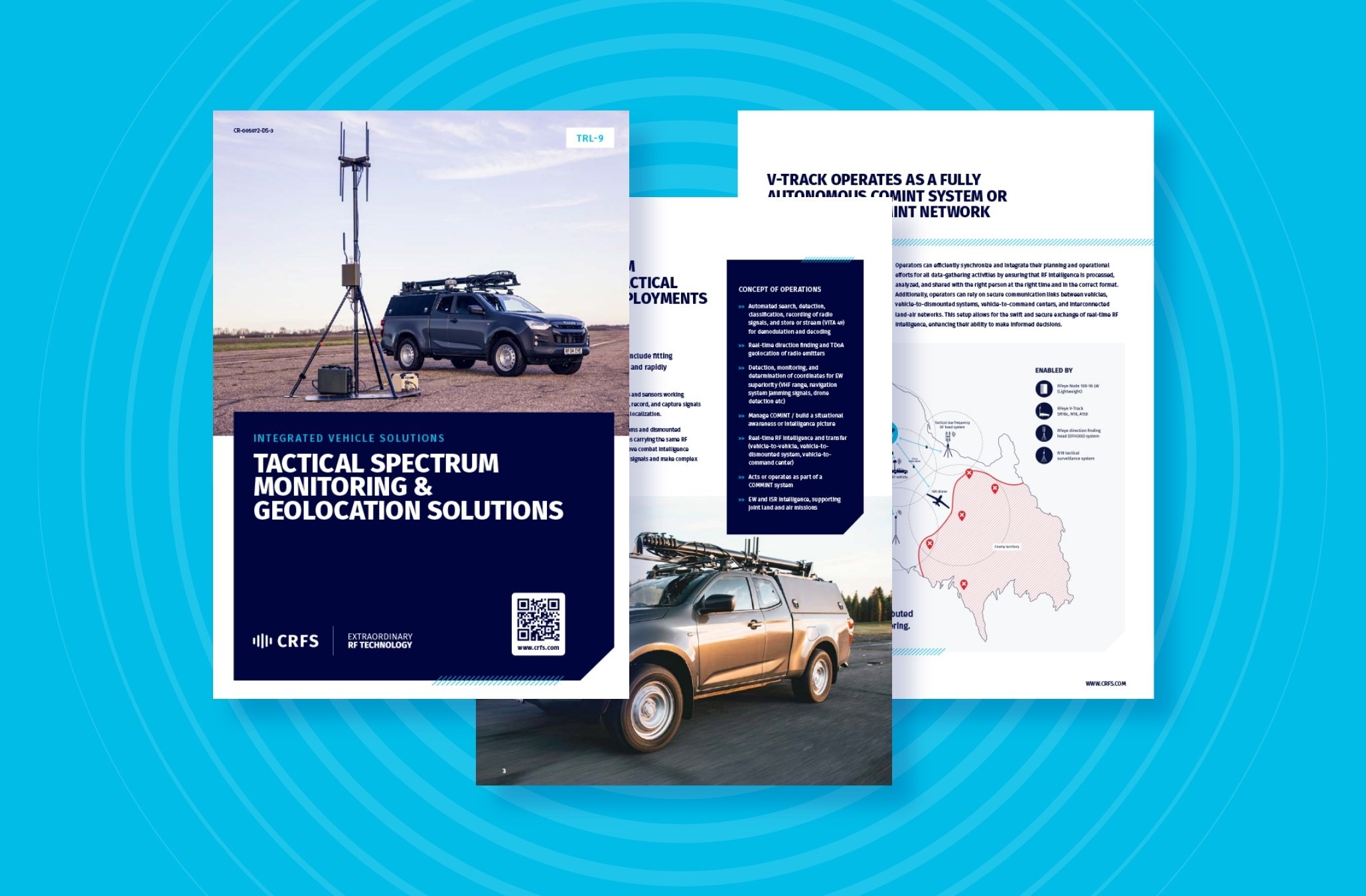 Brochures, Guides & Survey's
Brochures, Guides & Survey's
Tactical spectrum monitoring & geolocation solutions
Tactical spectrum monitoring & geolocation solutions
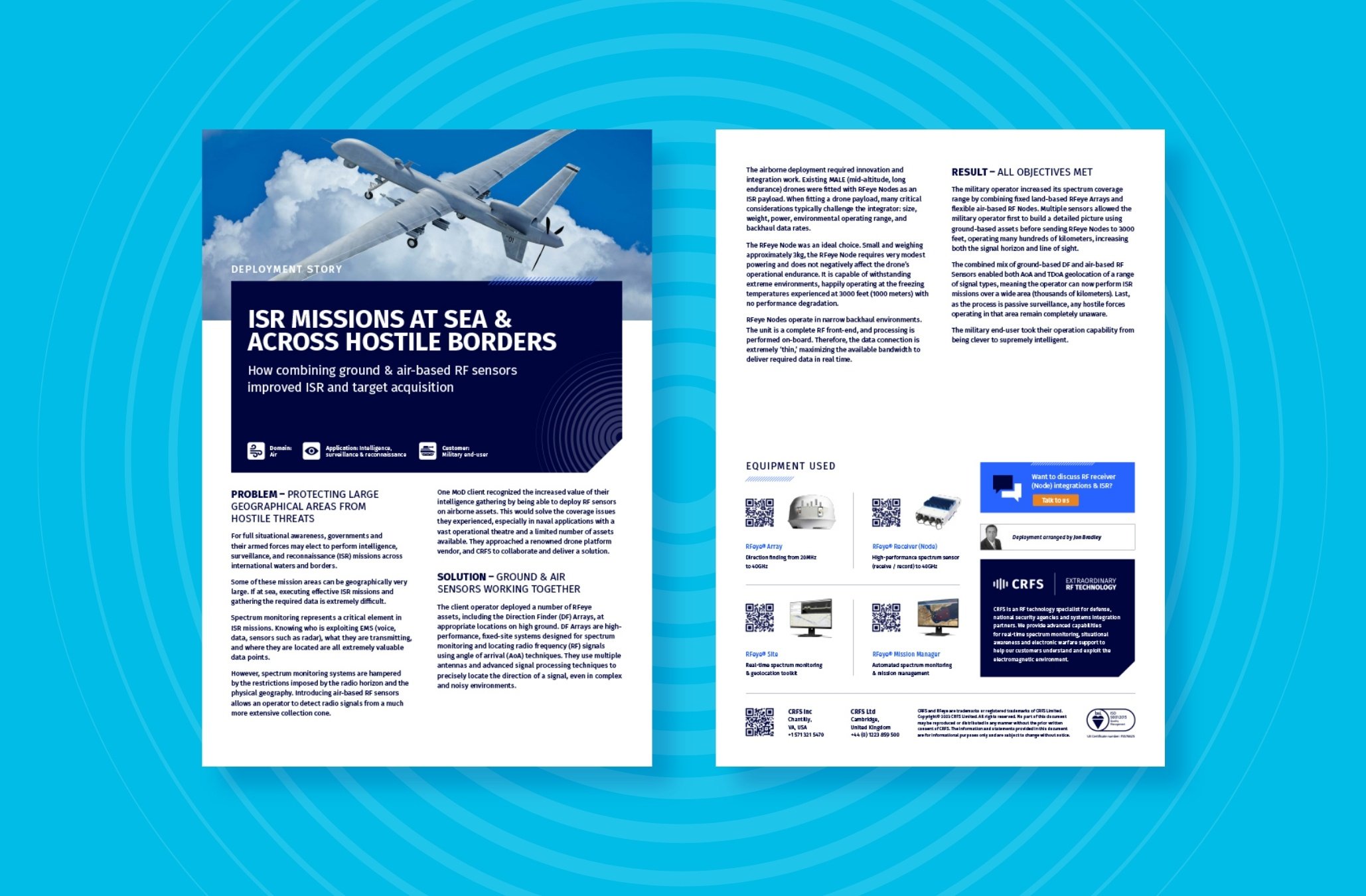 Deployment story
Deployment story
ISR missions at sea & across hostile borders
How combining ground & air-based RF sensors improved ISR and target acquisition
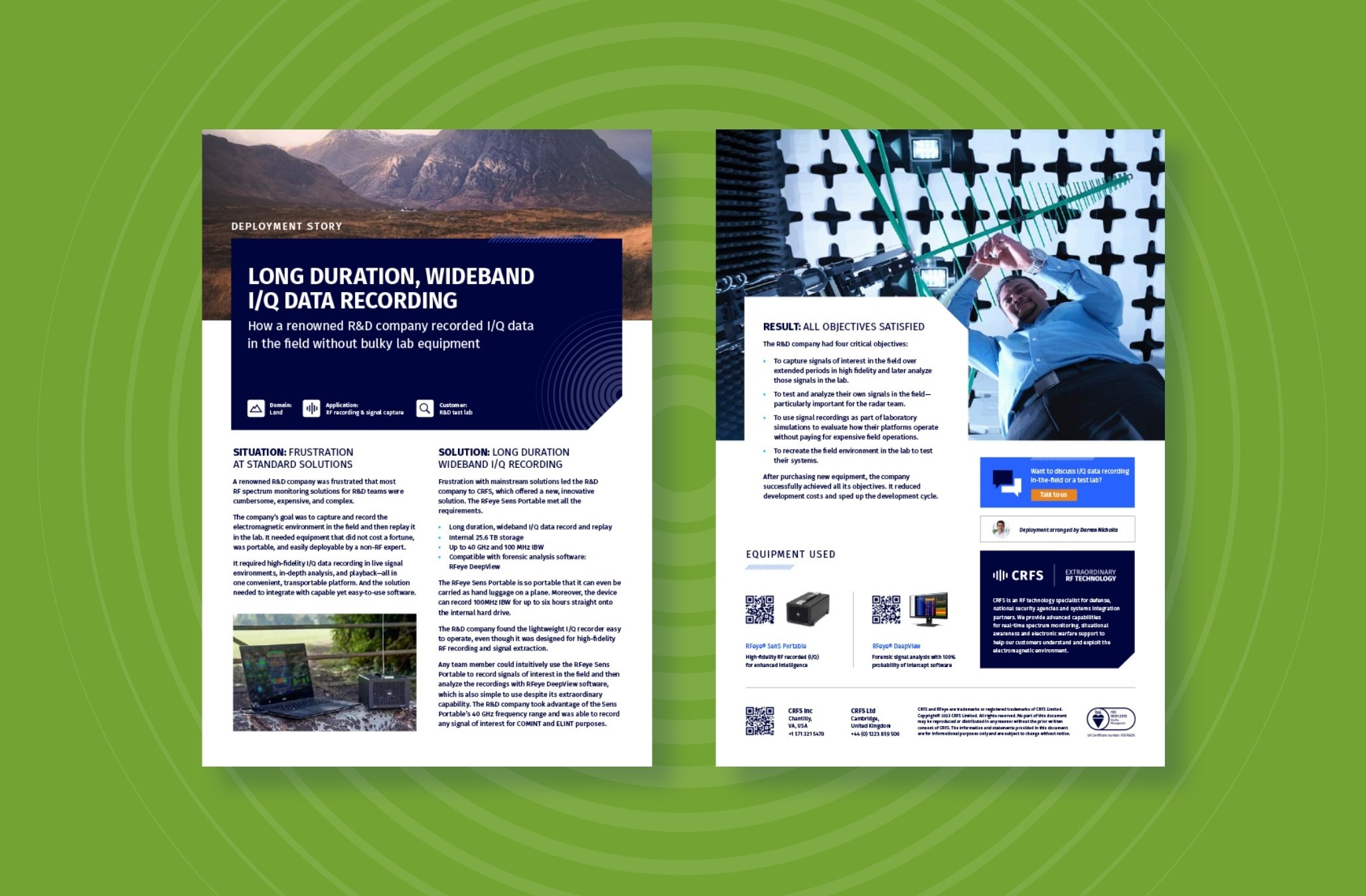 Deployment story
Deployment story
Long duration, wideband I/Q data recording
How a renowned R&D company recorded I/Q data in the field without bulky lab equipment
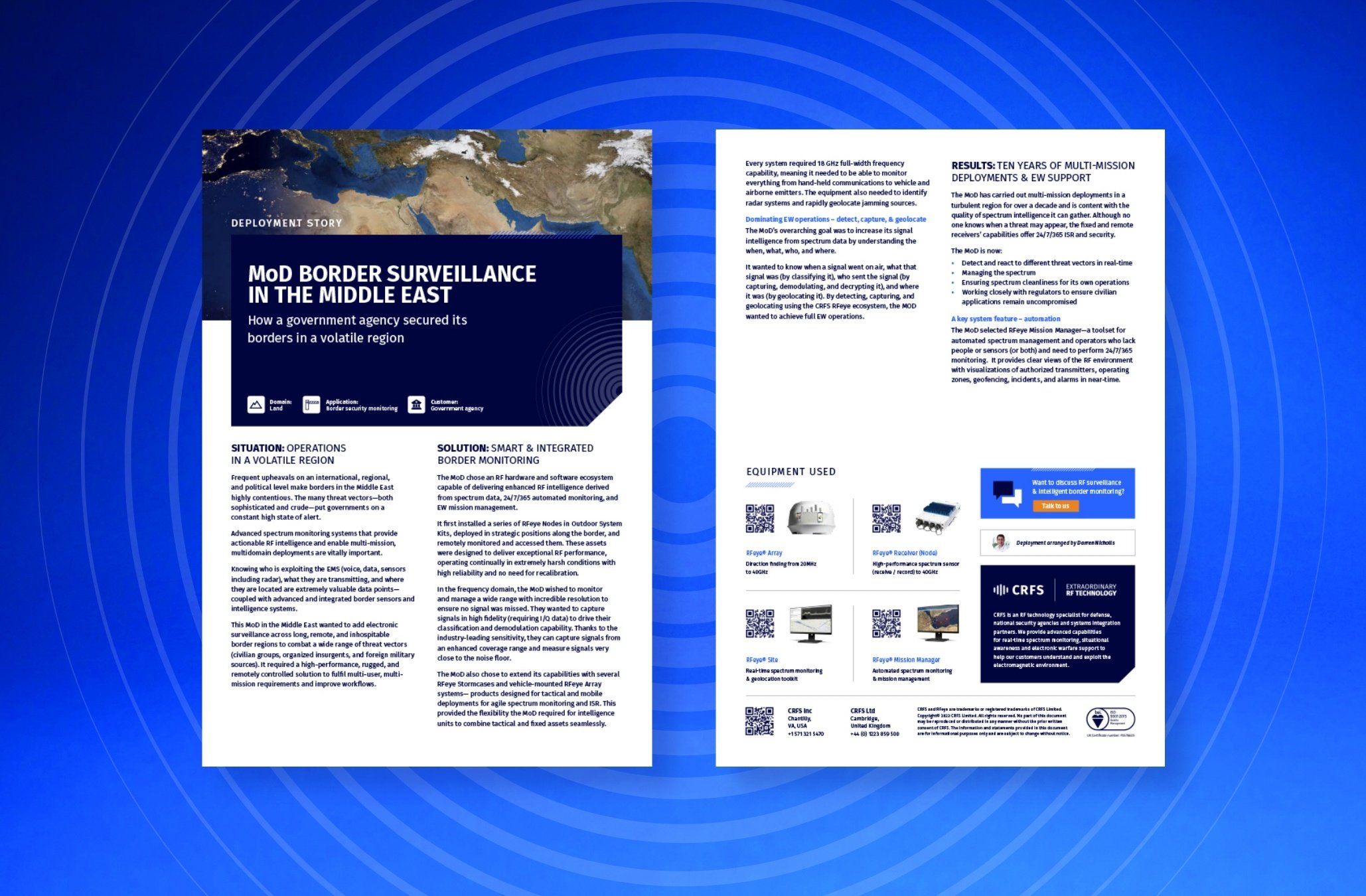 Deployment story
Deployment story
MoD border surveillance in the middle east
How a government agency secured its borders in a volatile region
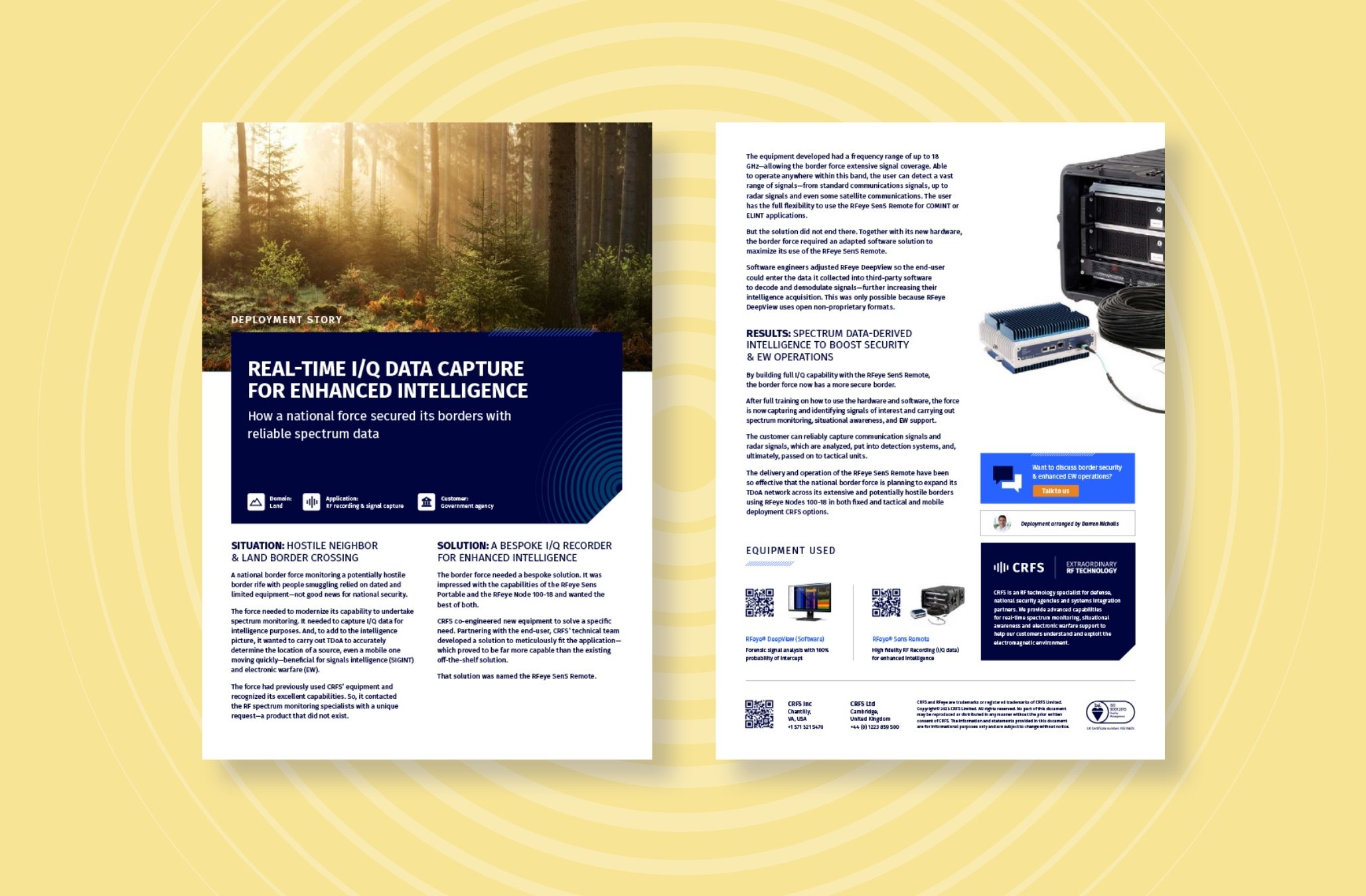 Deployment story
Deployment story
Real-time I/Q data capture for enhanced intelligence
How a national force secured its borders with reliable spectrum data
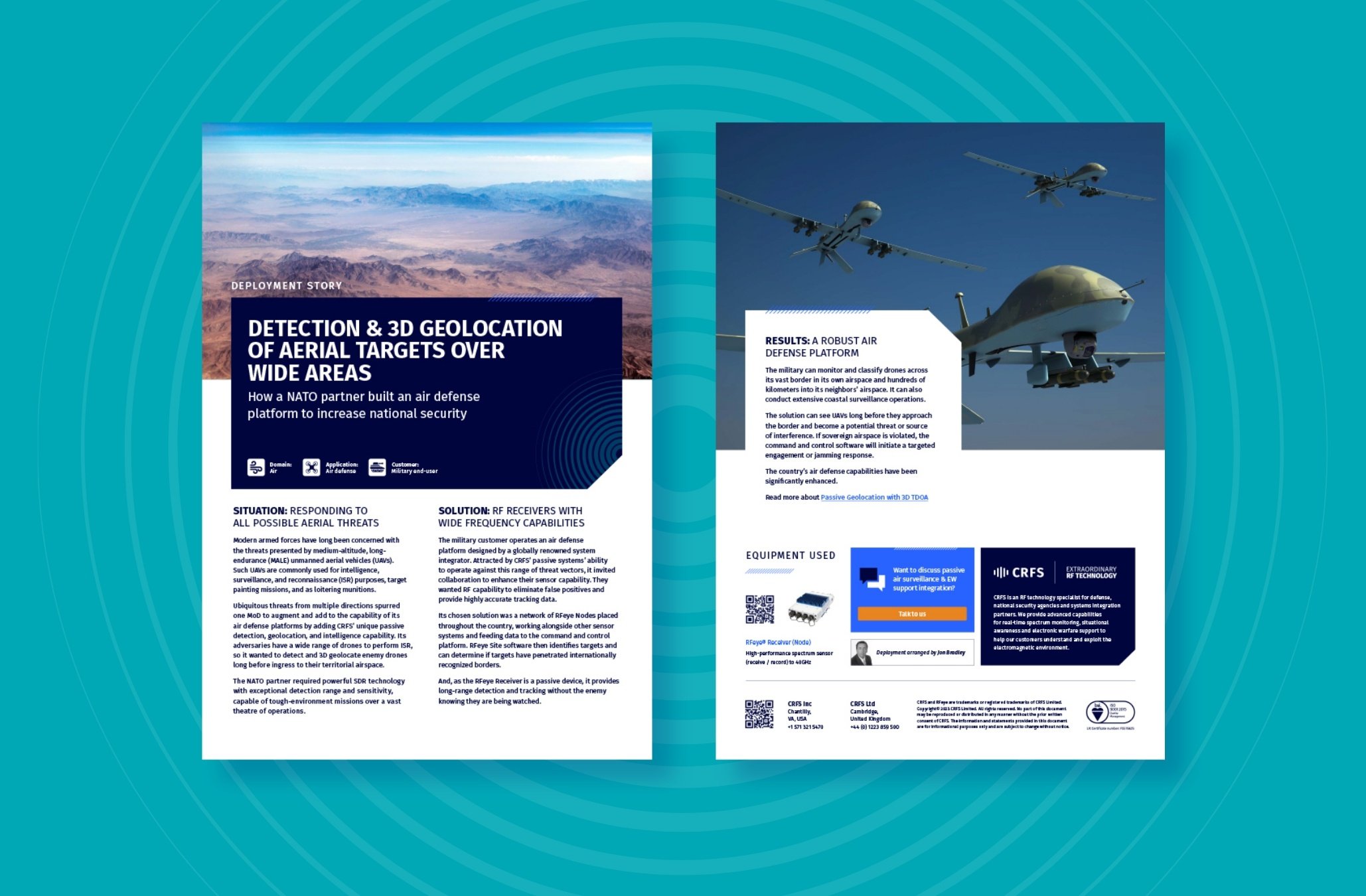 Deployment story
Deployment story
Detection & 3d geolocation of aerial targets over wide areas
How a NATO partner built an air defense platform to increase national security
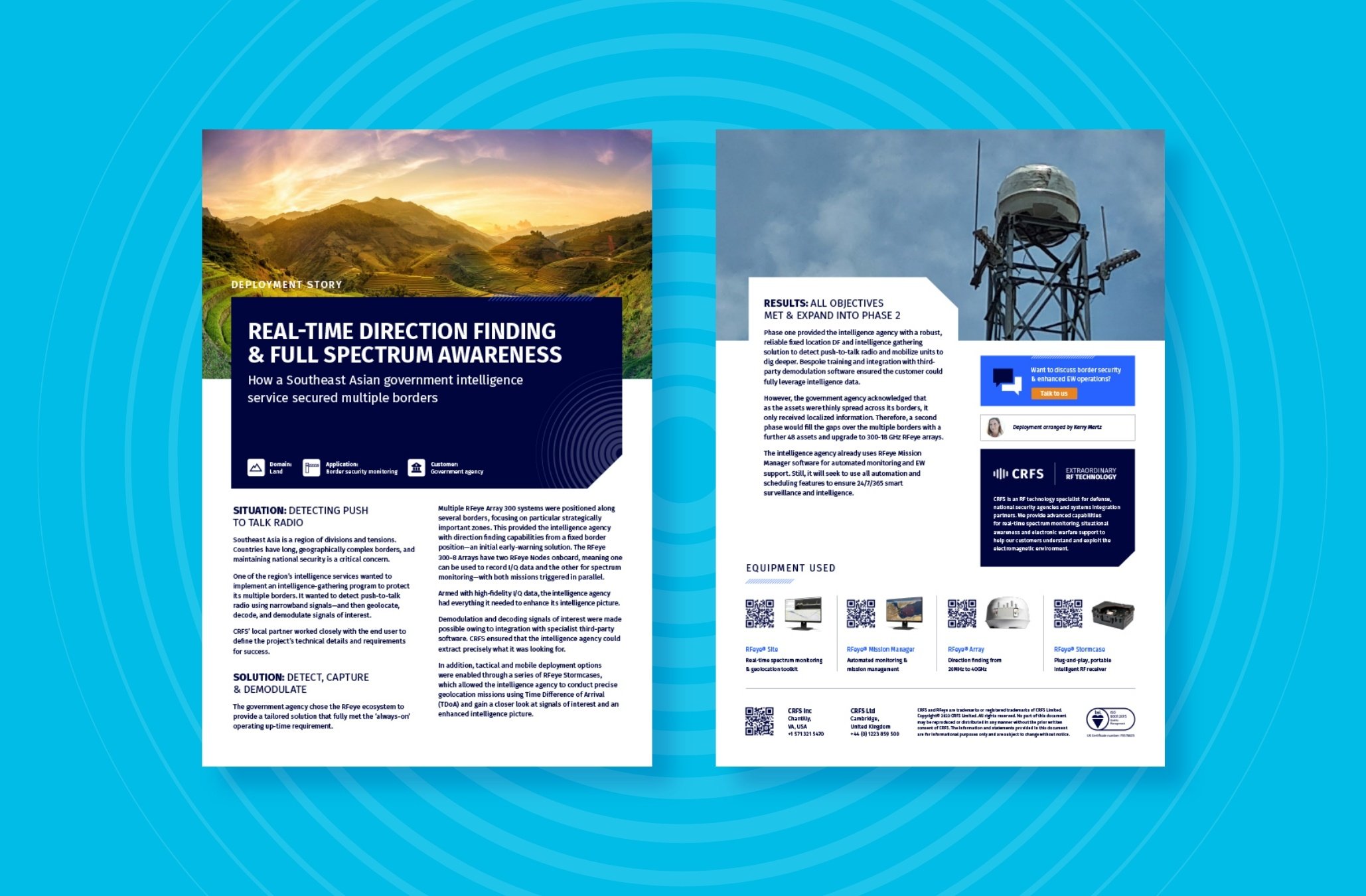 Deployment story
Deployment story
Real-time direction finding & full spectrum awareness
How a Southeast Asian government intelligence service secured multiple borders
 Deployment story
Deployment story
Upgrading legacy systems for proactive spectrum management
How the Malta Communications Authority replaced old equipment with state-of-the-art solutions
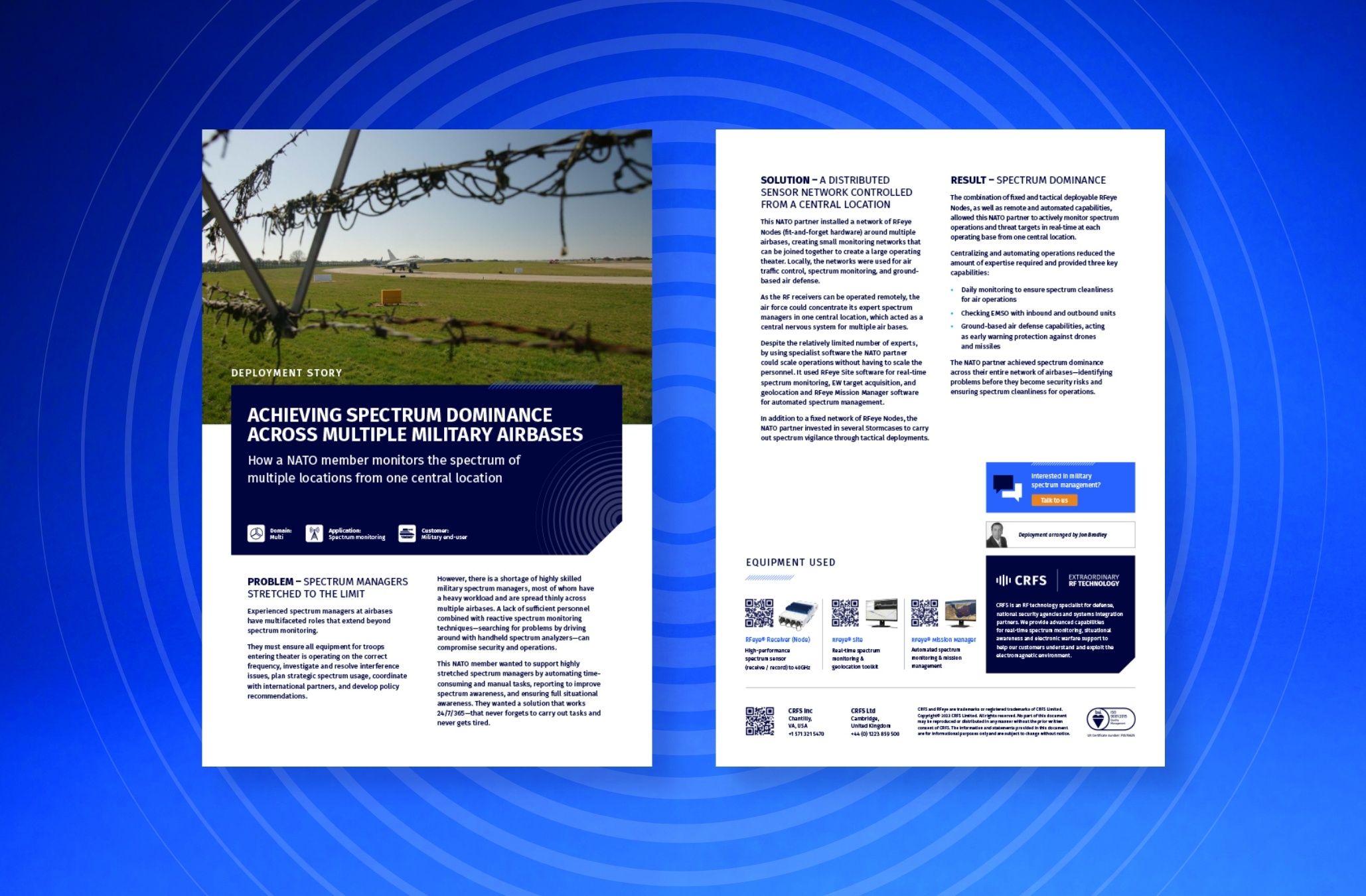 Deployment story
Deployment story
Achieving spectrum dominance across multiple military airbases
How a NATO member monitors the spectrum of multiple locations from one central location
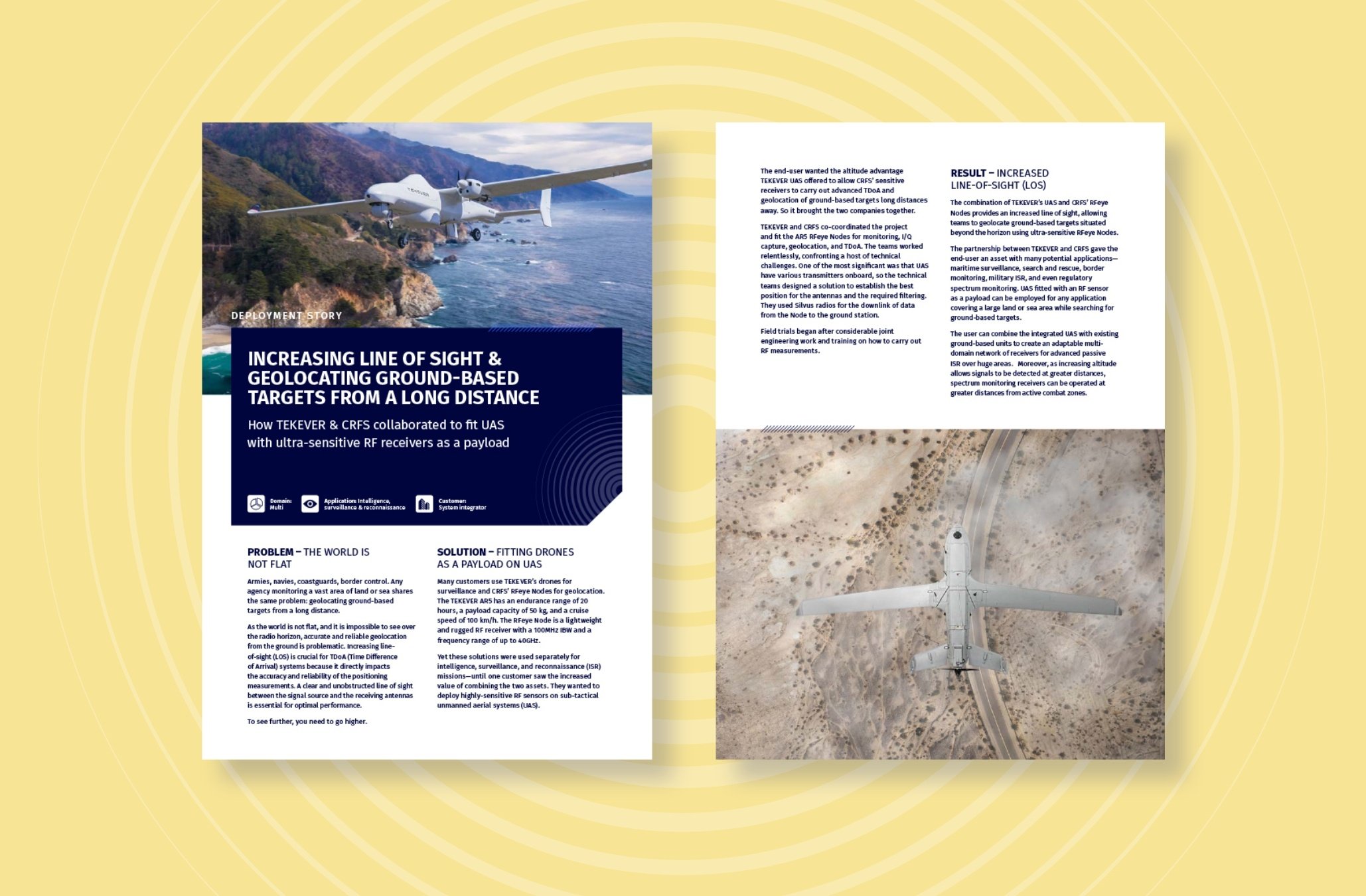 Deployment story
Deployment story
Increasing line of sight & geolocating ground-based targets from a long distance
How TEKEVER & CRFS collaborated to fit UAS with ultra-sensitive RF receivers as a payload
 Deployment story
Deployment story
Spectrum monitoring & management at the Rio summer Olympics
How the Brazilian National Telecoms Agency used a remote distributed network at the world’s biggest sporting event
 Deployment story
Deployment story
Ensuring RF spectrum security at a highly secure facility
How a security service detects and geolocates unwanted signals to safeguard national security
 Deployment story
Deployment story
Proactive RF interference hunting & data collection
How Rijksinspectie Digitale Infrastructuur embraced effective spectrum monitoring (and caught criminals in the process)
 Deployment story
Deployment story
Detecting RF interference at one of the world’s busiest spaceports
How a spaceport operator ensures the integrity of its payloads with 24/7/365 RF monitoring
 Deployment story
Deployment story
Managing spectrum at the World Expo in Dubai
How the TDRA ensured seamless communication with an RF network that endured temperatures above 45°C
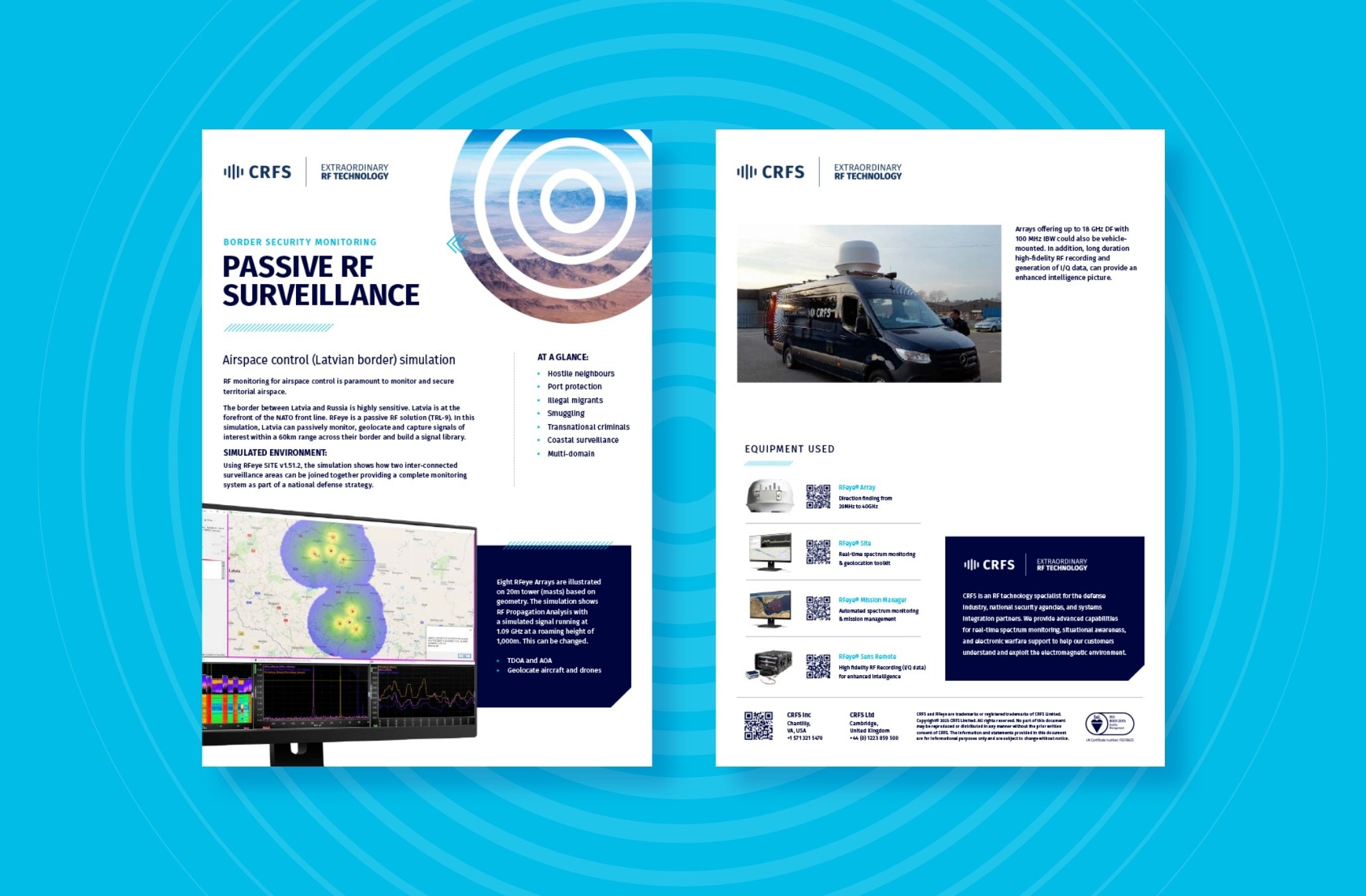 Brochures, Guides & Survey's
Brochures, Guides & Survey's
Border Security - Airspace simulation
Airspace control (Latvian border) simulation
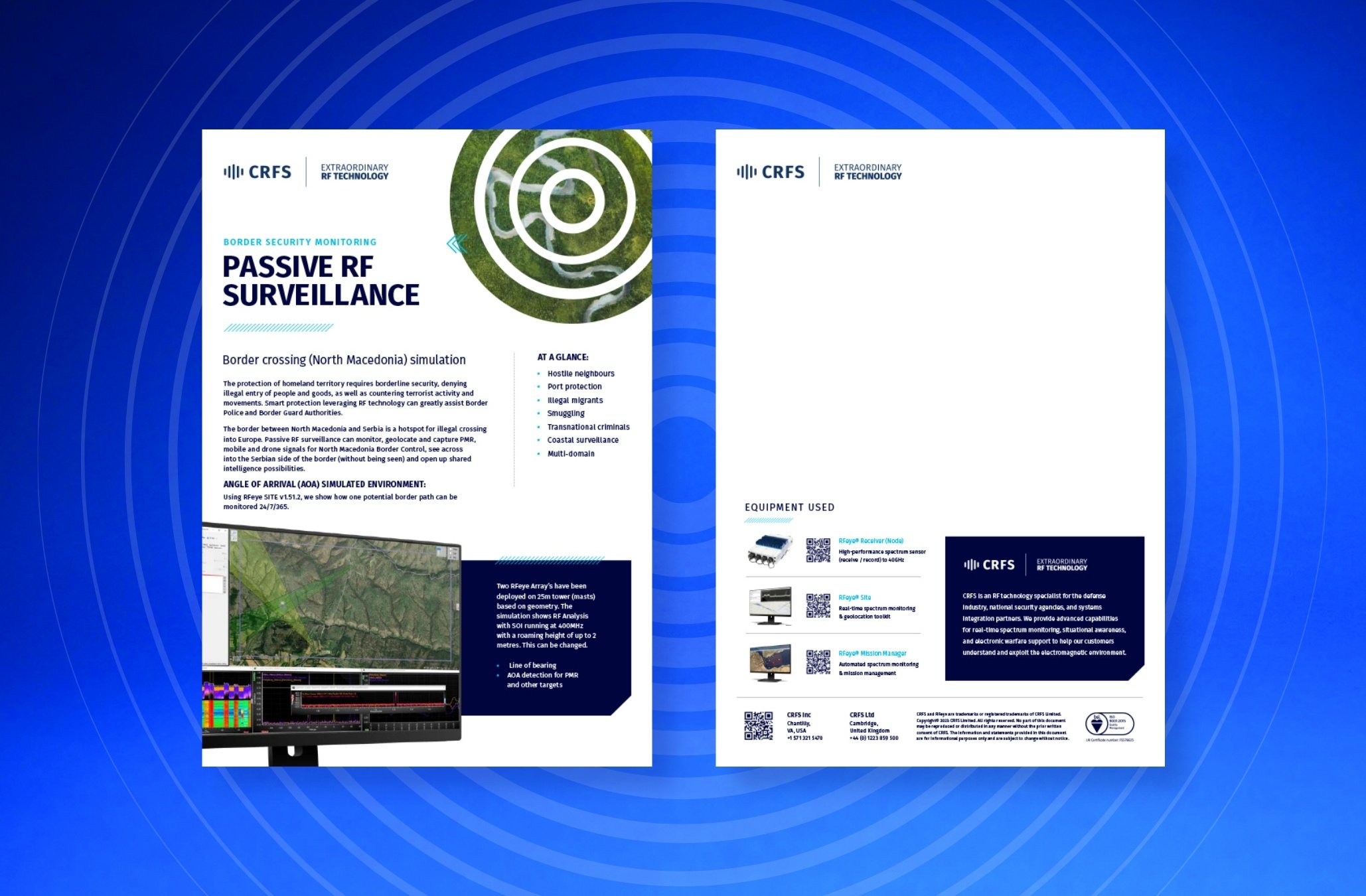 Brochures, Guides & Survey's
Brochures, Guides & Survey's
Border Security - Boarder Crossing simulation
Border crossing (North Macedonia) simulation
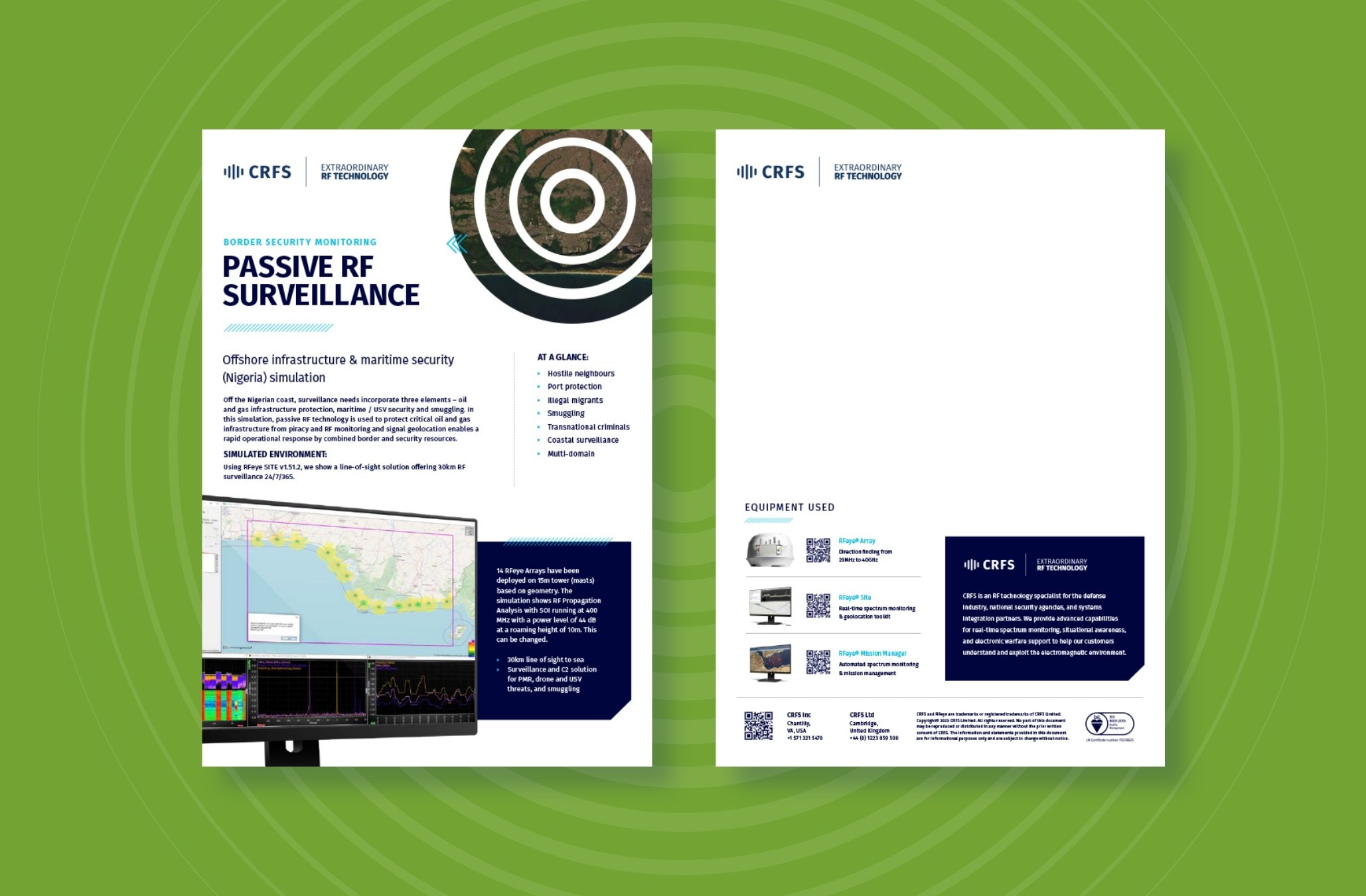 Brochures, Guides & Survey's
Brochures, Guides & Survey's
Border Security - OffShore simulation
Offshore infrastructure & maritime security (Nigeria) simulation
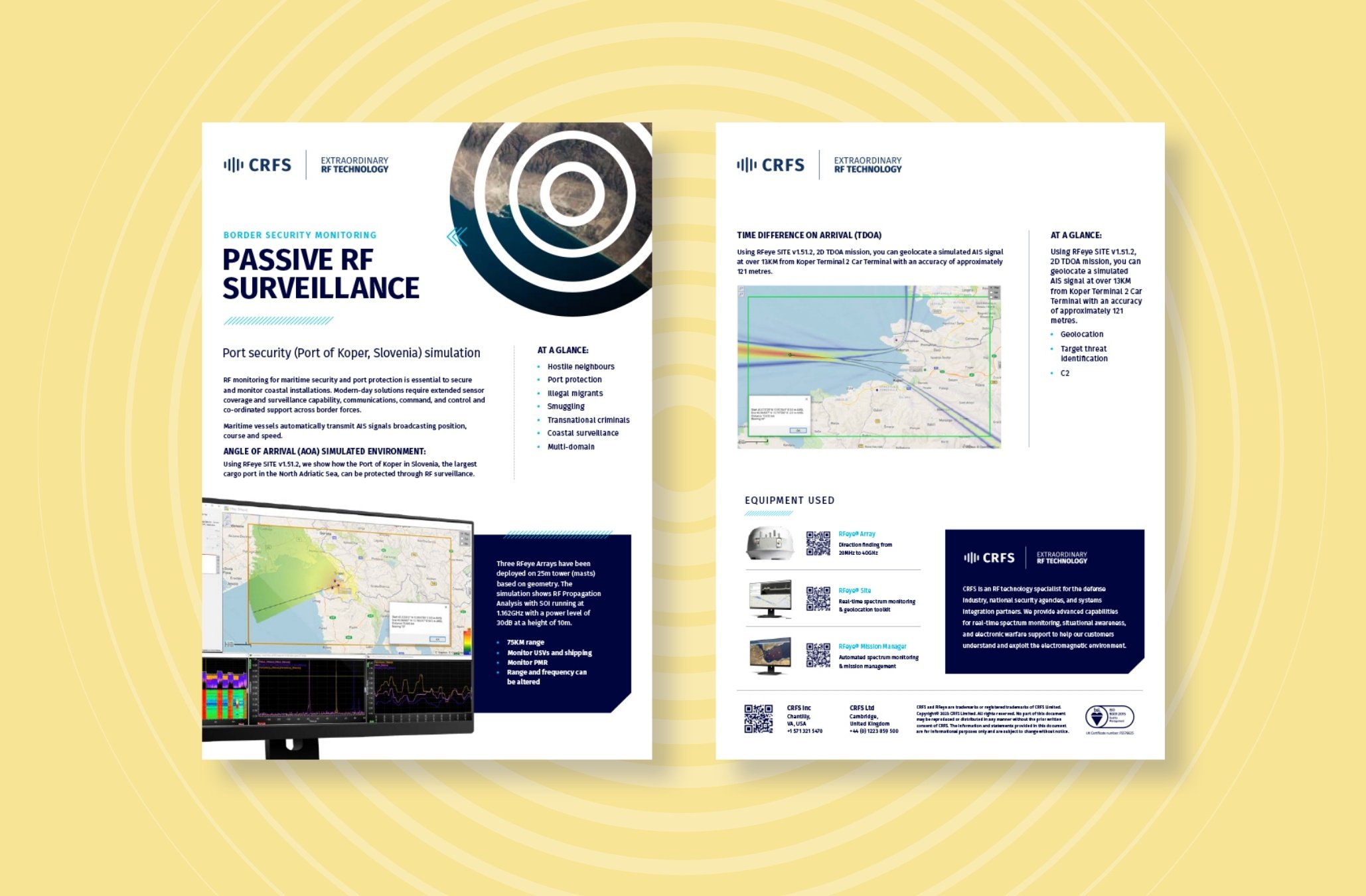 Brochures, Guides & Survey's
Brochures, Guides & Survey's
Border Security - Port simulation
Port security (Port of Koper, Slovenia) simulation
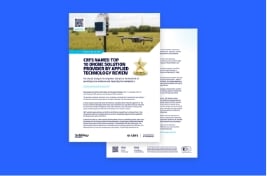 Press release
Press release
CRFS named top 10 drone solution provider by Applied Technology Review
The annual listing of 10 companies that are at the forefront of providing drone solutions and impacting the marketplace
 White papers & reports
White papers & reports
Making sense of radio frequency
RF matters because it is critical for today’s electronic devices – the foundation of our modern, wirelessly-connected lives.
 Brochures, Guides & Survey's
Brochures, Guides & Survey's
Survey - Enhancing border security with RF technology
CRFS sent border security agencies and forces across the globe a survey to understand their perspectives on integrating radio frequency (RF) technology into their operations.
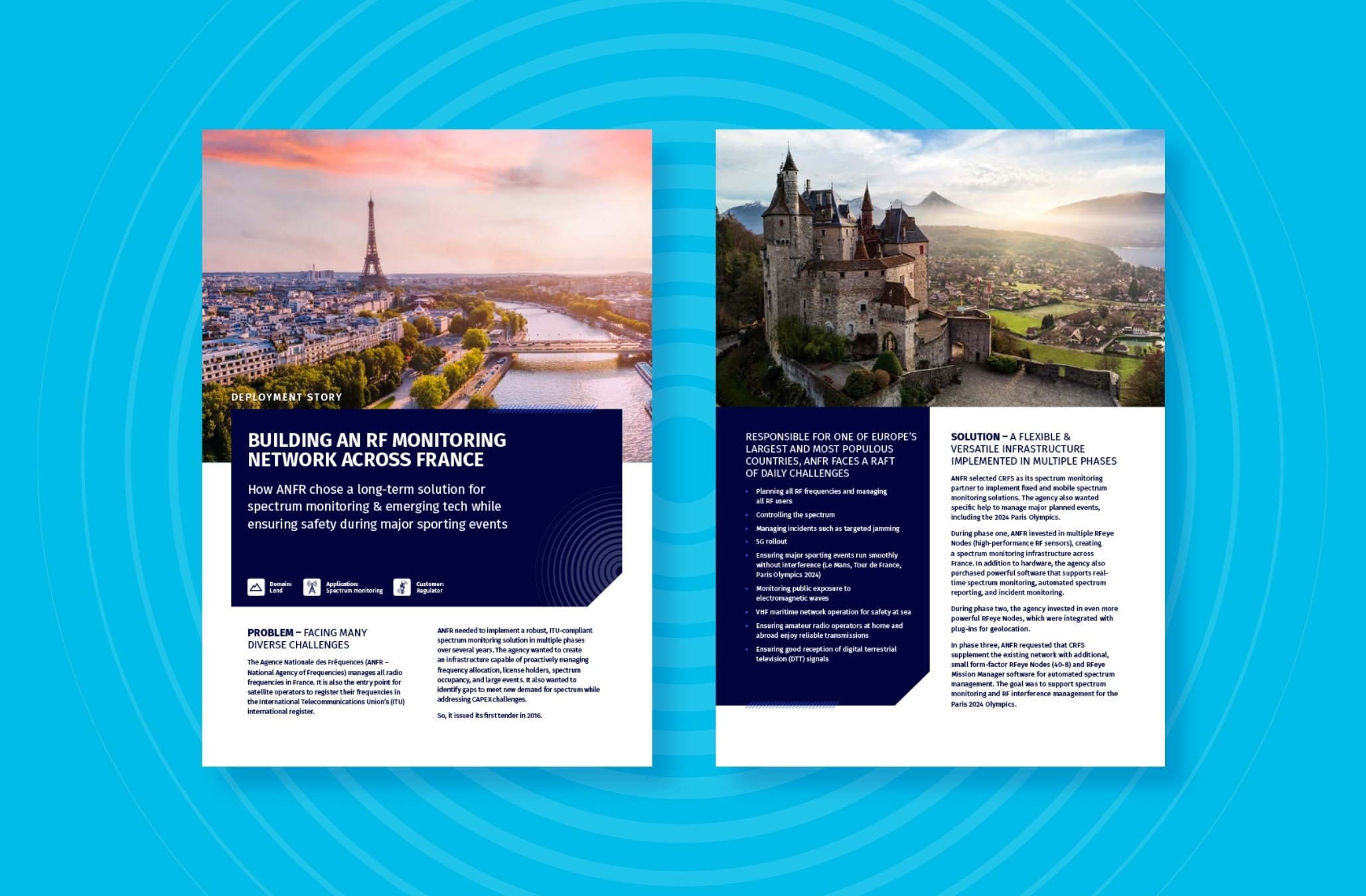 Deployment story
Deployment story
Building an RF monitoring network across France
How ANFR chose a long-term solution for spectrum monitoring & emerging tech while ensuring safety during major sporting events.
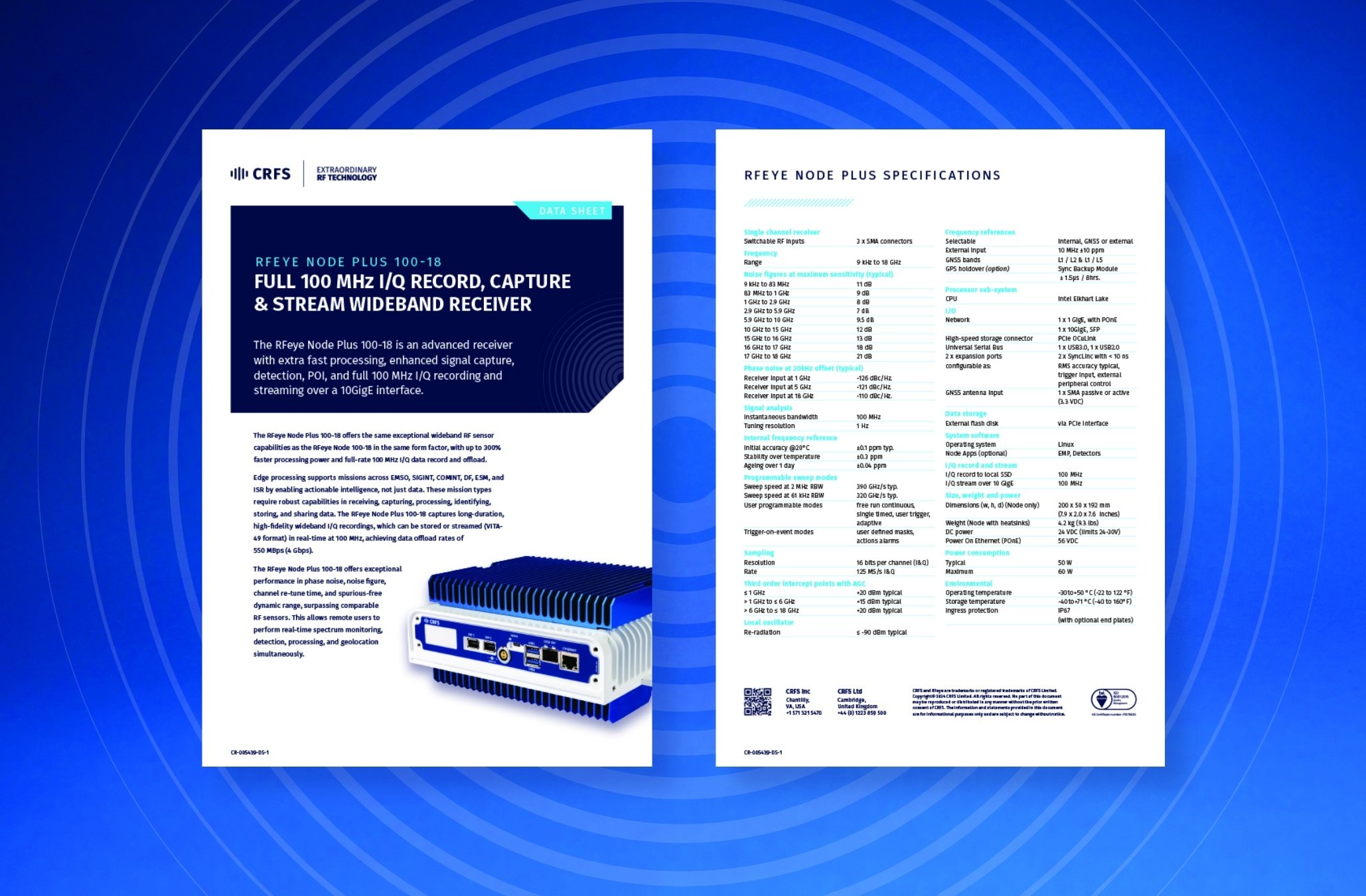 Data sheet
Data sheet
RFeye Node Plus 100-18
The RFeye Node Plus 100-18 is an advanced receiver with extra fast processing, enhanced signal capture, detection, POI, and full 100 MHz I/Q recording and streaming over a 10GigE interface.
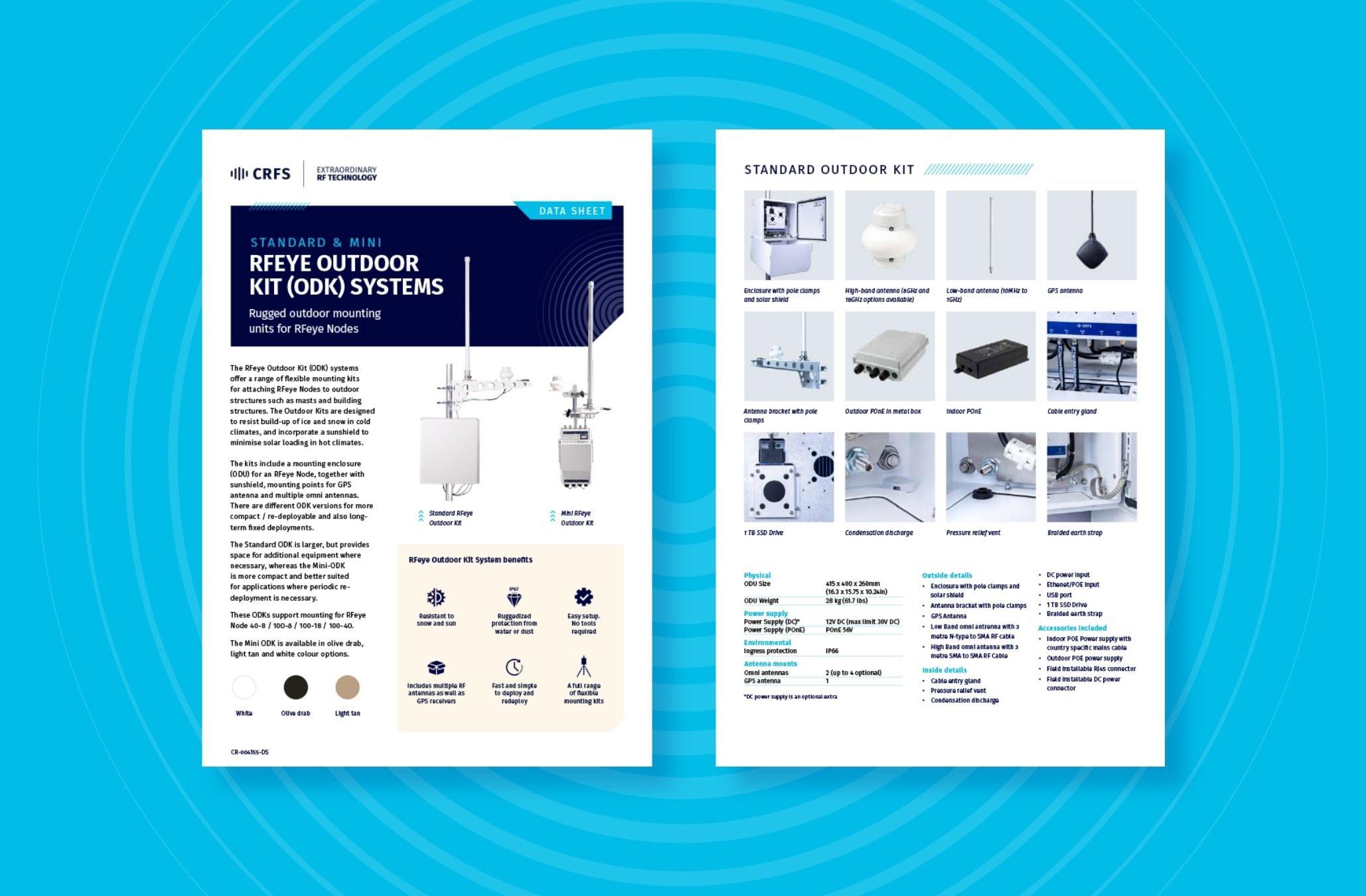 Data sheet
Data sheet
RFeye Outdoor Kit (ODK) Systems
The RFeye Outdoor Kit (ODK) systems offer a range of flexible mounting kits for attaching RFeye Nodes to outdoor structures such as masts and building structures. The Outdoor Kits are designed to resist build-up of ice and snow in cold climates, and incorporate a sunshield to minimise solar loading in hot climates.
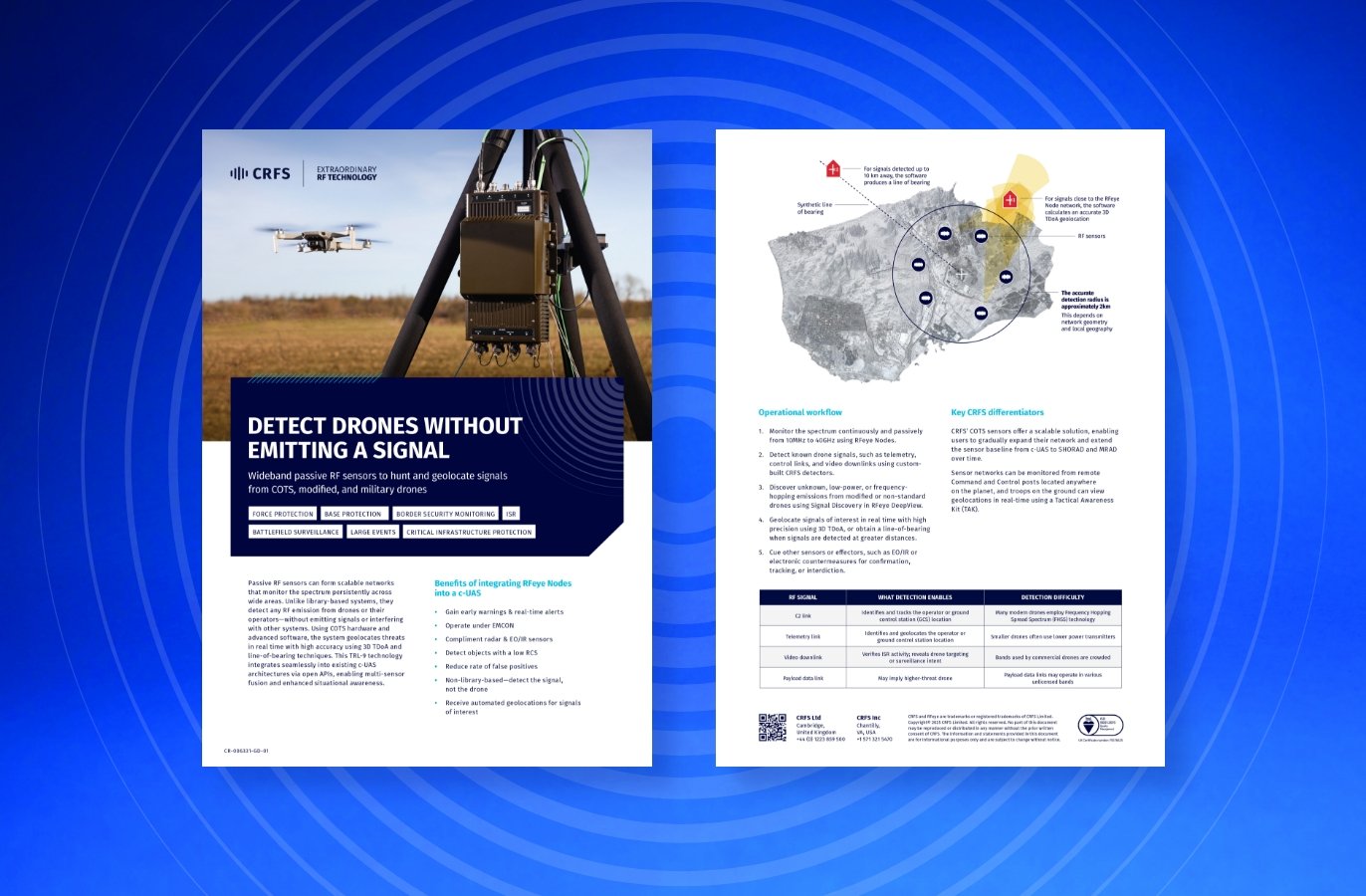 Brochures, Guides & Survey's
Brochures, Guides & Survey's
Detect drones without emitting a signal
Wideband passive RF sensors to hunt and geolocate signals from COTS, modified, and military drones.